
The Project Gutenberg EBook of Four American Naval Heroes, by Mabel Beebe
This eBook is for the use of anyone anywhere at no cost and with
almost no restrictions whatsoever. You may copy it, give it away or
re-use it under the terms of the Project Gutenberg License included
with this eBook or online at www.gutenberg.org
Title: Four American Naval Heroes
Paul Jones, Admiral Farragut, Oliver H. Perry, Admiral Dewey
Author: Mabel Beebe
Commentator: James Baldwin
Release Date: July 2, 2011 [EBook #36581]
Language: English
Character set encoding: ISO-8859-1
*** START OF THIS PROJECT GUTENBERG EBOOK FOUR AMERICAN NAVAL HEROES ***
Produced by Heather Clark, paksenarrion and the Online
Distributed Proofreading Team at http://www.pgdp.net (This
book was produced from scanned images of public domain
material from the Google Print project.)
Paul Jones
Oliver H. Perry
Admiral Farragut
Admiral Dewey
A BOOK FOR YOUNG AMERICANS
By MABEL BORTON BEEBE
WITH AN INTRODUCTION BY JAMES BALDWIN

WERNER SCHOOL BOOK COMPANY
NEW YORK CHICAGO BOSTON
Four times in the history of our country has the American navy achieved renown and won the gratitude of the nation. These four times correspond, of course, to the four great wars that we have had; and with the mention of each the name of a famous hero of the sea is at once brought to mind. What would the Revolution have been without its Paul Jones; or the War of 1812, without its Perry? How differently might the Civil War have ended but for its Farragut; and the Spanish War, but for its Dewey! The story of the achievements of these four men covers a large part of our naval history.
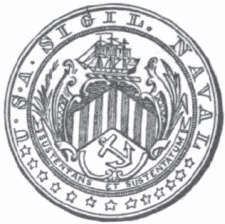 SEAL OF THE U.S. NAVY.
SEAL OF THE U.S. NAVY.
Six months after the battle of Lexington the Continental Congress decided to raise and equip a fleet to help carry on the war against England. Before the end of the year (1775) seventeen vessels were ready for service, and it was then that Paul Jones began his public career. Many other ships were soon added.
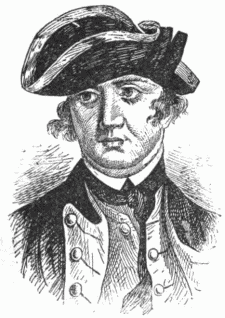 EZEK HOPKINS.
EZEK HOPKINS.
The building and equipping of this first navy was largely intrusted to Ezek Hopkins, whom Congress had appointed Commander-in-Chief, but it does not seem that he did all [Pg 4] that was expected of him, for within less than two years he was dismissed. He was the only person who ever held the title of Commander-in-Chief of the navy. During the war several other vessels were added to the fleet, and over 800 prizes were captured from the British. But before peace was declared twenty-four of our ships had been taken by the enemy, others had been wrecked in storms, and nearly all the rest were disabled. There was no effort to build other vessels, and so, for many years, our country had no navy.
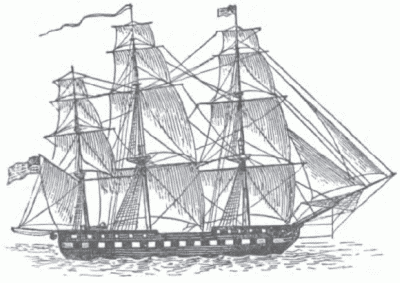 THE FRIGATE CONSTITUTION.
THE FRIGATE CONSTITUTION.
In 1794, when war with the Barbary States was expected, Congress ordered the building of six large frigates. One of these was the famous Constitution, which is still in existence and about which Dr. Holmes wrote the well-known poem called "Old Ironsides."[Pg 5] Through all the earlier years of our history, John Adams used his influence to strengthen our power on the sea; and he was so far successful that he has often been called "The Father of the American Navy." When the War of 1812 began the United States owned a great many gunboats for coast defense, besides seventeen sea-going vessels. It was during this war that the navy especially distinguished itself, and Oliver Hazard Perry made his name famous.
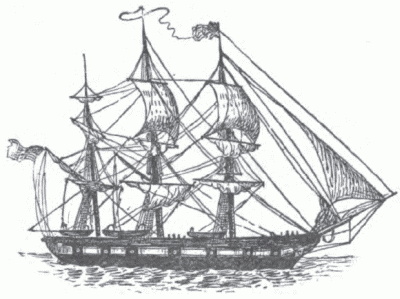 A SLOOP OF WAR.
A SLOOP OF WAR.
The ships of war in those earlier times were wooden sailing vessels, and they were very slow-goers when compared with the swift cruisers which sail the ocean now. The largest of these vessels were called ships of the line, because they formed the line of battle in any general fight at sea. They usually had three decks, with guns on every deck. The upper deck was often covered over, and on the open deck thus formed above there was a fourth tier of guns. This open deck was called the forecastle and quarter-deck. Some of the largest ships of the line carried as many as 120 guns each; the smallest was built to carry 72 guns.[Pg 6]
Next in size to these ships were the frigates. A frigate had only one covered deck and the open forecastle and quarter-deck above it, and therefore had but two tiers of guns. The largest frigate carried sixty guns, besides a large pivot gun at the bow. The American frigates were noted for their speed.
Still smaller than the frigates were the corvettes, or sloops of war, as they are more commonly called. These had but one tier of guns, and that was on the open deck. They were rigged like the larger vessels, with three masts and square sails.
 THE STEAM FRIGATE POWHATAN.
THE STEAM FRIGATE POWHATAN.
The fourth class of vessels included the brigs of war, which had but two masts and carried from six to twenty guns. Equal to them in size were the schooners, which also had two masts, but were rigged fore-and-aft. The guns which they carried were commonly much smaller than those on the sloops and frigates.
After Robert Fulton's invention of the steamboat in 1807 there were many attempts to apply steam on vessels of war. But it was a long time before these attempts were [Pg 7] very successful. The earliest war steamships were driven by paddle-wheels, placed at the sides of the vessels. The paddles, besides taking up much valuable space, were exposed to the shots of the enemy, and in any battle were very easily crippled and made useless. But the speed of these vessels was much greater than that of any sailing ship, and this alone made them very desirable. For many years steam frigates were the most formidable vessels in the navy. The first successful steamship of war was the English frigate Penelope, which was built in 1843, and carried forty-six guns. One of the earliest and most noted American vessels of the same type was the Powhatan. The first screw line of battle ship was built by the French in 1849. It was called the Napoleon, and carried one hundred guns. It was so successful that steamships soon began to take the place of sailing vessels in all the navies of the world.
 THE MERRIMAC AND THE MONITOR.
THE MERRIMAC AND THE MONITOR.
Up to this time all war vessels were built of wood; but [Pg 8] there had been many experiments to learn whether they might not be protected by iron plating. The first iron-clad ship was built in France in 1858; and not long after that Great Britain added to her navy an entire fleet of iron-clads. All these were built after the same pattern as wooden ships, and were simply covered or protected with iron plates.
 THE BATTLESHIP OREGON.
THE BATTLESHIP OREGON.
The first iron-clads used in our own navy were built soon after the beginning of the Civil War (1861), and were designed for use on the large rivers and along the coast. They were called "turtle-backs," and were simply large steamboats covered with thick slabs of iron and carrying thirteen guns each. The iron slabs were joined closely together and laid in such a manner as to inclose the decks with sloping sides and roofs. The first great deviation from old patterns was the Monitor, built by John Ericsson in 1862. She was the strangest looking craft that had ever been seen, and has been likened to a big washtub turned upside down and floating on the water. The Merrimac, which she defeated in Hampton Roads, was a wooden frigate which the Confederates had made into an iron-clad by covering her with railroad rails. They had also, by giving her an iron prow, converted her into a ram. These [Pg 9] two vessels, the Monitor and the Merrimac, were indirectly the cause of a great revolution in naval warfare; they were the forerunners of all the modern ships of war now in existence. The nations of the world saw at once that there would be no more use for ships of the line and wooden frigates and sloops of war.
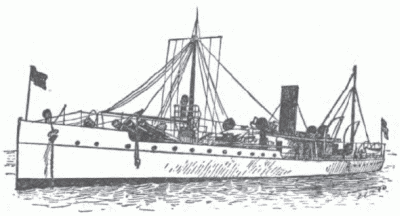 THE DYNAMITE CRUISER VESUVIUS.
THE DYNAMITE CRUISER VESUVIUS.
The ships that have been built since that time are entirely unlike those with which Paul Jones and Commodore Perry and Admiral Farragut won their great victories. The largest and most formidable of the new vessels are known as battleships, and may be briefly described as floating forts, built of steel and armed with powerful guns. These are named after the states, as the Oregon, the Texas, and the Iowa. Next to them in importance are the great monitors, such as the Monadnock and the Monterey. These are slow sailers but terrible fighters, and are intended chiefly for harbor defense. The cruisers, which rank next, are smaller than battleships and are not so heavily armed; but they are built for speed, and their swiftness makes up for their lack of strength. Among the most noted of these are the Brooklyn, the Columbia, and the Minneapolis. There [Pg 10] are also smaller cruisers, such as the Cincinnati and the Raleigh, that are intended rather for scout duty than for service in battle. Most of the cruisers are named after cities. One of the strangest vessels in the navy is the dynamite cruiser Vesuvius, which is armed with terrible dynamite guns. Then there is the ram Katahdin. She carries no heavy guns, and her only weapon of offense is a powerful ram. Her speed is greater than that of most battleships, and she is protected by a covering of the heaviest steel armor. Besides all these there are a number of smaller vessels, such as torpedo boats and tugs.
A few old-fashioned wooden vessels—steam frigates and sailing vessels—are still to be found in our navy yards, but these would be of no use in a battle.
In reading of the exploits of our great naval heroes it is well to keep in mind these wonderful changes that have taken place in the navy. Think of the slow-going wooden frigates which sailed the seas in the time of Paul Jones or Commodore Perry—how small and insignificant they would be if placed side by side with the tremendous Oregon or with the cruisers which Admiral Dewey led to victory in the Bay of Manila! But if the glory of an achievement is measured by the difficulties that are encountered and overcome, to whom shall we award the greater honor—to our earlier heroes, or to our later?
James Baldwin.
[Pg 11]
| CHAPTER | PAGE | ||
| Introduction | 3 | ||
| THE STORY OF PAUL JONES | |||
| I. | The Little Scotch Lad. | 17 | |
| II. | The Young Sailor. | 20 | |
| III. | The Beginning of the American Revolution. | 23 | |
| IV. | Lieutenant Paul Jones. | 26 | |
| V. | The Cruise of the Alfred. | 29 | |
| VI. | Captain Paul Jones. | 32 | |
| VII. | The Cruise of the Ranger. | 35 | |
| VIII. | The Ranger and the Drake. | 41 | |
| IX. | The Bon Homme Richard. | 45 | |
| X. | The Great Fight with the Serapis. | 49 | |
| XI. | Honor to the Hero. | 57 | |
| XII. | The Return to America. | 61 | |
| XIII. | Ambitious Hopes. | 63 | |
| XIV. | Sad Disappointments. | 66 | |
| THE STORY OF OLIVER H. PERRY | |||
| I. | How the Perry Family Came to Rhode Island. | 71 | |
| II. | School Days. | 75 | |
| III. | Plans for the Future. | 81 | |
| IV. | The Cruise in the West Indies. | 83 | |
| V. | The War with the Barbary States. | 87 | |
| VI. | More Trouble with England. | 94 | |
| VII. | War on the Canadian Border. | 100 | |
| VIII. | Oliver Perry Builds a Fleet. | 105 | |
| IX. | "We Have Met the Enemy and They are Ours." | 110 | |
| X. | What Perry's Victory Accomplished. | 117 | |
| XI. | On the Mediterranean again. | 122 | |
| XII. | Captain Perry's Last Cruise. | 126 | |
| THE STORY OF ADMIRAL FARRAGUT | |||
| I. | Childhood. | 133 | |
| II. | The Little Midshipman. | 138 | |
| III. | The Loss of the Essex. | 144 | |
| IV. | The Trip on the Mediterranean. | 147 | |
| V. | War with the Pirates. | 150 | |
| VI. | From Lieutenant to Captain. | 155 | |
| VII. | The Question of Allegiance. | 162 | |
| VIII. | The Capture of New Orleans. | 168 | |
| IX. | The Battle of Mobile Bay. | 177 | |
| X. | Well-Earned Laurels. | 186 | |
| THE STORY OF ADMIRAL DEWEY | |||
| Foreword—Causes of the War with Spain. | 195 | ||
| I. | The Battle of Manila. | 201 | |
| II. | The Boyhood of George Dewey. | 207 | |
| III. | Dewey as a Naval Cadet. | 210 | |
| IV. | From Lieutenant to Commodore. | 212 | |
| V. | The American Navy in Cuban Waters. | 217 | |
| VI. | The Cruise of the Oregon. | 221 | |
| VII. | Lieutenant Hobson and the Merrimac. | 225 | |
| VIII. | The Destruction of Cervera's Fleet. | 230 | |
| IX. | The End of the War. | 236 | |
| X. | Life on an American Man-of-War. | 242 | |
| XI. | Some Facts about the Navy of 1898. | 247 | |
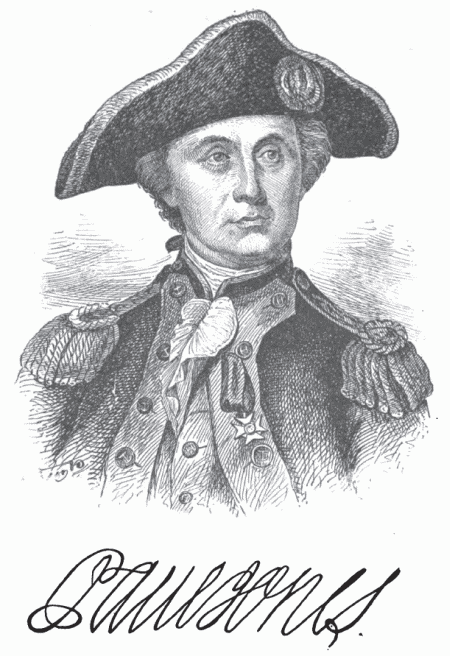 Paul Jones.
Paul Jones.
Many years ago there lived, in the southwestern part of Scotland, on the beautiful bay called Solway Firth, a gentleman whose name was Mr. Craik. In Scotland, a large farm is called an estate. Mr. Craik named his estate Arbigland.
His large house stood high on the shore overlooking the sea. The lawn sloped gradually to the firth.
Mr. Craik's gardener, John Paul, lived in a cottage on the estate. Mr. Craik was very fond of John Paul, for he worked well. He made the grounds like a beautiful park, and planted many trees, some of which are still standing.
One day John Paul married Jean Macduff. She was the daughter of a neighboring farmer. She and John lived very happily in their little [Pg 18] cottage. They had seven children. The fifth child was a boy, named for his father, John Paul. He was born July 6, 1747.
When little John was large enough to run about he liked to play on the beautiful lawn and to wander along the shore of the firth. Sometimes he would sit still for hours watching the waves.
Sometimes he and Mr. Craik's little boy would play with tiny sailboats and paddle about in the water. When they grew tired of this, they would climb among the rocks on the mountains which were back of the estate.
When there were storms at sea, vessels would come into Solway Firth for a safe harbor. The water was very deep near the shore. Because of this the ships could come so near the lawn of Arbigland that their masts seemed to touch the overhanging trees.
Little John Paul and his playmates liked to watch the sailors, and sometimes could even talk to them. They heard many wonderful stories of a land called America, where grew the tobacco that was packed in some of the ships. [Pg 19]
The children would often take their little sailboats to some inlet, where they would play sailor. John Paul was always the captain. He had listened carefully to the commands given by the captains of the large vessels. These he would repeat correctly and with great dignity, though he did not always understand them.
John Paul spent more time in this kind of play than in going to school. In those days there were few schools, and book-learning was not thought to be of much use. At a parish school near by, John learned to spell and to repeat the rules of grammar.
When he was twelve years old he felt that the time had come when he could be a real sailor. So his father allowed him to go across the firth to an English town called Whitehaven. There he was apprenticed to Mr. Younger, a merchant, who owned a ship and traded in goods brought from foreign lands.
He soon went to sea in Mr. Younger's vessel, the Friendship. This ship was bound for America to get tobacco from the Virginia fields. [Pg 20]
At that time the trip across the Atlantic could not be made as quickly as now. There were no steamships, and the sailing vessels had, of course, to depend upon the wind to carry them to their destination. It was several months before the Friendship anchored at the mouth of the Rappahannock River.
Farther inland, on this river, was the town of Fredericksburg. John Paul's eldest brother, William, lived there. He had left his Scottish home many years before, and had come with his wife to Virginia. Here he was now living on his own plantation, where he raised tobacco for the English market.
While the Friendship was in port being loaded for its return voyage, John Paul went to Fredericksburg to stay with his brother. While there he spent the most of his time in hard study. Although he was still young, he had found that he could not succeed as he wished with so little education.
It was during these months in America that he [Pg 21] formed the habit of study. All through the remainder of his life his leisure time was given to the reading of books.
After he returned to Scotland he spent six years in the employ of Mr. Younger. During that time he learned a great deal about good seamanship.
When John Paul was nineteen years of age, the loss of money compelled Mr. Younger to give up his business.
John Paul was soon afterward made mate on a slaver called the Two Friends. This was a vessel whose sole business was the carrying of slaves from Africa to America and other countries.
People at that time did not think there was any wrong in slave-trading. It was a very profitable business. Even the sailors made more money than did those on vessels engaged in any other business.
The Two Friends carried a cargo of slaves to Jamaica, an English possession in the West Indies. As soon as port was reached, John Paul left the vessel. He said that he would never again sail on a slave-trading voyage. He could not endure to [Pg 22] see men and women treated so cruelly, and bought and sold like cattle.
He sailed for home as a passenger on board a small trading vessel. On the voyage both the captain and the mate died of fever, and the ship with all its passengers was in mid-ocean with no one to command.
John Paul took the captain's place, for no one else knew so much about seamanship. This was a daring thing for one so young, as he was not yet twenty years old.
When he brought the vessel safely into port, the owners were so grateful to him that they made him the captain.
Soon afterward he sailed for the West Indies. The carpenter on board was, one day, very disrespectful to the young captain. He was punished by a flogging, and was discharged. Not long after this he died of a fever.
The enemies of John Paul, who were jealous of him, thought this was their chance to do him harm. They said that the flogging had killed the carpenter. [Pg 23]
Many people believed this, and when John Paul again returned to Scotland, he found that his friends had lost their faith in him.
During the next two years he made several voyages, but all the while he remembered the injustice done to him. He finally succeeded, however, in proving to his friends that he was worthy of their confidence.
When John Paul visited his brother in Virginia, America was not much like what it is now. Most of the country was an unexplored wilderness, and there was no United States as we know it to-day.
Some large settlements, known as colonies, had been made in that part of the country which lies between the Atlantic Ocean and the Alleghany Mountains.
Most of the people who lived in these colonies were English, and their governors were appointed by the king of England. [Pg 24]
Each governor, with the help of a few men whom he chose from the people, would make laws for the colony.
Not all the laws were made in this way. Sometimes the king, without caring for the wishes of the colonists, would make laws to suit himself.
Up to this time the people had been obedient and loyal to their king. But when George the Third came to the throne of England, he caused the people a great deal of trouble.
He sent orders to the governors that the colonists should trade with no other country than his own.
All their goods should be bought in England, and, to pay for them, they must send to the same country all the corn, cotton, and tobacco which they had to sell. The colonists wished to build factories and weave their own cloth, but the king would not allow this.
For a long while England had been at war with France. King George said that the colonists should help pay the expenses of that war, and therefore he began to tax them heavily. [Pg 25]
They were obliged to pay a tax on every pound of tea, and stamped paper must be bought for every legal document.
The colonists were much aroused on account of the tea tax and the stamp act, as it was called.
One day startling news came to John Paul in Virginia. A shipload of tea had anchored in Boston harbor. The colonists declared that they would not pay the tax on this tea, and some of them, dressed as Indians, had gone on board the vessel and thrown it all into the harbor.
Later on, came the news that the king had sent his English soldiers to Boston to keep the people quiet. He had also closed the port of Boston and said that no more ships should come in or go out. This aroused the whole country. Everybody felt that something must be done to preserve the freedom of the people.
Each colony chose men as delegates to confer together about what was best to be done. The delegates met in Philadelphia on the 5th of September, 1774. That meeting has since been called the First Continental Congress of America. [Pg 26]
The delegates of the colonies decided to send a petition to the king asking that he would remove the taxes and not make unjust laws.
All winter the people waited for an answer, but as none came, matters grew worse in the spring.
On the 19th of April, 1775, a battle was fought with the king's soldiers at Lexington, in Massachusetts. This was the first battle of the American Revolution.
In the year 1773, soon after the trouble with England had begun, John Paul's brother William died in Virginia. He left some money and his plantation, but had made no will to say who should have them. He had no children, and his wife had been dead for years.
His father had died the year before, and John was the only one of the family now living who could manage the estate.
So he left the sea and went to live on the farm near Fredericksburg, in Virginia. He thought that [Pg 27] he would spend the rest of his life in the quiet country, and never return to the sea.
He soon learned to love America very dearly, even more than he did his own country. He wanted to see the colonists win in their struggle for their rights.
But so good a sailor could not be a good farmer. In two years the farm was in a bad condition and all the money left by his brother had been spent. The agents in Scotland, with whom John Paul had left money for the care of his mother and sisters, had proved to be dishonest, and this money also had been lost.
In the midst of these perplexities, he decided to serve America in the war which every one saw was now inevitable.
Another congress of delegates from the colonies met in 1775, and made preparations for that war. The colonists were organized into an army, with George Washington as the commander in chief.
A fleet of English vessels had been sent across the Atlantic. The swiftest of these sailed up and down the Atlantic coast, forcing the people in the [Pg 28] towns to give provisions to the king's sailors and soldiers. Other vessels were constantly coming over, loaded with arms and ammunition for the English soldiers.
George Washington's army was almost without ammunition. There was very little gunpowder made in this country at that time, and the need of it was very great.
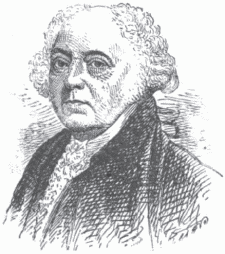 JOHN ADAMS.
JOHN ADAMS.
It was thought that the best way to supply the American army with ammunition was to capture the English vessels. It was for this purpose that the first American navy was organized.
The first navy yard was established at Plymouth. Here a few schooners and merchant vessels were equipped with cannon as warships. These were manned by bold, brave men, who, since boyhood, had been on the sea in fishing or trading vessels. [Pg 29]
No member of the Continental Congress did more to strengthen and enlarge this first navy than John Adams.
In 1775 John Paul settled up his affairs, left the Virginia farm, and went to Philadelphia to offer his services to the naval committee of Congress.
He gave his name as John Paul Jones. Just why he did this, we do not know. Perhaps he did not wish his friends in Scotland to know that he had taken up arms against his native country.
Perhaps he thought that, should he ever be captured by the English, it would go harder with him if they should know his English name. We cannot tell. Hereafter we shall call him Paul Jones, as this is the name by which he was known during the rest of his life.
Congress accepted his offer and he was made first lieutenant on the Alfred, a flag-ship.
The young lieutenant was now twenty-nine years old. His health was excellent and he could [Pg 30] endure great fatigue. His figure was light, graceful, and active. His face was stern and his manner was soldierly. He was a fine seaman and familiar with armed vessels.
He knew that the men placed above him in the navy had had less experience than he. But he took the position given him without complaint.
When the commander of the Alfred came on board, Paul Jones hoisted the American flag. This was the first time a flag of our own had ever been raised.
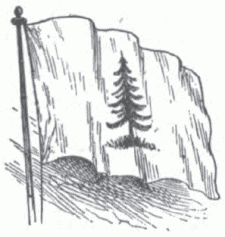 THE PINE TREE FLAG.
THE PINE TREE FLAG.
We do not know just what this flag was like, but some of the earliest naval flags bore the picture of a pine tree; others had a rattlesnake stretched across the stripes, and the words, "Don't tread on me." Our present flag was not adopted until two years later.
On the 17th of February, 1776, the first American squadron sailed for the Bahama Islands.
On the way, two British sloops were captured. The English sailors told the Americans that on the [Pg 31] island of New Providence were forts, which contained a large amount of military supplies. They said that these forts could easily be taken.
The soldiers on a vessel are called marines. A plan was made to hide the American marines in the British sloops. In that way it was thought they could go safely into the harbor of New Providence. Then they could land and take possession of the forts.
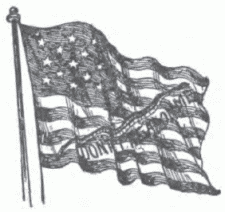 THE RATTLESNAKE FLAG.
THE RATTLESNAKE FLAG.
This plan would have been successful, but for one foolish mistake. The squadron sailed so close to the harbor during the night that in the morning all the ships could be seen from the shore. The war vessels should have remained out of sight until the marines had been safely landed from the sloops. The alarm was spread, and the sloops were not allowed to cross the bar.
The commander of the squadron then planned to land on the opposite side of the island and take the forts from the rear, but Paul Jones told him he could not do this. There was no [Pg 32] place to anchor the squadron, and no road to the forts.
However, he had learned from the pilots of a good landing not far from the harbor. When he told the commander of this, he was only rebuked for confiding in pilots.
So Paul Jones undertook, alone, to conduct the Alfred to the landing he had found. He succeeded in doing this and the whole squadron afterwards followed.
The English soldiers abandoned the forts, and the squadron sailed away the same day, carrying a hundred cannon and other military stores.
A short time after this, the American squadron tried to capture a British ship called the Glasgow, but the attempt was not successful.
Because of this failure, one of the captains was dismissed from the navy, and the command of his vessel was given to Lieutenant Jones. This vessel was named the Providence. [Pg 33]
With it and the Alfred, which he also commanded, Captain Jones captured sixteen prizes in six weeks. Among them were cargoes of coal and dry goods.
Best of all, he captured an English vessel bound for Canada, full of warm clothing for the British soldiers. This was a prize that proved of great value to General Washington's poorly clothed army.
In those days there were selfish people just as now. In January, 1777, a jealous commodore succeeded in depriving Paul Jones of his position as captain. He was now without ship or rank. When he appealed to Congress he was put off with promises from time to time. It was not until May that his petitions were heard.
There were three new ships being built for the navy at Boston. Congress gave him permission to choose one of these and have it fitted out as he wished.
While waiting in Boston for these ships to be finished, Paul Jones wrote many wise suggestions about the management of the navy. Congress at [Pg 34] first paid but little attention to these suggestions, but was afterwards glad to act upon them.
These were some of the things he said:
"1. Every officer should be examined before he receives his commission.
"2. The ranks in a navy should correspond to those in an army.
"3. As England has the best navy in the world, we should copy hers."
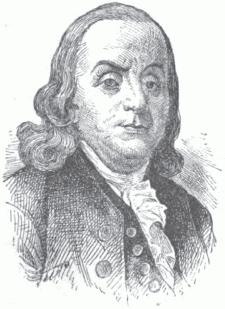 BENJAMIN FRANKLIN.
BENJAMIN FRANKLIN.
Before the ship he had chosen was completed, he was ordered to wait no longer in Boston, but to take the Ranger, an old vessel, and sail at once for France. Through the efforts of Benjamin Franklin, the American Minister to France, the French king had acknowledged the independence of the colonies, and was ready to aid the Americans in the war.
Paul Jones was to carry a letter from Congress to the American commissioners in Paris. [Pg 35]
This letter told the commissioners to buy a new fast-sailing frigate for Captain Jones, and to have it fitted up as he desired. They were then to advise him as to what he should do with it.
When the Ranger sailed out of Boston harbor, the stars and stripes of the American republic waved from the mast head.
Paul Jones was the first naval officer to raise this flag. You remember that two years before, on the Alfred, he had first hoisted the pine tree emblem.
When Jones with his ship entered Quiberon Bay, in France, the French admiral there saluted the American flag. This was the first time that a foreign country had recognized America as an independent nation.
Paul Jones anchored the Ranger at Brest and went to Paris to deliver his letter, and lay his plans before the commissioners. He told them two important things: [Pg 36]
First, that our navy was too small to win in open battle with the fleets of the English.
Second, that the way to keep the English vessels from burning, destroying, and carrying away property on the American coasts, was to send vessels to the English coasts to annoy the English in the same way.
The commissioners thought that these plans should be carried out at once; and since a new frigate could not be purchased for some time, they refitted the Ranger for his use.
On April 10, 1778, Paul Jones set out on what proved to be a memorable cruise.
You remember that when he first went to sea, as a boy, he sailed from Whitehaven. This town is on the English coast, just across the Solway Firth from John Paul's old home.
He knew there were large shipping yards there, and he determined to set fire to them. He planned to reach the harbor in the night, and burn the ships while the people were asleep.
Because of the wind and tides, it was nearly midnight when he arrived. He found three [Pg 37] hundred vessels of different kinds lying in the harbor. His men were put into two small boats, and each boat was ordered to set fire to half the ships.
It was nearly daylight when they rowed away from the Ranger. Nothing could be heard but the splashing of their oars. Their flickering torches showed to them the old sleeping town, with the many white ships along the shore.
Leaving orders that the fire be speedily kindled, Captain Jones took with him a few men, and scaled the walls of the batteries which protected the harbor. He locked the sleeping sentinels in the guardhouse and spiked the cannon.
Then, sending his men back to the harbor, he went, with one man only, to another fort, which was a quarter of a mile away. Here he also spiked the guns.
After all this had been done he returned to his boats to find that his sailors had done nothing. Not one ship was on fire!
The lieutenant in charge told Paul Jones that their torches had gone out. "Anyway," he said, [Pg 38] "nothing can be gained by burning poor people's property."
Determined that they should not leave the harbor until something was destroyed, Paul Jones ran to a neighboring house and got a light. With this he set fire to the largest ship.
By this time the people had been aroused, and hundreds were running to the shore.
There was no time to do more. The sailors hastened back to the Ranger, taking with them three prisoners, whom Paul Jones said he would show as "samples."
The soldiers tried to shoot the sailors from the forts; but they could do nothing with the spiked guns. The sailors amused themselves by firing back pistol shots.
On reaching the ship they found that a man was missing. Paul Jones was afraid that harm had befallen him. He need not have been troubled, however, for the man was a deserter. He spread the alarm for miles along the shore. The people afterward called him the "Savior of Whitehaven."
Paul Jones was greatly disappointed by the failure [Pg 39] of his plans. He knew that if he had reached the harbor a few hours earlier he could have burned, not only all the ships, but the entire town.
Although the plan to destroy English property to aid the American cause, was a wise one, from a military point of view, yet we cannot understand why Paul Jones should have selected Whitehaven for this destruction. There he had received kindness and employment when a boy. His mother and sisters lived just across the bay, and had he succeeded in burning Whitehaven, the people, in their anger, might have injured the family of the man who had so cruelly harmed them. We wonder if he thought of these things.
The Earl of Selkirk lived near Whitehaven, on St. Mary's Isle. As the Ranger sailed by this island, Paul Jones thought it would be well to take the earl prisoner.
There were many Americans held as prisoners, by the English, and the earl could be exchanged for some of these.
So, with a few men, Paul Jones rowed to the shore, where some fishermen told him that the earl [Pg 40] was away from home. Paul Jones started to go back to his vessel. But his sailors were disappointed and asked his permission to go to the earl's house and take away the silver.
Paul Jones did not like this plan, but at last consented. He did not go with the men, however, but walked up and down the shore until they returned.
The sailors found Lady Selkirk and her family at breakfast. They took all the silver from the table, put it into a bag, and returned to the ship.
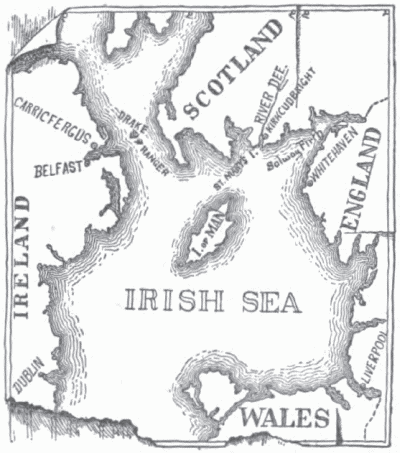 MAP OF THE IRISH SEA, SHOWING THE CRUISE OF THE RANGER.
MAP OF THE IRISH SEA, SHOWING THE CRUISE OF THE RANGER.
Paul Jones was always troubled about this. He afterwards bought the silver for a large sum of money, and sent it back to Lady Selkirk with a letter of apology.
The people in the neighborhood were frightened when they heard of the earl's silver being taken. [Pg 41] They ran here and there, hiding their valuables. Some of them dragged a cannon to the shore, and spent a night firing at what they supposed in the darkness to be Paul Jones' vessel. In the morning they found they had wasted all their powder on a rock!
The next day the alarm was carried to all the towns along the shore: "Beware of Paul Jones, the pirate!"
An English naval vessel called the Drake was sent out to capture the Ranger. Every one felt sure that she would be successful, and five boatloads of men went out with her to see the fight.
When the Drake came alongside of the Ranger, she hailed and asked what ship it was. Paul Jones replied: "The American Continental ship Ranger! Come on! We are waiting for you!"
After a battle of one hour, the Drake surrendered. The captain and forty-two men had been killed, and the vessel was badly injured. Paul [Pg 42] Jones lost only his lieutenant and one seaman. Six others were wounded, one of whom died.
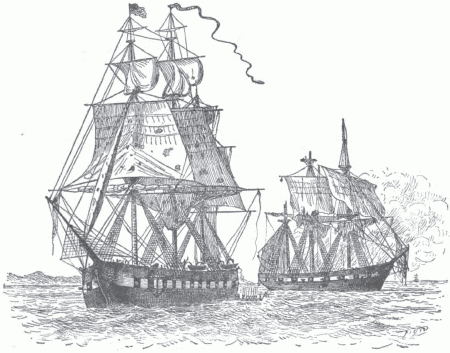 THE RANGER AND THE DRAKE.
THE RANGER AND THE DRAKE.
This was a great victory for Paul Jones. The Drake not only mounted two more guns than the Ranger, but was manned by a crew that was much better drilled. The vessel belonged to the well-established English navy, which was accustomed to victory on the seas. [Pg 43]
Towing the Drake, Paul Jones sailed northward in safety. Then, leaving the Irish Sea, he sailed around the north coast of Ireland and returned to the harbor at Brest, with the Drake and two hundred prisoners. This was just a month from the day he had set out on his cruise.
The French government had now concluded an alliance with the American republic. War had been openly declared between France and England, and all the French people rejoiced over the victory of the Ranger.
Paul Jones was not sorry when Congress sent him an order to bring his vessel to America. It was needed to protect the coasts of New Jersey from the war ships of the British.
The French king did not like brave Paul Jones to return to America. He wished him to remain where he could be of more direct service to France. He therefore caused letters to be sent to him, promising that if he would stay on that side of the Atlantic he should have command of the new frigate he had wished for so long.
Pleased with the prospect of this, he gave up [Pg 44] the command of the Ranger, and it sailed to America under a new captain.
But promises are often more easily made than kept. The French navy was well supplied with ships and officers. These officers were jealous of the success of Paul Jones, and did all they could to prevent him from obtaining his commission.
The summer and most of the winter of 1778 passed away, and Paul Jones was still waiting for his ship. He began to wish he had gone to America.
Some wealthy men offered him a ship if he would take charge of a trading expedition for them. To do this, he must give up his commission in the American navy, and so Paul Jones said, "As a servant of the republic of America, I cannot serve either myself or my best friends, unless the honor of America is the first object."
During these months of waiting, his only weapon was his pen. He wrote letters of appeal to all persons of influence, to Congress, and also to the king of France. [Pg 45]

One day, when Paul Jones was reading "Poor Richard's Almanac," written by Dr. Franklin, he found a paragraph which set him to thinking. It was: "If you would have your business done, go; if not, SEND."
He sent no more letters, but went at once to the French court and pleaded his case there in person. As a result, he was soon after made commander of a vessel which he named the Bon Homme Richard, which means Poor Richard. He did this out of gratitude to Dr. Franklin. [Pg 46]
The Bon Homme Richard was an old trading vessel, poorly fitted out for war. But after his long months of waiting, Paul Jones was thankful even for this.
He was also given command of four smaller vessels. One of these, the Alliance, had, for captain, a Frenchman named Pierre Landais, who was afterwards the cause of much trouble. Paul Jones was ordered to cruise with his small squadron along the west coast of Ireland and to capture all the English merchant vessels he could find.
 RICHARD DALE.
RICHARD DALE.
The officer next in command to Paul Jones was Lieutenant Richard Dale, who has since been remembered not only for his bravery during that famous cruise, but for his service to the country at a later period.
On the 14th of August, 1779, the ships put to sea. When they reached the southern point of Ireland, [Pg 47] one of the four small vessels was left behind and deserted.
Cruising northward, the squadron soon captured two valuable prizes. Without asking the permission of Paul Jones, Captain Landais sent these captured vessels to Norway.
On the way, they were taken by the Danes, who returned them to England. The value of these prizes, thus lost through Captain Landais, was about £40,000, or nearly $200,000.
The squadron sailed round the north of Scotland, and down the eastern coast until it came to the Firth of Forth. Here was the town of Leith, and in its harbor lay some English war vessels.
Paul Jones wished to capture these. The winds were favorable, and a landing could easily have been made but for Captain Landais.
Paul Jones spent a whole night persuading this troublesome captain to help him. It was only with a promise of money that he at last succeeded. But in the morning the winds were contrary.
That day the Richard captured an English [Pg 48] merchant ship. The captain promised Paul Jones that if he would allow his vessel to go free, he would pilot the squadron into the harbor.
The people, seeing the fleet piloted by the English vessel, supposed the visit to be a friendly one. So they sent a boat out to the Richard, asking for powder and shot to defend the town from the visit of "Paul Jones the pirate."
Jones sent back a barrel of powder with the message that he had no suitable shot. It was not until the vessels were nearing the harbor that the object of the visit was suspected. The people, in their fright, ran to the house of the minister. He had helped them when in trouble at other times, and could surely do something now.
The good man, with his flock following him, ran to the beach, where he made a strange prayer.
He told the Lord that the people there were very poor, and that the wind was bringing to the shore that "vile pirate," Paul Jones, who would burn their houses and take away even their clothes. "I canna think of it! I canna think of it! I have long been a faithful servant to ye, O Lord. [Pg 49] But gin ye dinna turn the wind aboot and blaw the scoundrel out of our gates, I'll nae stir a foot, but will just sit here till the tide comes in."
Just then a violent gale sprang up, and by the time it had abated the squadron had been driven so far out to sea that the plan was given up.
Long afterward, the good minister would often say, "I prayed, but the Lord sent the wind."
Paul Jones next cruised up and down the eastern coast of England, trying to capture some merchant ships that were bound for London.
About noon, on September 23, 1779, he saw not far from the shore an English fleet, sailing from the north. It was convoyed by two new war ships, the Serapis and the Countess of Scarborough.
Paul Jones at once signaled to his ships to form in line of battle. Captain Landais disobeyed.
The sight of the American squadron seemed to cause confusion in the English fleet. They let fly [Pg 50] their top gallant sails and fired many signals. The Serapis and the Countess drew up in line of battle and waited for the enemy, while the merchant ships ran into port.
It was a clear, calm afternoon. The sea was like a polished mirror, with scarcely a ripple on its surface.
The vessels approached each other so slowly that they scarcely seemed to move. The decks had all been cleared for action, and the captains were full of impatience.
Word had gone from town to town along the shore, that a great battle was soon to be fought. The people along the shore gathered on the high cliffs, eagerly hoping to see the dreaded Paul Jones crushed forever.
The sun had gone down behind the hills before the ships were within speaking distance of each other. The harvest moon came up, full and clear, and shed a soft light over the dreadful battle that followed.
Captain Landais, when he disobeyed Paul Jones' order to join in line of battle, spread the [Pg 51] sails of the Alliance, and went quickly toward the enemy as though to make an attack. But when very near to where the Serapis lay, he changed his course, and sailed away to a place where the battle could be seen without harm.
About half-past seven in the evening, the Richard rounded to on the side of the Serapis within pistol-shot.
Captain Pearson of the Serapis hailed, saying: "What ship is that?" The answer came: "I can't hear what you say."
Captain Pearson repeated: "What ship is that? Answer at once or I shall fire."
Paul Jones' reply was a shot. This was followed by a broadside from each vessel.
At this first fire, two of the guns in the lower battery of the Richard burst. The explosion tore up the decks, and killed many men.
The two vessels now began pouring broadsides into each other. The Richard was old and rotten, and these shots caused her to leak badly. Captain Pearson saw this, and hailed, saying, "Has your ship struck?" [Pg 52]
The bold reply came: "I have not yet begun to fight."
Paul Jones saw, that, as the Serapis was so much the better ship of the two, his only hope lay in getting the vessels so close together that the men could board the Serapis from the Richard.
All this time the vessels had been sailing in the same direction, crossing and re-crossing each other's course.
Finally Paul Jones ran the Richard across the bow of the Serapis. The anchor of the Serapis caught in the stern of the Richard and became firmly fastened there. As the vessels were swung around by the tide, the sides came together. The spars and rigging were entangled and remained so until the close of the engagement.
With the muzzles of the guns almost touching, the firing began. The effect was terrible.
Paul Jones, who had only two guns that could be used on the starboard side, grappled with the Serapis. With the help of a few men, he brought over a larboard gun, and these three were all that he used during the rest of the battle. [Pg 53]
Meanwhile the other ships of the American squadron did strange things. The Pallas, alone, did her duty. In a half hour she had captured the Countess of Scarborough. The Vengeance simply sailed for the nearest harbor.
Worst of all was the conduct of Captain Landais and his ship Alliance. For a while he looked quietly on as though he were umpire. At 9:30 o'clock he came along the larboard side of the Richard so that she was between him and the enemy. Then he deliberately fired into her, killing many men.
Many voices cried out that he was firing into the wrong ship. He seemed not to hear, for, until the battle was over, his firing continued. The Poor Richard had an enemy on each side.
Paul Jones sent some men up the masts and into the rigging to throw hand-grenades, or bombs, among the enemy. One of these set fire to some cartridges on the deck of the Serapis. This caused a terrible explosion, disabling all the men at the guns in that part of the ship. Twenty of them were killed outright. [Pg 54]
By this time so much water had leaked into the Richard that she was settling. A sailor, seeing this, set up the cry: "Quarter! quarter! Our ship is sinking!"
Captain Pearson, hearing the cry, sent his men to board the Richard. Paul Jones, with a pike in his hand, headed a party of his men similarly armed, and drove the English back.
Some of the Richard's men ran below and set the prisoners free. There were more than a hundred of them.
One of these prisoners climbed through the port holes into the Serapis. He told Captain Pearson that if he would hold out a little longer, the Richard would either sink or strike.
Poor Paul Jones was now in a hard place. His ship was sinking. More than a hundred prisoners were running about the decks, and they, with the crew, were shouting for quarter. His own ship, the Alliance, was hurling shots at him from the other side. Everywhere was confusion.
But he, alone, was undismayed. He shouted to the prisoners to go below to the pumps or they [Pg 55] would be quickly drowned. He ordered the crew to their places. He himself never left the three guns that could still be fired.
At half-past ten o'clock, the Serapis surrendered.
 THE SERAPIS AND THE BON HOMME RICHARD.
THE SERAPIS AND THE BON HOMME RICHARD.
When Captain Pearson gave his sword to Paul Jones, he said it was very hard to surrender to a man who had fought "with a halter around his neck." Paul Jones replied, "Sir! You have fought like a hero. I hope your king will reward you."
This battle had lasted for three hours and a half. [Pg 56] It has since been known in history as one of the greatest victories ever won upon the seas. The Serapis and the Countess were both new ships, one of forty guns and the other of twenty. The crews were well-drilled Englishmen.
Everything was against the Richard, and the victory was due alone to the great courage and will of its commander. When the fight was over, Paul Jones separated the ships and set the sails of the Richard. All night every sailor was busy fighting the fire which raged on both ships.
When daylight showed to Captain Pearson the wreck of the Richard, he was sorry he had surrendered. Her rudder was gone and her rotten timbers were split into pieces. Some of the shots had passed entirely through her.
Paul Jones wished to take her into port to show how desperately he had fought, but this was out of the question. By nine o'clock the sailors abandoned her, and at ten she suddenly went down.
Repairing the Serapis as best he could, Paul Jones took her and the Countess of Scarborough, with his unfaithful fleet, to Holland. [Pg 57]
After this great victory, Paul Jones was everywhere received as a hero. The king of France presented him with a gold sword.
He also sent word, through his minister, that, with the consent of Congress, he would make Paul Jones a Knight of the Order of Military Merit. To avoid delay, the gold cross of the order had been sent to the French minister in America, who would present it to Paul Jones when permission to accept it had been received from Congress.
The hero traveled about in Holland and France, from city to city, enjoying his great triumph. Crowds of people were everywhere eager to see him, and a word with him was thought to be a great honor.
The most serious fault in the character of Paul Jones was his vanity. He had always been very fond of praise and glory, and now his longings were partly satisfied by all this homage.
Dr. Franklin wrote him a letter, praising him for his bravery. He thanked him, most of all, for the prisoners he had captured. There were [Pg 58] so many of them that, by exchange, every American, held by the English, could be set at liberty.
While Paul Jones was enjoying this praise, Captain Landais was going about also, claiming for himself the glory for the capture of the Serapis, and trying to make people believe that he was the real hero.
When Dr. Franklin heard from the sailors how he had fired upon the Richard, he ordered him to Paris to be tried.
During the next year, Paul Jones made a few short cruises, but accomplished nothing more than the taking of a few prizes.
At this time the army of George Washington was sorely in need of clothing and military supplies. Word was sent to Dr. Franklin to buy them in France and send them to America by Paul Jones.
Fifteen thousand muskets, with powder, and one hundred and twenty bales of cloth, were bought and stored in the Alliance and the Ariel. Dr. Franklin told Paul Jones to sail with these goods at once. This was early in the year 1780. [Pg 59]
The summer came and passed away, and the ships were still anchored in the French harbor. Paul Jones gave excuse after excuse until the patience of Dr. Franklin was about gone.
Captain Landais had been one cause of the delay. Instead of going to Paris for trial, as Franklin had ordered, he had gone back to the Alliance to stir up mutiny against Paul Jones. He caused one trouble after another and disobeyed every order. Finally, by intrigue, he took command of the Alliance and sailed to America.
But Captain Landais never again troubled Paul Jones. His reception in America was not what he had expected. Instead of being regarded as a hero, he was judged insane, and dismissed from the navy. A small share of prize money was afterward paid to him. On this he lived until eighty-seven years of age, when he died in Brooklyn, New York.
Another reason Paul Jones gave for his delay in France was that he wished to get the prize money due for the capture of the Serapis, and pay the sailors. This gave him an excuse to [Pg 60] linger about the courts where he could receive more of the homage he loved so well.
Then, too, he spent much time in getting letters and certificates of his bravery from the king and the ministers. He wished to show these to Congress when he should arrive in America.
Finally, one day in October, he set sail in the Ariel. He had not gone far when a furious gale forced him to return to port for safety.
For three months longer he waited, hoping still for the prize money that was due. One day he gave a grand fête on his ship. Flags floated from every mast. Pink silk curtains hung from awnings to the decks. These were decorated with mirrors, pictures, and flowers.
The company invited were men and women of high rank. When all was ready, Paul Jones sent his boats ashore to bring them on board.
He, himself, dressed in full uniform, received them and conducted them to their seats on the deck. At three o'clock they sat down to an elaborate dinner which lasted until sunset.
At eight o'clock, as the moon rose, a mock [Pg 61] battle of the Richard and the Serapis was given. There was much noise from the firing of guns, and a great blaze of light from the rockets that were sent up. The effect was beautiful, but the din was such that the ladies were frightened. At the end of an hour this display was ended.
After a dance on the deck, the officers rowed the company back to the shore.
On the 18th of December, 1780, nearly a year after he had received his orders, Jones sailed for America. He arrived in Philadelphia on February 18th, 1781. When Congress inquired into the cause of his long delay, he gave explanations which seemed to be satisfactory. Resolutions of thanks were passed, and permission given to the French minister to present the Cross of Military Merit, which had been sent by the French king.
This cross was presented with great ceremony, and it was ever after a source of much pride to [Pg 62] Paul Jones. He wore it upon all occasions and loved to be called Chevalier.
During the following year Paul Jones superintended the construction of a new war ship, the America, which was being built by Congress.
This was the largest seventy-four gun ship in the world, and he was to be her captain.
Once more Paul Jones was disappointed. Before the America was finished, Congress decided to give her to France. She was to replace a French vessel, which had been lost while in the American service.
Paul Jones was again without a ship. As he could not bear to be idle, he spent the time until the close of the war, with a French fleet, cruising among the West Indies.
As soon as he heard that peace was declared between England and America, he left the French fleet and returned to America. He arrived in Philadelphia in May, 1783.
Now that the war was over, and there was no more fighting to be done, Paul Jones thought that the best thing for him to do was to get the [Pg 63] prize money still due from the French government for the vessels he had captured.
For this purpose, he soon returned to France. After many delays the money, amounting to nearly $30,000, was paid to him. It was to be divided among the officers and crews of the ships which he had commanded.
Paul Jones came again to America in 1787 to attend to the final division of this money.

While in this country, Congress ordered a gold medal to be presented to him for his services during the war.
You remember that, during the war, Captain Landais had sent two valuable ships to Norway, and so caused the loss of much prize money. [Pg 64] Denmark had taken these ships, by force, and given them back to England.
Paul Jones determined to go to Denmark to try to induce that country to pay for these ships. In November, 1787, he left America for the last time.
On the way to Denmark, he stopped in Paris. Here he heard some news which pleased him very much.
For some time Russia had been at war with Turkey, and the Russian navy had lately met with several disasters on the Black Sea.
The Russian minister in Paris had heard a great deal about the hero, Paul Jones. So he sent word to the Empress Catherine, who was then the ruler of Russia, that if she would give Paul Jones the command of the Russian fleet, "all Constantinople would tremble in less than a year."
When Paul Jones heard that this message had gone to Russia, he was sure that a chance would come to win still more glory and fame.
He was more anxious than before to go to Copenhagen, the capital of Denmark. He would [Pg 65] then be nearer to Russia and could more quickly answer the summons of the empress.
He was not disappointed in this. He was in Copenhagen but a few weeks, when he received the offer of a position in the Russian navy, with the rank of rear-admiral.
He gave up the hope of the prize money, and started in April, 1788, for St. Petersburg.
The story of his trip to Russia shows what a fearless man he was. No danger was too great for him to brave, in order to accomplish any purpose he had in mind.
In order to reach St. Petersburg with the least delay, he went to Stockholm, Sweden. Here he took an open boat and crossed the Baltic Sea, which was full of floating ice.
He did not let the boatmen know of his intentions until they were well out at sea. Then, pistol in hand, he compelled the unwilling men to steer for the Russian shore.
For four days and nights they were out in the open boats, carefully steering through the ice, and many times barely escaping death. [Pg 66]
When, at last, they arrived safely at a Russian port on the Gulf of Finland, he rewarded the boatmen and gave them a new boat and provisions for their return. Scarcely would any one believe the story, as such a trip had never been made before, and was thought to be impossible.
He hurried on to St. Petersburg, where he was warmly welcomed. The story of his trip across the Baltic, added to other tales of his bravery, caused the empress to show him many favors.
After a few days in St. Petersburg, Paul Jones hurried on to the Black Sea to take command of his fleet. But he again met with disappointments. He was not given the command of the whole fleet, as he had expected. Instead, he was given only half, Prince Nassau commanding the remainder. Both of these men were under a still higher authority, Prince Potemkin.
Potemkin was as fond of glory as was Paul [Pg 67] Jones. He and Nassau were both jealous of the foreigner, and Potemkin finally succeeded in having Paul Jones recalled to St. Petersburg.
He arrived there, full of sorrow, because he had achieved no fame. More trouble was in store for him. Some jealous conspirators so blackened his character that the empress would not allow him to appear at court.
Even after proving his innocence to the satisfaction of the empress, he could not regain his former position.
About this time his health began to fail. Sick, both in body and mind, he went back to Paris in 1790, having been in Russia about eighteen months.
It was nearly a year afterward, before he gave up all hope of regaining a position in the Russian service. When the empress refused him this, he quietly waited for death.
This occurred on the 18th of July, 1792, in his lodgings in Paris. His pride and love of titles had left him. He told his friends that he wished no longer to be called Admiral or Chevalier. [Pg 68]
He wished to be simply a "citizen of the United States."
The National Assembly of France decreed him a public funeral, and many of the greatest men of the time followed his body to the tomb. The place of his burial has been forgotten.
The most enduring monument to his memory is to be found in the grateful recollections of his countrymen. The name of Paul Jones, the first naval hero of America, will not be forgotten so long as the stars and stripes float over the sea. [Pg 69]
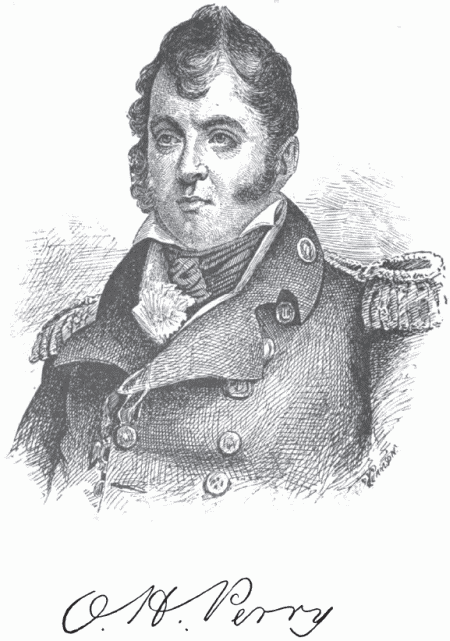 Oliver Hazard Perry
Oliver Hazard Perry
A very long time ago, there lived in England a [Pg 71] young Quaker whose name was Edmund Perry.
At that time the Quakers were much persecuted. They were a quiet and peace-loving people, and would not serve in the army. They had their own religious meetings, and refused to pay money for the support of the Church of England. For these reasons, they were imprisoned, beaten, and driven from their homes.
Edmund Perry believed that the Quakers were right, and he could not endure these persecutions. So, in 1650, he came to America to live.
Thirty years before that time, a company of Pilgrims had left England because they also wished to be free to worship God as they chose. [Pg 72] They had founded a colony at Plymouth, which is now in the state of Massachusetts.
Edmund Perry thought that in this settlement of Pilgrims he could surely live peaceably in the enjoyment of his own belief. He did not stay long in Plymouth, however. His Quaker religion was hated there, as it had been in England; and the Pilgrims did not wish to have any one in their colony who did not agree with them.
Not far from Plymouth was the colony of Rhode Island, which had been founded by Roger Williams. Roger Williams declared that a man is responsible for his opinions only to God and his own conscience, and that no one has any right to punish him for his belief.
The people in the Rhode Island colony did not quarrel with one another about religion, but lived together in peace.
Edmund Perry thought that this was the place where he could make a home for himself and his family. He therefore purchased a large tract of land on the shores of Narragansett Bay, near what is now the site of South Kingston. [Pg 73]
Here he lived for the rest of his life, at peace with all about him, even his Indian neighbors. His descendants also lived in this neighborhood. Among them were judges, lawyers, and doctors, as well as farmers and mechanics; and they were always highly respected in the colony.
Christopher Raymond Perry, a great-great-grandson of Edmund Perry, was born in December, 1761.
At that time there were thirteen colonies or great settlements of English people at different places along the Atlantic coast of what is now the United States. But troubles had already begun to brew between the people of these colonies and the king of England. These troubles finally led to the Revolutionary War.
Christopher Perry, although a mere boy, was one of the first persons in Rhode Island to offer himself for this war. He joined a company of volunteers known as the "Kingston Reds"; but soon afterwards left the army and entered the navy. Here he served, having many adventures, until the close of the war, in 1783. [Pg 74]
He had become very fond of a sailor's life, and when there was no more use for him in the navy he obtained a place on a merchant vessel, and went on a cruise to Ireland.
During the homeward voyage he became acquainted with one of the passengers, a beautiful girl of Scotch descent, whose name was Sara Alexander. Soon after their arrival in America, their friendship ripened into love, and in 1784 they were married in Philadelphia.
Christopher Perry, though but twenty-three years of age, was then the captain of a vessel. The young couple went to live with Christopher's father, on the old Perry estate in South Kingston.
This was then a farm of two hundred acres. The old homestead stood at the foot of a hill not far from the Narragansett shore.
Through the trees in a neighboring wood, shone the white stones which marked the graves of the Quaker, Edmund Perry, and many of his children and grandchildren.
The Perry family were glad to welcome Christopher's young wife into their home. She was as [Pg 75] intelligent as she was beautiful; and her sweet and happy disposition made every one love her.
Christopher Perry gave up his life on the sea for a time, and many happy months were spent in the old home.
On the 23d of August, 1785, their first baby boy was born. He was named for an uncle and a great-great-grandfather, Oliver Hazard Perry.
Oliver was a winsome baby and he grew strong and beautiful very fast. Every one loved him, for he thought all strangers were friends, and was never afraid of them.
Indeed he was not afraid of anything, for to him there was no danger. We shall see that he kept this same fearlessness all through his life.
When he was three years old, he was playing one day with an older child, in the road near his grandfather's house. A man was seen coming rapidly towards them on horseback. The elder [Pg 76] child ran out of the way, calling to Oliver to do the same.
The little fellow sat quite still, however, until the horse was nearly upon him. As the horseman drew rein, Oliver looked up into his face and said, "Man, you will not ride over me, will you?"
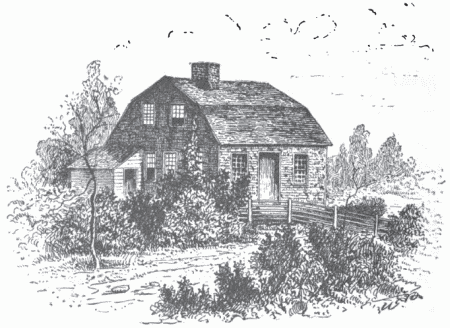 CHILDHOOD HOME OF OLIVER PERRY.
CHILDHOOD HOME OF OLIVER PERRY.
The gentleman, who was a friend of the family's, carried him into the house, and told the story.
When scarcely more than a baby, Oliver sat [Pg 77] upon his mother's knee, while she taught him letters and words. It was not long before he could read quite well. By the time he was five years old, there were two other babies to keep the beautiful, loving mother busy. So it was thought best to send Oliver to school.
Not far from the Perrys', there lived an old gentleman whom the people loved because of his goodness of heart. As there was no school near by, he had often been asked to teach the neighborhood children.
The good old man was notoriously lazy, and consented upon one condition—that he should be allowed to have a bed in the schoolroom.
Teachers were few in those days, and, since there was no one else, the bed was set up. How amusing it must have been to see the children standing about the master's bed and reciting their lessons!
It was to this strange school that little Oliver was first sent. Some girl cousins lived on the adjoining farm. Though they were all older than he, it was Oliver's duty, each day, to take them to [Pg 78] and from school. No one, not even the other scholars, thought this at all strange. His dignified manners always made him seem older than he really was.
One day his mother told him that he was old enough to go to school at Tower Hill, a place four miles away. Boys and girls would now think that a long way to go to school; but Oliver and his cousins did not mind the walk through the woods and over the hills.
The master of this school was so old that he had once taught Oliver's grandfather. He was not lazy, however, and was never known to lose his temper.
It was not long until a change was made and Oliver was taken away from "old master Kelly."
For several years past, Oliver's father had been again on the sea. He had commanded vessels on successful voyages to Europe and South America, and now he had a large income. He was therefore able to pay for better teaching for Oliver and the younger children.
So the family moved from South Kingston to Newport, a larger town, with better schools. [Pg 79]
At first Oliver did not like the change. The discipline was much more strict than it had been in the little country schools.
His teacher, Mr. Frazer, had one serious fault. He had a violent temper which was not always controlled.
One day he became angry at Oliver and broke a ruler over his head. Without a word, Oliver took his hat and went home. He told his mother that he would never go back.
The wise mother said nothing until the next morning. Then, giving him a note for Mr. Frazer, she told him to go to school as usual. The proud boy's lip quivered and tears were in his eyes, but he never thought of disobeying his mother.
The note he carried was a kind one, telling Mr. Frazer that she intrusted Oliver to his care again and hoped that she would not have cause to regret it.
After this Oliver had no better friend than Mr. Frazer. On holidays they walked together to the seashore and spent many hours wandering along [Pg 80] the beach. The schoolmaster took great delight in teaching Oliver the rules of navigation, and the use of the instruments necessary for sailing a vessel.
Oliver learned these things so readily that it was not long until Mr. Frazer said he was the best navigator in Rhode Island. This, of course, was not strictly true, but it showed what an apt scholar the boy was.
Oliver made many friends in Newport. Among them was the Frenchman, Count Rochambeau. The father of this man was a great general, and had once commanded some French troops who helped the Americans in the Revolutionary War.
Count Rochambeau often invited Oliver to dine with him, and one day he gave him a beautiful little watch.
When Oliver was twelve years old, his father gave up his life on the sea. The family then moved to Westerly, a little village in the southwestern part of Rhode Island.
For five years Oliver had been a faithful pupil of Mr. Frazer's, and he was now far advanced for his years. [Pg 81]
About this time some unexpected troubles arose in our country.
France and England had been at war for years. The French were anxious that America should join in the quarrel; and when they could not bring this about by persuasion, they tried to use force.
French cruisers were sent to the American shores to capture merchant vessels while on their way to foreign ports.
You may be sure that this roused the people from one end of the United States to the other. Preparations for war with France were begun; and the first great need was a better navy.
At the close of the Revolutionary War, all work on government vessels had been stopped. Those that were unfinished were sold to shipping merchants. Even the ships of war that had done such good service, were sold to foreign countries. In this way, the entire American navy passed out of existence. [Pg 82]
But now the President, John Adams, went to work to establish a navy that should give protection to American commerce.
In the spring of 1798, a naval department was organized, with Benjamin Stoddert as the first Secretary of the Navy. The following summer was busy with active preparations. Six new frigates were built, and to these were added a number of other vessels of various kinds.
Captain Christopher Perry was given command of one of the new frigates that were being built at Warren, a small town near Bristol, Rhode Island. This vessel was to be called the General Greene.
In order to superintend the building of this vessel, Captain Perry, with his wife, left his quiet home in Westerly, and went to stay in Warren.
Oliver, then not quite thirteen years old, remained at home to take charge of the family.
He saw that his sister and brothers went to school regularly. He bought all the family provisions. Each day he wrote to his father and mother, telling them about home affairs. In the [Pg 83] meantime, he was busily planning what his work in life should be.
His mother had taught him that a man must be brave, and always ready to serve his country. She had told him many stories of battles fought long ago in her native land across the sea.
Oliver had lived most of his life in sight of the sea, and had spent many hours with seamen. It is not strange, therefore, that he should decide,—"I wish to be a captain like my father."
He had heard of the troubles with France, and he longed to help defend his country. And so at last he wrote to his father, asking permission to enter the navy. It was a manly letter, telling all his reasons for his choice.
The consent was readily given, and Oliver soon afterward received an appointment as midshipman on his father's vessel, the General Greene.
In the meantime, the people grew more eager for war. An army had been raised to drive back [Pg 84] the French, should they attempt to invade the land. George Washington, though nearly sixty-seven years of age, had been appointed commander in chief of the American forces.
In February, 1799, one of the new frigates, the Constellation, under Captain Truxton, defeated and captured a French frigate of equal size. By spring the General Greene was completed, and Captain Perry was ordered to sail for the West Indies.
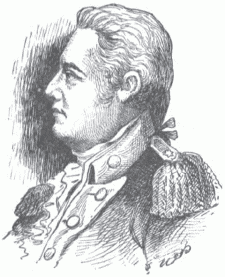 CAPT. THOMAS TRUXTON.
CAPT. THOMAS TRUXTON.
America had large trading interests with those islands. Many of our merchant vessels brought from there large cargoes of fruits, coffee, and spices. The General Greene was ordered to protect these cargoes from the French cruisers, and bring them safely into port.
For several months Captain Perry's vessel convoyed ships between Cuba and the United States. In July, some of the sailors on board were sick [Pg 85] with yellow fever. So Captain Perry brought the vessel back to Newport.
Oliver went at once to see his mother. The tall lad in his bright uniform was a hero to all the children in the neighborhood.
His brothers and sister considered it an honor to wait upon him. They would go out in the early morning and pick berries for his breakfast, so that he might have them with the dew upon them.
While on shipboard he had learned to play a little on the flute. The children loved to sit about him, and listen to his music.
By the autumn of 1799, the crew of the General Greene were well again, and Captain Perry sailed back to Havana.
It was during the following winter months of cruising with his father, that Oliver was taught his lessons of naval honor. He also applied the lessons in navigation which he had learned from Mr. Frazer.
He read and studied very carefully, and could not have had a better teacher than his father.
While the General Greene was cruising among [Pg 86] the West Indies, Captain Truxton had won another victory with his Constellation. This time he captured a French frigate which carried sixteen guns more than the Constellation.
The French, dismayed at these victories of the Americans, began to be more civil. They even seemed anxious for peace.
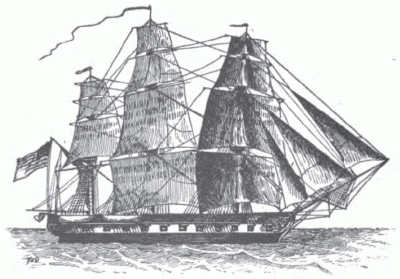 THE CONSTELLATION.
THE CONSTELLATION.
War had been carried on for about a year, though it had never been formally declared.
In May, 1800, the General Greene came back to Newport, and remained in harbor until the terms of peace were concluded.
The trouble with France being settled, it was [Pg 87] decided by the government to dispose of nearly all the naval vessels. As a result, many of the captains and midshipmen were dismissed, Captain Perry being one of the number.
Fortunately for the country, young Oliver was retained as midshipman.
On the northern coast of Africa, bordering on the Mediterranean Sea, are four countries known as the Barbary States. These are Tunis, Algiers, Tripoli, and Morocco.
For more than four hundred years, these countries had been making a business of sea-robbery. Their pirate vessels had seized and plundered the ships of other nations, and the captured officers and men were sold into slavery.
Instead of resisting these robbers, most of the nations had found it easier to pay vast sums of money to the Barbary rulers to obtain protection for their commerce.
The Americans had begun in this way, and had [Pg 88] made presents of money and goods to Algiers and Tunis.
Then the ruler of Tripoli, called the Bashaw, informed our government that he would wait six months for a handsome present from us. If it did not come then, he would declare war against the United States.
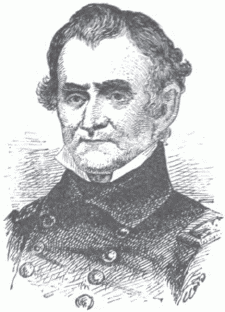 COMMODORE CHARLES MORRIS.
COMMODORE CHARLES MORRIS.
This did not frighten the Americans at all. Their only reply was to send a fleet of four ships to the Mediterranean. The intention was to force the Bashaw to make a treaty which should insure safety for our ships.
This squadron did not do much but blockade the ports of Tripoli.
A year later, in 1802, a larger squadron was fitted out to bring the Bashaw to terms. Commodore Morris was the commander. On one of the vessels, the Adams, was Oliver Perry as midshipman. [Pg 89]
Soon after the arrival of his ship in the Mediterranean, Oliver celebrated his seventeenth birthday.
The captain of the Adams was very fond of him, and succeeded in having him appointed lieutenant on that day.
For a year and a half, the squadron of Commodore Morris cruised about the Mediterranean. No great battles were fought and no great victories were won.
The Adams stopped at the coast towns of Spain, France, and Italy. Through the kindness of the captain, Oliver was often allowed to go on shore and visit the places of interest.
Commodore Morris, being recalled to America, sailed thither in the Adams; and so it happened that in November, 1803, Oliver Perry arrived again in America.
His father was then living in Newport, and Oliver remained at home until July of the next year.
He spent much of his time in studying mathematics and astronomy. He liked to go out among the young people, and his pleasing manners [Pg 90] and good looks made him a general favorite.
He was fond of music and could play the flute very skillfully. When not studying, he liked most of all to ride horses, and fence with a sword.
While Lieutenant Perry was spending this time at home, the war in the Mediterranean was still being carried on. Commodore Preble, who had succeeded Commodore Morris, had won many brilliant victories.
The most daring feat of all this war was accomplished by Stephen Decatur, a young lieutenant only twenty-three years old.
One of the largest of the American vessels, the Philadelphia, had, by accident, been grounded on a reef. Taking advantage of her helpless condition, the whole Tripolitan fleet opened fire upon her.
Captain Bainbridge, the commander of the Philadelphia, was obliged to surrender. The Tripolitans managed to float the vessel off the reef, and towed her into the harbor.
Captain Bainbridge, although a prisoner, found means to send word of his misfortune to Commodore [Pg 91] Preble, who was then at Malta, and the American fleet at once sailed for Tripoli.
At the suggestion of Captain Bainbridge, the Americans determined to burn the Philadelphia, rather than allow the Tripolitans to keep her.
This was a very dangerous undertaking, as the vessel was anchored in the midst of the Tripolitan fleet. It was also within easy range of the guns of the fort, commanding the harbor.
The task was given to Stephen Decatur. In order to deceive the enemy, he took a small boat which had been captured from them a short time before. Its crew was made up of volunteers, for the chances of escape were very few.
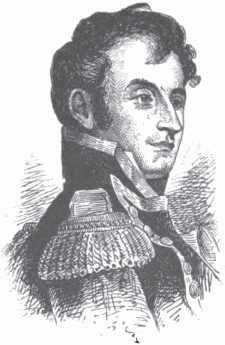 STEPHEN DECATUR.
STEPHEN DECATUR.
Under cover of night, the little vessel sailed into the harbor, and, as if by accident, ran into the Philadelphia. Before the Tripolitans realized what had happened, Decatur and his men were [Pg 92] climbing over the sides of the vessel and through the port holes.
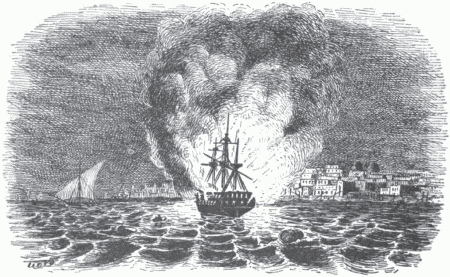 BURNING OF THE PHILADELPHIA.
BURNING OF THE PHILADELPHIA.
Decatur had ordered his men to use no firearms. He did not wish to attract the attention of the Tripolitans who were in the fort and on the other vessels in the harbor.
A desperate hand to hand fight ensued. In a few minutes the Americans were in possession of the vessel. Some of the Tripolitan crew had been killed; others had jumped into the sea.
The Americans then set the Philadelphia on [Pg 93] fire and jumped into their boat to escape. Lieutenant Decatur was the last one to leave the burning ship.
The situation of the little band was now desperate. The Philadelphia was a mass of flames, lighting up the harbor for miles around.
Decatur's little boat could be plainly seen, and all the vessels and forts opened fire on it. But the Tripolitans were too much excited to do serious damage.
In a short time the fire reached the magazine of the Philadelphia and she blew up with a tremendous crash, leaving the harbor in darkness. Decatur and his men escaped with but one man wounded.
This is only one of many deeds of bravery done in this war, but we can not tell of them in this story. Lieutenant Perry, in his home in America, heard of them, and longed to be on the scene of action.
He was very glad when, in the following September, he was ordered to return in the Constellation to the Mediterranean. [Pg 94]
The American fleet in the Mediterranean was by this time so large that the Bashaw was convinced that the Americans were in earnest.
He was glad to make a treaty of peace and release the prisoners on payment of a small ransom.
In October, 1806, Oliver Perry returned to America. He was greatly disappointed that he had not been able to take a more active part in the war.
He spent most of the next two years in Newport, dividing his time between study and his many friends.
While America was having these troubles with the Barbary States, France and England were still at war. Commerce all over the world was affected, and in some cases almost destroyed by this long war.
The French emperor, Napoleon Bonaparte, had forbidden all vessels of other nations to enter [Pg 95] British ports. The English, in turn, said that no vessel should enter a port of France, or of any country belonging to France.
But the Americans had to endure still further injuries from the English. British war vessels claimed the right to stop American ships on the sea, search them, and carry off American sailors, claiming them as deserters from the English navy.
The French could not do this; for no American sailor could be accused of being a runaway Frenchman.
In 1807, an event took place which nearly led to war.
The British frigate Leopard, cruising along the coast, hailed the American frigate Chesapeake, and demanded permission to search the ship.
The captain of the Chesapeake refused. Without a word of warning, the Leopard fired into the Chesapeake, killing and wounding more than twenty men.
The American captain had not dreamed of such an outrage. His vessel had just put to sea and everything was in confusion. He did not even [Pg 96] have a gun in condition to return the fire. So he lowered his flag and surrendered.
The officers of the Leopard then came on board and carried off four men from the crew.
The United States would have declared war at once if England had not apologized.
The President, at this time, was Thomas Jefferson. He was a man of peace. He called a session of Congress to see if the trouble could not be settled without war.
As a result of this session, a law was passed known as the Embargo Act. By this law, no vessel was allowed to sail from the United States to any foreign country.
In order to enforce the law, Congress ordered a number of gunboats to be built. These were to sail up and down the coast, and prevent any vessel from entering or leaving the ports.
Lieutenant Perry was ordered to superintend the building of a fleet of these gunboats at Newport. After they were built, he was put in command of them, and ordered to patrol Long Island Sound. [Pg 97]
At this time, the government wanted a map of the harbors in the neighborhood of Newport. On account of his standing as a seaman, and of his education, Lieutenant Perry was selected to visit the harbors and make such a map.
He was given a fast sailing schooner called the Revenge. While carrying on this work, he was one day returning from Newport to New London, when a dense fog came on. The Revenge struck upon a reef of rocks, and went to pieces.
By great efforts Lieutenant Perry was able to save, not only all the crew, but the sails, rigging, and cannon.
He then went to Washington to explain the loss of the Revenge to the navy department. It was made clear that it was the fault of the local pilot who had charge of the vessel at the time.
Lieutenant Perry was commended for his gallant conduct in this disaster, and was also granted a year's leave of absence. He went to Newport, and on May 5, 1811, he was married to Elizabeth Champlin Mason.
The young couple took a wedding journey [Pg 98] through New England. They spent one day in Plymouth, Massachusetts. Lieutenant Perry was much interested in visiting the place where his Quaker ancestor had lived so many years before.
During this time, the people of the United States had learned that the Embargo Act was a very unwise law. The men of Congress had thought to injure France and England by thus refusing to trade with them altogether. They soon discovered, however, that the damage to American commerce was far greater.
Trading vessels in the ports were left standing idle at the wharves, while the sailors were forced to find other employment.
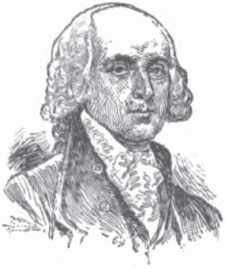 JAMES MADISON.
JAMES MADISON.
All over the country, there arose a bitter feeling against this law. In the New England states, where there were the largest shipping interests, there was even talk of secession from the Union.
About this time a new President, James Madison, was elected. Soon afterward the Embargo Act was repealed, and in its place was passed a law [Pg 99] which satisfied the people for a time. By this law, trade was allowed with every country but England and France.
American vessels now put to sea on voyages to foreign lands. But their old enemies, the English, soon began to annoy them as before.
In May, 1811, the British sloop Little Belt was hailed by the American frigate President, under the command of Commodore Rodgers. The reply was a cannon shot. The President then poured broadsides into the Little Belt. After the English had lost thirty-two men in killed and wounded, they came to terms.
 COMMODORE JOHN RODGERS.
COMMODORE JOHN RODGERS.
The American people now saw that war could no longer be avoided. On June 18, 1812, the formal declaration was made. [Pg 100]
Up to this time the English navy had been called the "Mistress of the Seas." England's vessels could be numbered by the hundred, and the crews by the ten thousand.
When this war of 1812 was declared, the entire United States navy comprised about half a dozen frigates, and six or eight sloops and brigs. Along the American coast alone the English had seven times this number of war vessels.
The first few months of the war were full of naval surprises. In that brief time the Americans captured more British ships than the French had taken in twenty years.
On August 19th, the American frigate Constitution, commanded by Captain Isaac Hull, in one half hour captured the English frigate Guerrière. The English lost one hundred men, and the vessel was so disabled that she was left to sink. The Americans lost but fourteen men, and in a few hours the ship was ready for another battle.
Several other victories followed in quick succession. [Pg 101] In all this time the Americans did not lose a ship.
In December, Commodore Bainbridge, the same officer who had been taken prisoner years before by the Tripolitans and had afterwards been promoted, was cruising with the frigate Constitution off the coast of Brazil. He there encountered and captured the British frigate Java.
But though so successful on the sea, the Americans were defeated many times on land.
The possession of the Great Lakes was of the utmost importance to both the English and the Americans.
Ever since the Revolution the English had kept a naval force on these lakes. They had hoped that some time they might be able to extend the Canadian territory along the Great Lakes and down the Mississippi to New Orleans. This would give them the possession of the great west.
Many prosperous towns and trading posts were scattered along the Canadian shores. To capture some of these was the task given to the American army. [Pg 102]
The campaign was opened by General William Hull. With two thousand men he crossed the Detroit River, and marched into Canada.
After a few skirmishes with the Indians, he fell back to the fort at Detroit. Then, without firing a single gun, he gave up this fort to the English. This surrender was a great loss to the Americans for many reasons.
There was, in the west, a bold Indian warrior whose name was Tecumseh. He had a brother whom the Indians called the Prophet, because he was a medicine man and could do wonderful things.
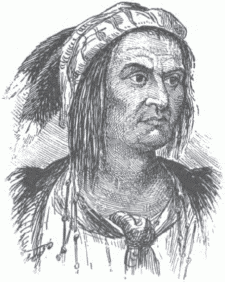 TECUMSEH.
TECUMSEH.
These two Indians wished to form a union of all the tribes from Canada to the Gulf of Mexico. They hoped that in this way they might prevent the white settlers from taking their hunting grounds.
"The white men are continually driving the red [Pg 103] people toward the west; by and by we shall be driven into the Great Water," they said.
The governor-general of Canada made the Indians many promises, and tried to incite them against the United States. In this way he persuaded many warlike tribes to give aid to the English. Tecumseh himself crossed into Canada and joined the British army under General Proctor.
After Hull's surrender of Detroit, the British and Indians took possession not only of that fort, but also of Fort Dearborn, where Chicago now stands. The territory of Michigan was completely in their hands, and the settlers along the lakes and all through the northwest were at the mercy of the Indians.
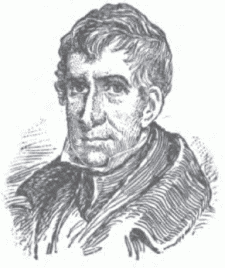 WILLIAM HENRY HARRISON.
WILLIAM HENRY HARRISON.
General William Henry Harrison tried to regain Detroit. His advance guard was met and defeated at the River Raisin, a few miles south of Detroit. Every American prisoner was murdered by the Indians; and for years afterward the River Raisin was a name of horror. [Pg 104]
The Americans felt that something desperate must be done. The first great thing to be gained was the control of the lakes.
At this time nearly the whole of the western country was a wilderness. The only way of moving men and supplies from place to place, was by the use of boats on the lakes and water courses.
On Lake Ontario a small fleet had been built, and a skirmish or two had been fought. But the thing of most importance was the control of Lake Erie. This would not only give back Detroit to the Americans, but would also be the means of recovering the whole of the Michigan territory.
The task of building a fleet and driving the English from the lakes was given to Lieutenant Perry.
At the beginning of the war he had left his quiet home in Newport, and had hurried to Washington to ask for active service.
He was promised the first vacancy, but in the meantime he was ordered to protect the harbors of Long Island Sound with a flotilla of gunboats.
During the year 1812 he performed this duty [Pg 105] faithfully, all the while drilling his men, in hopes of being intrusted with a larger responsibility.
In February, 1813, Lieutenant Perry was ordered to go to Lake Erie. He was to take with him, from his gunboats, the men whom he thought best fitted for the service and report to Commodore Chauncey, who was in command of the squadron on Lake Ontario. The American headquarters, on that lake, were at Sacketts Harbor.
It was almost impossible to reach the place. From the Hudson River to the shores of Lake Ontario, was a vast wilderness. No road had been cut through it; none but Indians could follow the difficult trails.
The only route known to the white men was along the Mohawk River to Lake Oneida, then by the Oswego River to the little village of Oswego on Lake Ontario. To transport men and arms along this route was a great task, requiring much time, skill, and patience. [Pg 106]
Oliver Perry was a man of action. On the very day that he received his orders, he started fifty men to Lake Ontario, and the next day fifty more.

On February 22d, in the coldest part of winter, he left his home and his young wife in Newport, and with his brother Alexander, began the difficult journey towards the north.
Sometimes they traveled in rude sleighs over the roughest of roads. Sometimes, when the river was not too full of ice, they embarked in canoes. At other times, they could only go on foot through the thick underbrush. On all sides was a vast [Pg 107] wilderness, inhabited only by wild beasts and unfriendly Indians.
At Oswego, they embarked in boats and followed the shore of Lake Ontario to Sacketts Harbor. On one side of them was the dreary inland sea full of tossing white caps and overhung by the leaden sky of winter. On the other side lay the trackless forest.
To relieve their loneliness, they occasionally fired a musket. The echoes would roll along the shore, growing fainter and fainter. This only made the silence which followed seem greater than before.
A cold rain began to fall, and by the time they reached Sacketts Harbor they were drenched to the skin.
On March 16th, Lieutenant Perry set out for Lake Erie. Upon reaching the harbor at Erie he found that twenty-five ship carpenters had already begun work on three gunboats and two brigs. Fifty more carpenters had started four weeks before from Philadelphia, but had not yet arrived.
The task which lay before Oliver Perry seemed almost an impossible one. Mechanics, seamen, [Pg 108] guns, sailcloth,—everything needed for the ships must be brought hundreds of miles through a wild and half-settled country.
But by the end of the summer, a fleet, which seemed to have been built by magic, was ready to meet the English. Six months before, the timbers used in building the vessels had been growing trees; the iron that held these timbers together was either in the mines or in warehouses or farmers' barns, in the shape of plowshares, axes, or horseshoes.
The shipbuilders had come through the wilderness from Philadelphia. The guns, ammunition, and rigging had been brought in ox-wagons, hundreds of miles over almost impassable roads.
While Perry was building this fleet, a sad event had taken place on the sea. The British frigate Shannon met and captured the American frigate Chesapeake, June 1, 1813, near Boston harbor.
 CAPTAIN JAMES LAWRENCE.
CAPTAIN JAMES LAWRENCE.
Captain Lawrence of the Chesapeake fought bravely, but, in the battle, was mortally wounded. As he was being [Pg 109] carried below, his last words were: "Don't give up the ship!"
The Secretary of the Navy sent word to Lieutenant Perry to name one of the vessels of his new fleet the Lawrence, after this gallant captain. Lieutenant Perry therefore gave this name to his flagship.
By the 10th of July the fleet was ready for sea, but there were only officers and men enough to man one ship. Several of these were ill with fever.
Lieutenant Perry wrote many letters to General Harrison, Commodore Chauncey, and the Secretary of the Navy.
"Give me men, and I will acquire both for you and for myself honor and glory on this lake, or die in the attempt," he said.
By the end of July he had over four hundred men for his nine vessels. But, as he said, they were a "motley crew" of regular soldiers, negroes, and raw recruits. During the battle which followed, over a hundred of these men were too sick to be of any use.
The English fleet of six vessels was commanded [Pg 110] by Captain Barclay. In his crews were over five hundred men and boys.
Early in August the American squadron left the harbor of Erie, and sailed to Put-in-Bay, an island not far from the west end of the lake.
The British squadron was in the harbor of Fort Malden, nearly opposite on the Canadian shore.
On the morning of September 10, 1813, from the masthead of the Lawrence, the English fleet was seen approaching.
As the Americans were sailing out to battle, Lieutenant Perry gathered his men together and talked to them about the courage they would need.
He showed them a large blue flag, bearing in white letters a foot high the words: "Don't give up the ship!"
"My brave lads," he said, "this flag bears the last words of Captain Lawrence. Shall I hoist it?" [Pg 111]
With one voice, the men shouted: "Aye, aye, sir!"
As the bunting was run up on the Lawrence, cheer upon cheer came from every vessel of the American squadron. The men were then sent to their quarters, and every one quietly waited for the beginning of battle.
It was a beautiful morning. The sky was cloudless, and there was hardly a ripple to disturb the lake. The English vessels were newly painted, and gayly adorned with flags. Every sail shone in dazzling whiteness in the sunlight.
At half-past ten a bugle was heard from the English flagship, which was followed by cheers from the other vessels. Across the water the Americans could hear the strains of the English national air played by a band.
On the Lawrence all was still. With determined faces the men stood by the guns.
Lieutenant Perry knew that a great responsibility was upon him. He knew that, should he lose the battle, General Proctor and Tecumseh, with five thousand soldiers and Indians, were ready to [Pg 112] cross the lake, and take possession of the southern shore. All through that part of the country, anxious men, women, and children were waiting to flee from their homes, if the dreaded Indians came upon them.
These things Lieutenant Perry knew. He passed along the deck, carefully examining every gun. He had a word of encouragement for each gun crew.
Seeing some of the men who had fought on the Constitution, he said, "I need not say anything to you. You know how to beat those fellows."
As he passed another gun, commanded by a crew that had served in his gunboat flotilla, he said: "Here are the Newport boys! They will do their duty, I warrant."
In this way he filled all his men with a great earnestness, and a determination to conquer or die.
While the two squadrons were yet a mile apart, the English sent a cannon ball skimming over the water. For some time there followed a vigorous firing from both sides.
As the English guns could carry farther than [Pg 113] those of the Americans, Lieutenant Perry brought his flagship into close quarters. The other American vessels were some distance behind.
The whole British squadron then opened fire upon the Lawrence.
At the end of an hour of this unequal battle, the condition of the Lawrence was pitiable. One by one the guns had been disabled. Finally only one on the side toward the enemy could be used. The rigging was damaged, the spars were shattered, and the sails were torn into shreds. Eighty-three men had been killed or wounded.
Two musket balls passed through Lieutenant Perry's hat, and his clothing was torn by flying splinters.
One heavy shot crushed into the large china closet, and smashed every dish with a great clatter. A dog, that had been locked up there, startled by the noise, added to the tumult by howling dismally.
Several times the Lawrence barely escaped being blown up. Two cannon balls passed entirely through the powder magazine. [Pg 114]
Even the wounded men crawled upon the deck to lend a feeble hand in firing the guns. It was Oliver Perry himself, however, that loaded and fired the last gun of the Lawrence.
Lieutenant Perry at last determined to change his flag from the Lawrence to the Niagara. A breeze had sprung up, which enabled this vessel to come near to the helpless Lawrence.
The first lieutenant was left in command of the Lawrence, with orders to hold out to the last. Then with his brother Alexander and four seamen, Lieutenant Perry got into a rowboat. Just as they were shoving off, a seaman on the Lawrence hauled down the blue flag, bearing the motto, "Don't give up the ship!" He rolled it up and tossed it to Perry.
The smoke of the battle was so dense that the rowboat had nearly reached the Niagara before it was seen by the English. Then a shot was sent which went straight through the boat's side.
Taking off his coat and rolling it up, Perry quickly thrust it into the hole which the ball had made. This kept the boat from sinking. [Pg 115]
As he stepped upon the deck of the Niagara, Perry ordered the blue flag to be hoisted. Just at this moment the Lawrence surrendered.
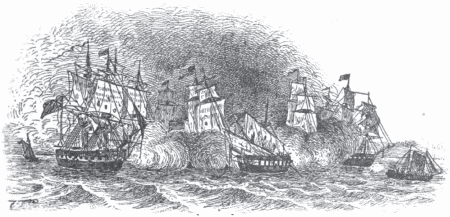 THE BATTLE OF LAKE ERIE.
THE BATTLE OF LAKE ERIE.
The English gave a cheer, thinking they had won the battle. They were not able, however, to board and take the Lawrence at once, and so she drifted away. When safely out of range her colors were rehoisted.
Bringing the Niagara into position, Lieutenant Perry fired a terrific broadside into one of the English vessels. Then he sailed quickly to another and did the same thing.
The other American vessels followed this example, and a terrific battle followed. [Pg 116]
In just fifteen minutes the English surrendered. Two vessels of their squadron attempted to escape, but were soon overtaken and captured.
Lieutenant Perry was determined that the formal surrender should take place on the Lawrence. So once more he lowered his flag, and jumping into a boat, made for his first flagship.
When he stepped on board the Lawrence not a cheer was heard. The handful of men that were left silently greeted their commander.
Few of them were uninjured. Some had splintered arms and legs. Others had bandages about their heads. Their faces were black with powder.
The English officers came on board to present their swords to Perry. With quiet dignity he returned each one.
He then took from his pocket an old letter. Using his cap for a desk, he wrote with a pencil his famous dispatch to General Harrison:
"We have met the enemy and they are ours. Two ships, two brigs, one schooner, and one sloop. Yours, with very great respect and esteem,
"O.H. Perry."
[Pg 117]
The battle on Lake Erie was the beginning of the end of the war. The news of the victory caused great rejoicings all over the country. In all the principal towns there were meetings, bonfires, and torchlight processions.
General Harrison could now take his army into Canada. No time was lost. He hurried over four thousand men to the lake, where Perry's fleet waited to take them across.
The main body of the British army, under General Proctor and Tecumseh, was at Fort Malden. Upon landing there the Americans found that the enemy had fled, having burned the forts, barracks, and stores.
General Harrison followed the English up the left bank of the Detroit River. The fort at Detroit was surrendered without any resistance, and the English retreated along the St. Clair Lake and up the Thames River.
The Americans steadily pursued them. Perry, [Pg 118] with his fleet, followed the army, carrying the baggage and provisions.
He became so excited over the chase that he could not remain quietly on his ships. So, leaving them in charge of one of his officers, he went ashore and offered his services to General Harrison as aid-de-camp.
As he joined the army he was met with cheers of welcome from the soldiers. General Harrison afterward said: "The appearance of the gallant Perry cheered and animated every soldier."
Following the English some distance up the Thames, the Americans finally overtook them. They were drawn up in line of battle on a narrow strip of land which lay between the river and a large swamp.
The American cavalry made a bold dash through these lines, and the enemy was soon routed. Over sixty British and Indians were killed, and six hundred troops were made prisoners. General Proctor made his escape, but Tecumseh was killed.
The death of this great chief severed forever the [Pg 119] tie which bound the Indians to the English. Soon afterwards all the tribes of the northwest declared submission to the United States. The white settlers in the region about the Great Lakes were thus freed from their fear of the savages.
During the battle of the Thames, the soldiers greatly admired the fine horsemanship of Oliver Perry. He rode a powerful black horse, with a white face, that could be seen from all parts of the field.
Once, when riding swiftly to carry out some orders of the general's, the horse plunged into the deep mire to his breast. Perry pressed his hands on the pommel of the saddle, and sprang over the horse's head to dry ground.
Relieved from the weight of his rider, the horse freed himself and bounded forward. Perry clutched the mane as he passed and vaulted into the saddle, without stopping the animal's speed for a moment. As he passed the soldiers, many cheers arose.
On October 7, 1813, Perry returned to Detroit, and from there started back to his home in Newport. [Pg 120] The people hailed him with joy, and enough could not be said in his praises. Even Captain Barclay of the English fleet called him "The gallant and generous enemy."
His journey to Newport was indeed a triumphal one. In every town that he passed through, business was stopped and the schools were closed so that all could have a glimpse of the hero of Lake Erie. Processions accompanied him from town to town.
On November 18th, he reached his home in Newport. Bells were rung, all the ships were adorned with flags, and salutes were fired in his honor.
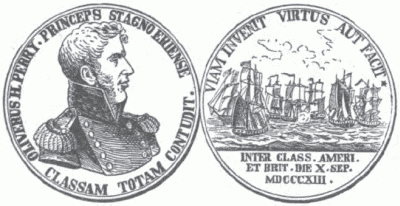 GOLD MEDAL AWARDED BY CONGRESS.
GOLD MEDAL AWARDED BY CONGRESS.
On November 29th, he received his promotion to the rank of captain. At that time this was the highest rank in the American navy. A gold medal was also given to him by Congress. [Pg 121]
In the following January he made a visit to Washington, where he was publicly entertained by the President and citizens.
In August, 1814, he was ordered to command a new frigate named the Java. He hastened to Baltimore, where this vessel was to be launched.
On the 11th of September, Lieutenant Macdonough, who was in command of the American squadron on Lake Champlain, gained a decisive victory over the British near Plattsburg. Everything at the North seemed now to be favorable to the Americans; but it was not so at the South.
While Captain Perry was waiting at Baltimore, the British had sailed up the Potomac with an army and a fleet. They captured Washington, and burned the capitol, the White House, and some of the other public buildings.
Being so successful in this, they made a like attempt upon Baltimore, but were driven back. They then blockaded Chesapeake Bay.
Just at this time, Congress passed a bill to fit out two squadrons of fast-sailing vessels. These [Pg 122] were to cruise near the English coasts and destroy the commerce between the different ports.
Captain Perry was ordered to leave the Java and command one of these squadrons. But before he could sail for England, peace was declared. A treaty with that country was signed December 24, 1814.
While the United States had been at war with England, trouble had again arisen with the Barbary States. None of these countries had been so annoying as Algiers. The ruler, or Dey, of Algiers knew that every American naval vessel was busy fighting the English. He therefore thought this a good time to burn and plunder the merchant ships. He also demanded large sums of money in return for his captured prizes and prisoners.
But no sooner was peace concluded with England, than Congress declared war with Algiers. A squadron was sent to the Mediterranean, commanded by the brave Stephen Decatur, and he [Pg 123] soon compelled the Dey to sign a treaty with the United States.
In this treaty the Dey promised to give back all the American property he had captured. If there was anything that he could not return, he was to pay for it at its full value. He was also to release all the Americans he held as prisoners, and give up, forever, all claim to tribute money from the United States.
When the consuls of other countries heard of what Decatur had accomplished, they tried to persuade the Algerine ruler to make the same terms with them. Then the Dey was sorry that he had "humbled himself" before the young republic, and he declared that he did not consider the treaty binding.
Congress therefore thought it wise to strengthen the American squadron in the Mediterranean, in order that this trouble should be settled.
Captain Perry was ordered to take the Java and sail at once for Algiers. On January 22, 1816, he set sail, and in March he joined the American vessels off the eastern coast of Spain. [Pg 124]
Upon arriving at Algiers, they found that the Dey had just received a large amount of tribute money from an English fleet. This made him very unwilling to talk about treaties.
The English fleet had not only brought money to pay for the release of English prisoners, but also had brought vast sums from the governments of Naples and Sardinia to buy the freedom of their enslaved countrymen.
Twelve hundred captives were freed in this way, and put aboard the English vessels. There were people of all ages, clothed in rags. Some had been taken while young and now were old men, with gray hair and beards.
The Dey refused to treat with the American commander, and the Americans would have destroyed the Algerian fleet and bombarded the town at once, but for an article in the treaty which Decatur had made. This article stated that when either side should become dissatisfied with the treaty, three months' notice should be given before actual fighting began.
While waiting for these three months to pass, [Pg 125] the American squadron cruised about the Mediterranean and visited the other Barbary States. The commander wished to show the rulers of these states that our country had a navy which could protect our commerce.
After this the fleet sailed along the southern coast of Europe. There was no vessel which attracted more admiration than Captain Perry's Java. To visit this ship was, indeed, a pleasure.
The captain was a courteous host, and always made his guests welcome. Everything on the ship was in order, and ready for instant use. The discipline of the crew was perfect.
Being a good musician himself, Captain Perry had the finest band in all the fleet. He took a personal interest in each one of his men, and was always ready with a word of praise when he saw it was deserved. He gave the midshipmen lessons in navigation, and saw that they had lessons in Spanish and French and in the use of the sword. They were even taught to dance.
Whenever it was possible the men were allowed [Pg 126] to go on shore, in order that they might visit the places of interest.
By January, 1817, the Dey of Algiers finally came to terms and signed a new treaty, agreeing to the conditions required by the United States. Captain Perry was soon afterwards ordered to sail for America, carrying this new treaty with him. In March he arrived at Newport.
After so many months of cruising, Captain Perry was very glad to be again in his own country.
He spent the next two years quietly at home with his family. He built a snug little cottage in Narragansett, on the old Perry estate. This was the same farm that had been purchased by the young Quaker, Edmund Perry, so many years before. Here the family spent the summers.
Captain Perry was always fond of life in the country. He took many long rides on horseback. Besides his horses, he had many other pets on the [Pg 127] farm. He and his three little sons spent a great deal of time taking care of them.
The winters were passed in the house at Newport.
 CAPTAIN PERRY'S RESIDENCE AT NEWPORT.
CAPTAIN PERRY'S RESIDENCE AT NEWPORT.
These were the happiest years of Oliver Perry's life, and he could not help but be sorry, when, on March 31, 1819, he received a summons to go to Washington.
Upon arriving there, the Secretary of the Navy told him of an expedition that the government wished him to undertake.
He was to go to Venezuela, on the northern coast of South America. This was a new republic [Pg 128] which had formerly been a colony of Spain. Its people were still fighting for their independence, just as the people of the United States had fought against the king of England.
Small, fast-sailing war vessels, called privateers, had been fitted out by this republic. These vessels were designed to capture Spanish merchant ships, and were allowed to keep all the money that was obtained from the prizes.
But it was not the Spanish ships alone which suffered from these privateers. The desire for prize money led them to attack ships of other nations. The American merchants had met with many losses in this way.
Captain Perry was to present claims for these losses, and also to persuade the president of Venezuela to keep his privateers from preying on American commerce. For this expedition, Perry was to have two vessels, the sloop John Adams and the schooner Nonsuch.
On July 15, 1819, he arrived at the mouth of the Orinoco River. Here he was obliged to take the small schooner in order to go up the river and [Pg 129] reach the town of Angostura, which was then the Venezuelan capital. He sent the John Adams to Port Spain, on the island of Trinidad, one hundred and fifty miles away. This vessel was ordered to wait there for his return.
The voyage up the Orinoco was an interesting one. All along the shores were vast tropical forests with overhanging trees full of birds of brilliant colors. Luxuriant vines were festooned from limb to limb. Flowers of all colors grew everywhere.
On the other hand, the trip was full of hardships. The heat was fearful and the sand-flies, gnats, and mosquitoes were almost unbearable.
Soon after reaching Angostura many of the crew were taken ill with yellow fever, but Perry would not leave until his mission was accomplished. After three weeks of delay, he succeeded in getting the promises for which he had come.
The schooner then sailed down the river, reaching the mouth on August 15th. On account of a high sea, to cross the bar that night would be a dangerous undertaking, and the vessel was therefore anchored until morning. [Pg 130]
During the night, the wind freshened so much that the spray dashed into the cabin where Captain Perry was sleeping. In the morning he awoke with a cold chill and symptoms of yellow fever.
Every effort was made to reach the John Adams as soon as possible. Captain Perry grew rapidly worse. In the intense heat, his little schooner cabin was most uncomfortable.
The winds were unfavorable and the progress of the little vessel was slow. When within a mile of the John Adams, Captain Perry died. This was on his thirty-fourth birthday, August 23, 1819.
He was buried on the island of Trinidad with military honors, and the John Adams brought back the sad news to the United States.
His death was regarded as a national calamity. The government sent a war vessel to bring his body home. He was finally laid to rest at Newport, where a granite monument marks his grave.
The feelings of his fellow officers were well expressed by Stephen Decatur. Upon hearing of Perry's death, he said: "Sir! The American navy has lost its brightest ornament!" [Pg 131]
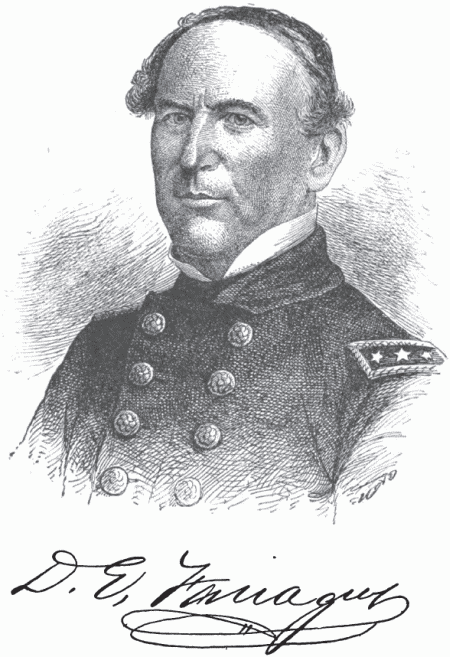 D.E. Farragut
D.E. Farragut
On July 5, 1801, in a rude cabin in Eastern [Pg 133] Tennessee, David Glasgow Farragut was born.
It was a wild and lonely place. For miles around the little farm, nothing could be seen but woods. Few sounds could be heard save the singing of birds and sometimes the cries of wild beasts.
There was already one child in the family, a boy, whose name was William.
George Farragut, the father, was a brave man. He was a Spaniard, and had come to America during the Revolutionary War.
He was a lover of liberty, and for that reason he had taken up arms with the colonists to help them win their independence from England. [Pg 134]
After the close of the war, he had married a hardy frontier girl, and had come to this wild place to make his home.
His life on the little clearing in the backwoods was one of toil and frequent hardships. Every day he was busy chopping down trees, planting crops, or hunting in the great forest.
The young wife, Elizabeth, was also busy, keeping her house and spinning and making the clothes for herself, her husband, and her children.
Little David Farragut grew strong very fast.
He and William had no playmates, but they liked to run about under the trees. They could not go far from the cabin, however, as there were both wild beasts and Indians in the woods.
Sometimes the father would be away for several days, hunting wild game for the family to eat. At such times, the mother and children would be left alone.
One day a band of Indians came and tried to enter the cabin. The mother sent the boys into the loft, where they crouched down close to the roof and kept very still. Then, for hours, she [Pg 135] guarded the door with an axe, until, at last, something frightened the Indians and they went away.
When little David was about seven years old, his father was appointed by the government to command a gunboat on the Mississippi. As his headquarters were to be at New Orleans, the family moved to a plantation on the banks of Lake Pontchartrain. This lake is near the city.
When not on duty on the gunboat, George Farragut was very fond of sailing on the lake. He had a little sailboat in which he would take the children, even in severe storms.
Sometimes the weather would be so bad that they couldn't come home; and then they would sleep all night on the shore of some island. The father would wrap the children in a sail, or cover them with dry sand to keep them warm.
One day a neighbor told him that it was dangerous to take the children on such trips. George Farragut replied, "Now is the time to conquer their fears."
When fishing in the lake one morning, George [Pg 136] Farragut saw a boat in which there was an old man all alone. Pulling alongside, he found that the stranger had become unconscious from the heat of the sun.
He was taken to the Farragut home, and, although he was nursed for some time with the greatest of care and everything was done for him that could be done, yet he grew no better.
Finally Mrs. Farragut also was taken very ill, and in a few days both she and the stranger she had nursed so tenderly, died. This was a sad day for the family of George Farragut.
Not long after the funeral, a stranger called at the Farragut house. He said that his name was David Porter and that he was the son of the old gentleman who had died there. He thanked George Farragut for his kindness to his father, and offered to adopt one of the Farragut boys.
There were now five children in the family, and David's father was very glad to accept this offer. The oldest son, William, already had a commission as midshipman in the navy, and so it was decided that David should be the one to go. [Pg 137]
Captain Porter was at that time the commander of the naval station at New Orleans. His handsome uniform, with its belt and shining buttons, seemed very attractive to little David, and he was eager to go with his new guardian.
David spent a few months with the Porter family in New Orleans. Then Captain Porter took him to Washington and placed him in school there.
One day David was introduced to a great man, the Secretary of the Navy. He asked the boy many questions, and was so pleased with his intelligent answers that he said to him, "My boy, when you are ten years old I shall make you a midshipman in the navy."
This was a proud moment for little David Farragut. The great man did not forget his promise. The appointment came six months before the time that was named. It was arranged that the lad should go with Captain Porter in the frigate Essex.
It was several months, however, before the vessel was ready to sail. In the meantime, David attended a school in Chester, Pennsylvania. [Pg 138]
For a long time England had been at war with France. British men-of-war and privateers were in the habit of attacking any vessel going to or from the ports of France. More than this, the British government claimed the right to search American vessels to see whether any English sailors were on board.
Nor was this the worst. Numbers of American seamen were falsely accused of being English deserters, and every year many were taken from their own vessels and forced to serve on British ships.
The Americans tried to induce the British government to cease this unjust treatment. They tried to settle the matter peaceably, but the British were haughty and overbearing and would not agree to give up any of their claims.
On June 18, 1812, things had gone so far that our country was obliged to declare war against Great Britain. A squadron was fitted out and ordered to cruise along the Atlantic coast, in order to protect American vessels from the British. [Pg 139]
Captain Porter's vessel, the Essex, was to be one of this fleet. It was not ready, however, to sail with the others; but orders were given that it should follow as soon as possible and join the squadron in the Atlantic.
If Captain Porter could not find the squadron, he was to do whatever he thought best.
On October 28, 1812, the Essex sailed down the Delaware River, and through the bay into the ocean. There was a pennant flying from the mast-head on which were the words, "Free Trade and Sailors' Rights." It was for these things that Captain Porter was ready to fight. By his side stood the little midshipman, David Farragut, in his shining uniform. There was no prouder boy in all America than he was on that day.
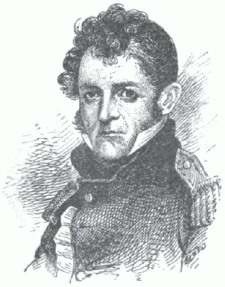 CAPTAIN DAVID PORTER.
CAPTAIN DAVID PORTER.
For several months, Captain Porter cruised about the Atlantic. He captured several English [Pg 140] vessels, and then, as he could not find the American squadron, he decided to make a trip around Cape Horn, and cruise in the Pacific.
The passage around Cape Horn is one of the most dangerous in the world, but Captain Porter was not afraid. The Essex was one of the best ships in the navy, and the crew had been drilled very thoroughly.
Sometimes Captain Porter sounded a false alarm of fire on shipboard. This was to test the courage of the men and prepare them for accidents. Sometimes he even caused a smoke to be made. The sailors soon became so accustomed to a cry of "Fire" that it caused no confusion.
The courage of the crew was severely tried in going around Cape Horn. The weather was bitterly cold, and for twenty-one days the ship was buffeted by furious storms.
By this time the provisions were almost gone. Each man had but a small daily allowance of bread and water. Little David Farragut was having his first real experience as a sailor.
From Cape Horn, Captain Porter sailed north [Pg 141] along the west coast of South America, and stopped at an island near the coast of Chili. The sailors went on shore with their guns and killed some wild hogs and horses. They were in such need of fresh meat that they ate even the flesh of the horses with great relish.
For months the Essex cruised about in the beautiful Pacific. Captain Porter captured several English vessels, and warned American whaling-ships of danger. Some of these had been at sea for many months and had not heard of the war.
Sometimes the Essex would stop at an island, and the crew would go on shore to kill seals; sometimes they would anchor in shallow bays and fish for cod.
On one solitary island there was a strange postoffice, a box nailed to a tree. Here passing vessels would leave messages and letters, to be taken up by other vessels that chanced to be going in the right direction.
The Essex stopped at this island for some time. The crew found prickly pears to eat. They killed [Pg 142] pigeons, which the cook made into pies, and they made soup of the turtles they caught. Those were great days for David Farragut.
The Essex finally left this island in May, 1813. Soon more English vessels were sighted and captured. One of these was to be taken to Valparaiso, and Captain Porter put David Farragut in charge of it. The young commander was then but twelve years of age.
The gray-haired English captain was very angry at having to take orders from a boy. He tried to ignore David, and when he failed in this, attempted to frighten him. He threatened to shoot any man who obeyed David's orders, and went below for his pistols.
David knew that the American sailors were loyal to him. So he sent word to the captain that if he did not obey, he would have him thrown overboard.
After this there was no more trouble. David brought the vessel into the port of Valparaiso in safety. He soon afterward rejoined the Essex.
Captain Porter now decided to go to some [Pg 143] islands far out in the Pacific, where he could refit the ship.
As the Essex approached one of these islands, she was met by a canoe filled with natives. The bodies of these people were tattooed, and they were gayly ornamented with feathers. They invited the sailors on shore, and promised to give them fruit and provisions.
During the six weeks that were occupied in refitting the ship, the sailors rested on the island. David and the other boys of the crew were given lessons by the ship's chaplain each day, and when school hours were over, they were allowed to visit the islanders.
The young natives taught the American boys many things. They showed them how to walk on stilts, and how to use a spear skillfully and with ease. Best of all, they taught them how to swim. The people of this island could swim as easily as they could walk. Even the babies could float in the water like ducks.
The Essex left this island in December, 1813, and sailed for Valparaiso. [Pg 144]
One day in the following February, two English war vessels appeared in the harbor of Valparaiso. The Essex was lying quietly at anchor, and many of her crew were on shore.
The British vessels bore down upon the Essex in a very hostile manner. Captain Porter was afraid they would attack him. They had no right to do this, for Chili was not at war with either England or America.
One of these British vessels was a frigate called the Phoebe. The other was a sloop named the Cherub. The Phoebe approached the Essex until she was within fifteen feet of her side.
Captain Porter, standing on the deck, hailed, saying: "If you touch a single yardarm, I shall board you instantly!" The Phoebe passed by with no reply.
After this, the British vessels anchored at the entrance of the harbor. They could thus keep the Essex a prisoner.
The vessels remained in this position for several weeks. On the 28th of March, a furious gale [Pg 145] sprang up. The cables of the Essex gave way, and she began to drift out toward the English vessels. Captain Porter now made a desperate effort to escape. He set all sails and made for the open sea.
Suddenly something snapped. The main top-mast came crashing down, carrying sails, rigging, and some of the crew into the water. In this disabled condition escape was impossible. The Essex was driven toward the shore and was finally brought to anchor within pistol shot of the beach.
The Essex had but four guns that would shoot as far as the cannon of the English. The Phoebe and the Cherub took a position out of range of nearly all the Essex guns, and then poured broadside after broadside into the unfortunate vessel.
Captain Porter and his gallant crew fought against these odds until one hundred and twenty-four of the men had been killed or wounded. Then the Essex surrendered.
During all this dreadful battle there was no braver officer than the little midshipman, David [Pg 146] Farragut. Sometimes he was carrying messages for the captain; again, he was bringing powder for the guns.
Once when going down the hatchway a wounded man fell upon him. David barely escaped being crushed to death.
Captain Porter was so pleased with his conduct that he mentioned his bravery in his official dispatches to the government.
After the surrender the wounded were removed to shore. David offered his services to the surgeons. He worked early and late, preparing bandages and waiting upon the injured men.
In speaking of this afterward, he said, "I never earned Uncle Sam's money so faithfully."
The British put all the American prisoners on board an unarmed vessel, and made them promise that they would not take up arms against the English until they had been exchanged for an equal number of English prisoners.
After this the Americans were allowed to sail for the United States. They arrived in the harbor of New York on July 7, 1814. [Pg 147]
Although a prisoner of war, David Farragut was glad to get back to the United States.
While waiting to be exchanged he attended a school in Chester, Pennsylvania.
It was a strange school. The pupils had no books. The teacher, Mr. Neif, told them the things he wished them to learn, and the boys wrote them down in notebooks. They would sometimes be examined on these notes to see whether they had paid proper attention.
In the afternoons, Mr. Neif would take the boys for long walks. They made collections of minerals and plants, and learned many curious and useful facts about them.
Mr. Neif, who had been a soldier, gave the boys military drill. He also taught them to swim and climb.
David Farragut was not a handsome boy. But people liked to look at him, for his face was honest and good. He was short for his years, but he stood very erect, and held his head as high as he could. [Pg 148]
"I cannot afford to lose any of my inches," he said.
In November, 1814, the British and the Americans made an exchange of prisoners, and David Farragut was now free to return to the navy. As a treaty of peace was made a few weeks later, he did not have to serve against the British.
During the next two years, David made but one short cruise. He was quartered, the rest of the time, on a receiving ship. This is a vessel stationed at the navy yards, where recruits are first received into the service.
In the spring of 1816, David went on a cruise that proved to be most interesting. He was ordered to the Washington, a beautiful new ship of seventy-four guns. This was to carry the American minister to Naples, in Italy.
While waiting at Annapolis for the minister they had a visit from the President, James Madison. Among his suite was Captain Porter, who was then a naval commissioner. He came to say good-bye to David.
The voyage across the Atlantic was one to be [Pg 149] remembered. The captain was very proud of his "crack" ship. He kept the crew so busy cleaning decks and scouring "bright work," that sometimes they had no food for eight hours at a time. Once all the crew were kept on deck for several nights in succession.
During the summer months, the Washington cruised about the Mediterranean, stopping at many places. This was a wonderful experience for David. He visited the bay of Naples. The great volcano, Vesuvius, was then in eruption, and the sight of this alone was worth the voyage.
While in the bay, the king of Naples and the emperor of Austria made a visit to the Washington, and a grand display was made to entertain them.
The Washington stopped at the coast towns of Tunis, Tripoli, and Algiers, and finally wintered in a Spanish harbor. The Spaniards were very kind to the captain. They allowed him to use their navy yard, in which to refit his vessel.
During all this cruise, the boys on the ship were taught by the chaplain, Mr. Folsom. [Pg 150]
He was very fond of David, and in the autumn of 1817, when he was appointed consul to Tunis, he wrote to the captain of the Washington for permission to take David with him.
This request was granted, and David spent a delightful year with his old friend. He studied mathematics and English literature. He also learned to speak French and Italian.
He and Mr. Folsom took many trips about the Mediterranean, and these were of great benefit to him. In October, 1818, he returned to the Washington, in which he cruised for another year.
While David Farragut was at a port in the Mediterranean, he was summoned to America to take his examination for the lieutenancy. He was then eighteen years of age.
In November, 1820, he arrived in New York, where he passed his examination successfully. He did not receive any appointment, however, for some time, as there were no vacancies in the navy. [Pg 151] The next two years were spent with the Porter family at Norfolk, Virginia.
In 1822, he sailed for a short time on a sloop of war, that was cruising about the Gulf of Mexico. On his return to America, he learned that Captain Porter was fitting out a fleet to cruise against the pirates of the West Indies.
These robbers had small, fast-sailing ships. They would attack unarmed merchant vessels, seize all the valuables they could carry away, and destroy the remainder. Sometimes they killed the crew; at other times they put them ashore on some desert island.
For years, Americans and English had been waging war against these pirates, but without success. With their small boats the robbers would run into the shallow bays and creeks, where no other vessels could follow them; and so they had grown bolder and bolder every year.
Ever since peace had been declared with England, Captain Porter had been a commissioner of the navy, and had made no sea voyages. But now he offered to resign his position, and drive [Pg 152] the pirates from the sea. He said he would do this upon one condition. He must have a fleet of small vessels that could follow the pirates into their lurking places.
The government accepted his offer, and gave him orders to fit out such a fleet as he chose. He bought eight small schooners similar to those used by the pirates. To these were added five large rowboats or barges, which were called the Mosquito Fleet. David Farragut was assigned to one of the vessels named the Greyhound.
This fleet of Captain Porter's had many encounters with the pirates. At one time, when the Greyhound was off the southern coast of Cuba, some of the crew went on shore to hunt game, and were fired upon from the thicket by pirates. The Americans returned this fire without effect, and then went back to their ship.
Young Farragut was ordered to take a party of men to capture the pirates, and at three o'clock the next morning they set out in the barges.
After landing, David and his men tried to go around to a point at the rear of the place where [Pg 153] the pirates were supposed to be. This was no easy thing to do. They had to cut their way through thickets of cactus, thorny bushes, and trailing vines. Their shoes were cut from their feet with walking over the sharp rocks; and the heat was so intense that some of the men fainted.
At last they found the pirate camp. It was deserted. The robbers had seen the Greyhound and the barges, and had fled to some other hiding place. In the camp, which was protected by several cannon, there were some houses a hundred feet long. There was also an immense cave filled with all kinds of goods taken from plundered vessels.
The sailors burned the houses, and carried the plunder and cannon to their boats. The prize that David himself took away was a monkey, which he had captured after a fierce struggle.
As the sailors were returning to their boats, they heard a great noise in the thicket behind them, and thought that the pirates had come back to attack them. David Farragut made a speech to his men. He urged them to stand their ground and fight [Pg 154] bravely. Imagine their surprise and amusement at finding their foes to be thousands of land crabs, making their way through the briars!
This was only one of many encounters that the Mosquito Fleet had with the pirates. Through all the time, the American sailors suffered much from yellow fever and exposure. David Farragut afterward said: "I never owned a bed during my cruise in the West Indies, but lay down to rest wherever I found the most comfortable berth."
The pirates were finally driven from the seas. Their boats were burned or captured, and their camps destroyed.
While on this cruise, David got leave of absence to visit his sister in New Orleans. She was the only one of the family still living at the old home. It was hard for her to recognize in the stranger the boy who had left home so long before.
When young Farragut was on his way to the north and within sight of Washington, he was taken ill with yellow fever. He had nursed many a poor sailor, and had hitherto escaped the disease.
After a short time spent in a Washington hospital, [Pg 155] he was able to return home. Soon afterward, he was married in Norfolk, Virginia, to Susan Marchant. But it was nearly two years before he was entirely well, and strong enough to resume his duties in the navy. In the meanwhile, he and his bride spent much time with the family of Captain Porter.
In August, 1825, David Farragut at last received his commission as lieutenant. He was ordered on board the ship Brandywine, the vessel which was to have the honor of taking the Marquis de Lafayette to France.
This great Frenchman had always been a warm friend of the United States. Fifty years before, he had taken a leading part in the Revolutionary War, and had been one of General Washington's most trusted officers.
After the Revolution, he had returned to his home in sunny France. He had always loved America, and in his old age he felt that he [Pg 156] would like to visit again the great nation which he had helped to establish. So in 1824, though old and gray, he had come back to America as the honored guest of the nation.
From one end of the land to the other, his tour had been one grand ovation. And now that he was to return home, the good ship Brandywine was detailed to carry him safely across the Atlantic.
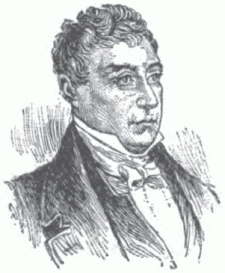 LAFAYETTE.
LAFAYETTE.
The voyage was an uneventful one for Lieutenant Farragut. After landing Lafayette in France, the Brandywine cruised about the shores of England and in the waters of the Mediterranean for about a year.
On his return to America, Lieutenant Farragut found that his wife was in very poor health, and he obtained leave of absence from the navy, in order that he might take her to a famous doctor in New Haven, Connecticut.
During his stay in that city, he regularly attended the lectures at Yale College, for David [Pg 157] Farragut never wasted an opportunity for self-improvement. When his wife was better, they returned to Norfolk, where he was placed in charge of the receiving ship in the navy yard.
Most of the boys on the ship were uneducated and did not know one letter from another. Lieutenant Farragut therefore established a school on board. This proved to be of great value to these poor boys.
One boy had run away from home to avoid going to school, and he was determined that he would not study. It was only after many severe punishments that he was conquered. When once started in the right direction, he learned rapidly.
One day, seven years afterward, a fine-looking, well-dressed man stopped David Farragut on the street. On being asked his name, the stranger replied, "I have grown probably a foot since we parted, but do you not remember the boy who once gave you so much trouble?"
"Oh yes," said Farragut, "but I should never have recognized him in you."
"Nevertheless," said the stranger, "I am the [Pg 158] same, and am ready to acknowledge you the greatest benefactor and friend I ever had in this world of trouble."
After leaving the receiving ship, Lieutenant Farragut spent the next ten years in short cruises along the South American coast and about the Gulf of Mexico. During all this time his wife was an invalid, and her health continued to fail until her death in 1840.
For two years before her death, Lieutenant Farragut was at home on leave of absence. He could then be constantly with her and wait upon her.
In speaking of his devotion to his wife, a lady in Norfolk said: "When Lieutenant Farragut dies, every woman in the city should bring a stone, and build for him a monument reaching to the skies."
In 1841 promotion came to Farragut, and he received a commission as commander in the navy.
In 1845, the state of Texas was annexed to the United States. This brought about a dispute with Mexico concerning the southwestern boundary [Pg 159] of the state, and the result was a short war, in which the Americans were victorious.
Commander Farragut was very anxious to serve his country in this Mexican War, and wrote many letters to the Navy Department, asking for the command of a ship. For a long time he waited in vain. When, at last, a vessel was assigned to him, it was too late for him to do his country any service. The war was about over, and there was no more work for the navy to do.
From 1850 until 1852, he was employed in Washington, drawing up a book of regulations for the navy. As when in New Haven he had attended the lectures of Yale College, so now he attended those of the Smithsonian Institution.
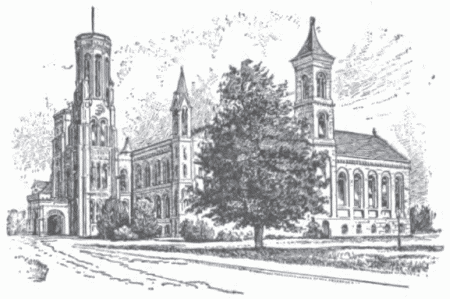 SMITHSONIAN INSTITUTION.
SMITHSONIAN INSTITUTION.
"I have made it a rule of my life to do all things with a view to the possible future. You cannot come away from such lectures without being wiser than [Pg 160] when you went in," he said. When the book of regulations was finished, he went back to the navy yard at Norfolk, where he gave a series of lectures on gunnery to the officers.
About this time, England and France were at war with Russia. Farragut applied to Congress for permission to visit the English and French fleets engaged in this war. He wished to see whether he could learn of any improvements that could be made in the American navy.
But Congress had other work for him to do. There was to be a new navy yard built on the Pacific coast, at San Francisco. This would be a difficult task, and one requiring the services of a man having great knowledge and experience. No one was better fitted to undertake it than the lieutenant who had been so eager to make use of every opportunity for improvement.
In August, 1854, he was accordingly sent to California. Some time before this, he had married a second wife, Virginia Loyall, of Norfolk, and she accompanied him to the Pacific coast. There were then no railroads across the great western [Pg 161] plains, and they went by ship to the isthmus of Panama. After crossing the isthmus, they embarked upon a coasting vessel, and sailed to San Francisco.
Commander Farragut spent four years in laying the foundations of what is to-day the great navy yard on Mare Island, about thirty miles from San Francisco.
Before this work was completed he was promoted to the rank of captain. This was, at that time, the highest rank in the United States navy.
In July, 1858, Captain Farragut returned home. He was given, at once, the command of the Brooklyn. It had been ten years since he had been on a war vessel, and he found many changes. His ship had steam power as well as sails. It was one of the first steam war vessels built for the navy.
The arrangement of the guns was the same as in the old sailing sloops. But they were much larger, and of different shape. Explosive shells were used instead of solid cannon balls.
The Brooklyn cruised for two years in the Atlantic [Pg 162] and the Gulf of Mexico. While on this cruise, Captain Farragut again visited New Orleans, for he wished to see his brother who was on duty at the naval station there. A sorrowful welcome awaited him, however, for his brother had died just before his arrival. The captain sadly returned to his ship, and soon afterward sailed home to Norfolk.
In 1861, at the beginning of the Civil War, the United States navy had but ninety vessels of all kinds. Twenty-one of these were not fit for service. Only eleven of those in commission were in American waters. The rest, which were scattered all over the world, were recalled at once.
Some of those in far away ports were commanded by southern captains, and it would take them several months to reach America.
It was feared that they would take their vessels into southern ports, and turn them over to the Confederate government. These fears, however, [Pg 163] were groundless, for all the vessels were safely brought into northern ports. With few exceptions, all the naval officers were loyal to the United States.
Of all these naval officers, none was more loyal than Captain Farragut. In his home in Virginia, he had watched the growing troubles with a sad heart. He was a southerner by birth, and his most tender ties were in Virginia. It was there that he had spent many years with the Porter family, and there he had numerous friends. It was there, also, that he had married and made his home.
He knew that, should war break out, he would be called upon to choose between his friends in the South, and his government in the North.
"God forbid," he said, "that I should have to raise my hand against the South." These very words showed that his decision had been made.
He felt that he owed his first allegiance to the United States government, which had given him his education, employment, and rank. He could not take up arms against the flag of his country. It was under this flag that he had received his first [Pg 164] commission as midshipman. In that proud moment he had taken his oath to die in its defense.
On the ocean, he had seen the proudest colors lowered to the victorious stars and stripes. At Valparaiso, he had stood on the bloody deck of the Essex, and had seen men give their lives in order that the flag should not be hauled down. He had traveled from ocean to ocean, and had seen the star spangled banner respected by all nations.
For some weeks before the actual beginning of war, there was much excitement in Norfolk. Every day the men met together in the stores to talk over the latest news, and there were many lively discussions among them. In these meetings, Captain Farragut boldly asserted his loyalty to the government, and this caused him the loss of many of his friends.
One morning, when in discussion with some officers, one of them said to him, "A person of your sentiments cannot live in Norfolk."
"Well, then," he calmly replied, "I can live somewhere else." [Pg 165]
He felt that the time for action had come. He went home at once, and told his wife that he was going to "stick to the flag," and that they must move to the North.
With sad hearts, they sailed away from Norfolk.
They went to New York, and made their home on the Hudson, in a town called Hastings.
Even there, Captain Farragut met with a cold reception. The people were suspicious of the southern officer who had come to live among them. They did not consider the great sacrifice that he had made in leaving home and friends.
Determined to do his duty, he wrote to offer his services to the government. Congress could not, at once, accept them. No minor position could be given to Captain Farragut; it must be one full of responsibility.
It was not long, however, until the government had need of his services. The Mississippi River separated two large sections of the southern states, and its control was of the greatest importance to both the North and the South.
At the beginning of the war, all the river from [Pg 166] Cairo, Illinois, to the Gulf, was controlled by the South. The capture of the upper forts in this section was first attempted by the North.
Large armies marched against them by land, and a fleet of river gunboats sailed down from the north to assist them. These gunboats were river steamers which the government had covered with plates of iron and armed with cannon.
While the northern river forts were thus being attacked, an expedition was planned to capture the fortifications near the river's mouth.
The strongest of these were Fort Jackson and Fort St. Philip. These were between New Orleans and the Gulf of Mexico, and their capture would give New Orleans to the North. This was considered a very important undertaking.
After much discussion, the Navy Department decided that Captain Farragut was best fitted to command this expedition. So Commander David D. Porter was sent to Hastings to talk the matter over with him. This commander was the son of the Captain Porter who had adopted David Farragut when a boy. [Pg 167]
When Captain Farragut heard of the proposed expedition he was very enthusiastic. He hurried at once to Washington, where he was appointed commander of the Western Gulf Blockading Squadron. This was in January, 1862. His orders were to capture Forts Jackson and St. Philip, and take New Orleans.
A few weeks before this an event took place which came near making serious trouble for the United States. The Confederate government had appointed two commissioners, John Slidell and James Mason, to go to England to see if they could not get help from that country.
As it would be dangerous for them to sail in a Confederate vessel, they went to Havana, Cuba, where they took passage in an English vessel named the Trent.
Although they had tried to do this very secretly, Captain Wilkes, commanding a warship of the United States, heard about it, and determined to capture these men, if possible. So he pursued the Trent and obliged her to stop.
The Confederate commissioners refused to leave [Pg 168] the Trent, and, therefore, Captain Wilkes sent an armed force on board and carried them off. He then took them to Boston harbor, where they were imprisoned in a fort of the United States.
This act caused great indignation in England, and it was only through the prompt and wise action of President Lincoln and Congress that war was averted. An apology was made and the Confederate commissioners were allowed to proceed on their voyage without further molestation.
On the 2d of February, 1862, Captain Farragut sailed from Hampton Roads in his flagship, the Hartford. This was one of the new sloops of war having both steam and sails.
All the vessels of this expedition were to meet at Ships Island, about one hundred miles from the mouth of the Mississippi. When Captain Farragut arrived there on February 20th, he found only a part of his fleet awaiting him. The other vessels arrived one by one. [Pg 169]
This was the most powerful squadron that had ever been under an American commander. It consisted of steam sloops, gunboats, and mortar boats, forty-eight vessels in all.
An army of fifteen thousand men was at hand to assist Captain Farragut. This army had been brought from the North on transports, and was under the command of General Benjamin F. Butler.
 THE HARTFORD.
THE HARTFORD.
In the channel, at the mouth of the Mississippi, were heavy mud banks, made of deposits brought down by the stream. To take the large vessels over this bar was Captain Farragut's first great task. The water was so shallow that the keels of the ships would sometimes stick in the mud, and then it was with the greatest of difficulty that they could be hauled off. [Pg 170]
It was the 18th of April before all the vessels were in the river and ready to attack the forts; and in the meanwhile, a great naval battle had been fought in other waters.
The Confederates had captured the Norfolk navy yard, and with it the United States vessel Merrimac, which was there at the time. They removed the masts of this vessel, and then fitted her with an iron prow, and built sloping sides over the deck, covering them with iron rails laid closely together side by side.
Five of the best Northern war vessels lay in the bay outside of the harbor.
On March 8th, 1862, the Merrimac attacked this fleet. She drove her iron prow straight through the side of the Cumberland. This vessel sank almost immediately, and but few of the men were saved.
Then the Merrimac attacked the Congress, drove her ashore, and set her on fire with red hot shot. Meanwhile, broadside after broadside had been fired at the Merrimac; but the shot bounded harmlessly from her sloping iron sides. [Pg 171]
Night came on, and before attempting to destroy the other three ships, the black monster waited for the daylight.
There was consternation all through the North. How could a stop be made to this fearful work of the Merrimac? There was no telling what she might do on the morrow.
That same night there steamed into Chesapeake Bay a queer looking little vessel which had been built by a famous mechanic, Captain John Ericsson. She was named the Monitor. She had a low, flat deck, pointed at both ends. In the center was a round, revolving turret. The vessel was completely plated over with iron, and in the turret were two enormous guns, larger than any that had ever been used before.
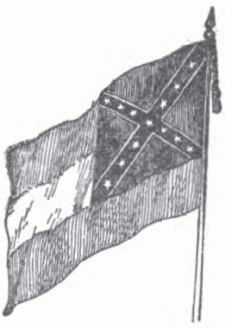 CONFEDERATE FLAG.
CONFEDERATE FLAG.
On the morning of March 9th, when the Merrimac steamed out to finish her work of destruction, a stupendous cannon ball came thundering against her black side. As the turret of the little Monitor swung round, there came another and [Pg 172] another,—such a battering as never ship's side had felt before that day.
The broadsides returned by the Merrimac fell harmlessly on the flat deck and iron turret of the Monitor.
This battle lasted for nearly three hours. Neither vessel was injured to any extent. Finally the Merrimac withdrew, leaving the Monitor in possession of the bay.
In one respect, this was the most wonderful battle ever fought upon the water. It showed to all the nations of the world that new navies must be built. In one day all the war-ships in the world had become old-fashioned. The days for wooden war vessels were over.
Let us now return to Captain Farragut. As I have said, by the 18th of April he had succeeded in taking all his vessels over the bar of the Mississippi. But still greater difficulties were ahead of him.
Before he could capture New Orleans, he must pass the two forts, Jackson and St. Philip, on opposite banks of the river. First of all, however, [Pg 173] he must break through a barricade which was below the forts. This reached from shore to shore, and was made of old hulks of vessels and cypress logs, fastened together with huge iron chains.
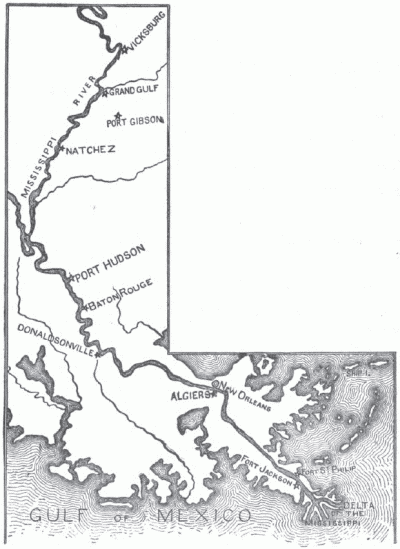 MAP OF THE LOWER MISSISSIPPI.
MAP OF THE LOWER MISSISSIPPI.
Should the barricade be broken and the forts passed, there was still a Confederate fleet to be overcome. This consisted of fifteen ships, gunboats, [Pg 174] and steam rams similar to the Merrimac. They were drawn up across the river above the forts. Captain Farragut was not discouraged by any of these things, but began at once to carry out his plans.
All along the banks of the river were thick woods. The forts themselves were almost hidden by the trees. Captain Farragut stationed his mortar boats close to the banks, below the chain barricade; and, in order that they might be better hidden from the forts, large branches of trees had been tied to the tops of the masts.
This mortar flotilla was commanded by Captain Porter. The mortars could throw thirteen-inch shells for a distance of two miles.
Captain Farragut's plan was to send these mortar boats forward to bombard the forts, while the other vessels, breaking through the chains, should sail boldly up the river.
On the morning of April 18th, the shells from the mortars began to rain down upon the forts. For six days and nights this firing never ceased. The answering shots from the forts did but little [Pg 175] harm. The Confederates could not take aim at boats which they could not see.
Meanwhile, two of Captain Farragut's gunboats crept up the river at night, and broke a passage through the chain barricade. Then, on the night of April 23d, the entire fleet sailed through this opening and boldly attacked the forts.
The whole river was at once a scene of confusion. Every gun, both of the forts and of the Confederate fleet, which had hastened down the river, was sending shot and shell into the Union fleet.
The Confederates piled every kind of inflammable material upon huge rafts, set them on fire, and sent them floating down the river. They hoped, in this way, to burn the invading fleet. The river was a blaze of light. The din from the cannon was terrible.
But Captain Farragut and his vessels kept steadily on. They passed the forts, and destroyed or captured every vessel in the Confederate fleet. This was accomplished with the loss of but one ship of the Union squadron. [Pg 176]
When the news of this victory reached New Orleans, the whole city was thrown into wild confusion. Men, women, and children rushed to the levee and set fire to the goods there.
Everything that would burn was set on fire, and sent down the river to meet the victorious fleet that was coming. Ships loaded with burning cotton, and even a half-finished ram like the Merrimac floated down stream, a mass of flames.
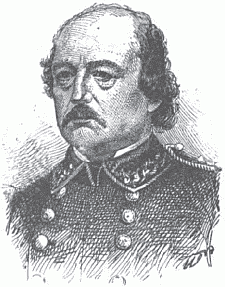 GENERAL B.F. BUTLER.
GENERAL B.F. BUTLER.
About noon on April 25th, the fleet rounded the bend of the river, and came in sight of the city. That same morning, the mayor of New Orleans had ordered the state flag of Louisiana to be hoisted upon the city hall.
Captain Farragut demanded that this should be hauled down. He also ordered that the stars and stripes should be raised over the buildings belonging to the United States government. [Pg 177]
Meanwhile, Commander Porter with his mortar boats had been steadily bombarding Fort Jackson and Fort St. Philip. On April 28th, these forts surrendered, and the Union forces took possession.
On the following day, the flag of the United States was floating over the city hall of New Orleans. General Butler and his troops took possession of the city on the first of May.
On the 11th of July, on the recommendation of President Lincoln, Congress passed a resolution thanking Captain Farragut for what he had done; and a few days later he was further rewarded by being raised to the rank of rear-admiral.
After the capture of New Orleans, Admiral Farragut was ordered at once to proceed up the river. He was to pass, or to attack and capture, all the Confederate forts between New Orleans and Memphis.
But for many reasons, he thought it unwise to attempt this expedition. [Pg 178]
The increasing shallowness of the river would make it almost impossible to use his best sea-going vessels. The upper forts were located on high bluffs, and it would be difficult to attack them from the river.
Admiral Farragut knew that, should he be able to pass these forts, or even to silence their guns, he could not hold them without a large land force. But he was too good a soldier to do anything in disobedience to orders.
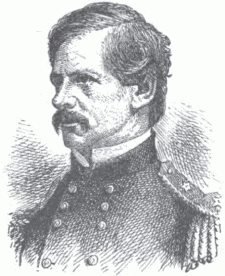 GENERAL N.P. BANKS.
GENERAL N.P. BANKS.
In the face of all these difficulties, he passed and repassed the forts at Vicksburg and Port Hudson. He made it plain to the Confederates that none of their batteries on the Mississippi could stop the movements of his fleet. But he found, as he had expected, that the forts could not be held until armies came to his assistance.
A large land force under General Grant besieged [Pg 179] Vicksburg until it surrendered on July 4, 1863. Five days later, an army under General Nathaniel P. Banks succeeded in capturing Port Hudson.
These were the last Confederate strongholds on the Mississippi. Their capture gave to the Union forces the entire control of the river.
The command of the Mississippi squadron was given to David D. Porter, who had likewise been rewarded with the rank of rear admiral. He took charge of all the river boats of the fleet, while Farragut, with most of the sea-going vessels, sailed for the Atlantic coast.
 ADMIRAL DAVID D. PORTER.
ADMIRAL DAVID D. PORTER.
These vessels were all in need of repairs. His flagship, the Hartford, which was in the best condition of all, had two hundred and forty scars from shot and shell.
After the loss of New Orleans, Mobile was the best Gulf port left to the Confederates. This city [Pg 180] stands at the head of the broad, shallow bay of Mobile, thirty miles from the Gulf.
The entrance to the bay is very narrow, and it was protected by two strong forts,—Fort Morgan on one side, and Fort Gaines on the other.
Admiral Farragut was ordered to capture these forts. This would prevent the South from using the port of Mobile.
On January 18th, 1864, his ships having been repaired, Captain Farragut sailed again into the Gulf of Mexico.
He was anxious to make the attack early in the spring, but it was August before his fleet was ready.
In the meantime, the Confederates had made their fortifications stronger. The only channel through which the vessels could pass was near Fort Morgan. The Confederates strengthened this fort with every defense possible.
A double line of torpedoes, or submarine mines, was stretched across the channel. Above this, lay the Confederate fleet. One of these vessels, the Tennessee, was a huge iron ram like the Merrimac. [Pg 181]
The squadron of Admiral Farragut was a strong one. There were twenty-four wooden war vessels and four ironclads like the Monitor.
On the night of August 4th, every preparation was made for the attack. The seamen, with determined faces, gave their messages and keep-sakes to their messmates, for they hardly expected to come out of this fray alive.
Admiral Farragut, himself, made all his arrangements for the worst, though hoping for the best. He wrote to his wife, "I am going into Mobile in the morning, if God is my leader, as I hope He is, and in Him I place my trust. If He thinks it is the place for me to die, I am ready to submit to His will. God bless and preserve you, if anything should happen to me."
At sunrise the fleet moved steadily toward Fort Morgan, the stars and stripes flying from every masthead.
The four ironclads were sent ahead, close to the forts. The wooden war vessels followed, lashed together in pairs. This was done so that if one vessel became disabled it could be towed by the [Pg 182] other. Farragut wished to lead the fleet in his flagship, the Hartford, but his officers dissuaded him, and the Brooklyn went first, the Hartford following.
The admiral climbed up in the rigging, where he could command a view of the entire fleet. As the shells from the forts began to fall about the vessels, he climbed higher and higher, in order to see above the smoke.
Fearing that a shot would cut the ropes, one of his officers climbed up to him and wound a rope around his body. The end of this was secured to the mast.
The ironclad Tecumseh was now leading the fleet. Suddenly there was a muffled explosion. The stern of the Tecumseh rose out of the water and she plunged bow foremost to the bottom of the channel.
At this, the Brooklyn stopped, and with reversed engines began to back water. Admiral Farragut signaled, and asked, "What's the trouble?" "Torpedoes," was the reply.
This was the critical moment of the battle. [Pg 183] The backing of the Brooklyn caused confusion among the vessels following so closely upon each other. There was tremendous cheering and firing from the Confederates. They were sure that the victory was theirs.
A signal was made to the Brooklyn to go ahead, but she remained motionless.
What should be done? To remain there, under the guns of the fort, with the other vessels coming up behind, was out of the question. Ahead lay the dreaded line of torpedoes. Everything depended upon prompt decision.
Admiral Farragut ordered the Hartford to go ahead, "full speed." She passed the Brooklyn, and made straight for the mines that had sunk the Tecumseh. As they crossed the line of torpedoes, the sailors could hear them grating against the hull of the vessel. None of them exploded, however, and the Hartford passed the fatal line in safety.
The effect of this daring deed was wonderful. Men sprang to the guns, and the air was filled with the roar of cannon. The other vessels all [Pg 184] followed the Hartford across the torpedoes, into the bay. They then attacked the Confederate fleet, and soon either captured or destroyed all but the ram Tennessee. This vessel had taken refuge under the guns of Fort Morgan.
Admiral Farragut then anchored about four miles up the bay. While his men were having breakfast the iron ram steamed out boldly from the fort to attack the whole fleet.
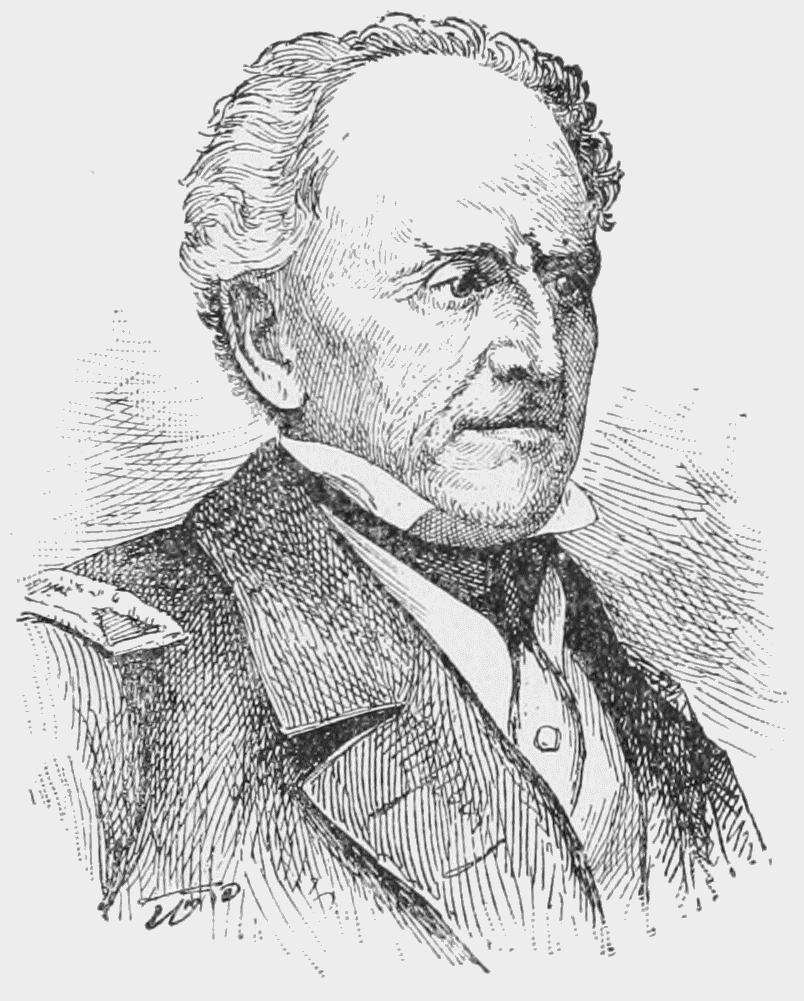 ADMIRAL BUCHANAN.
ADMIRAL BUCHANAN.
Admiral Buchanan, the commander of the Confederate fleet, was a brave officer. Not until after a fierce combat, which lasted over an hour, was he forced to surrender the Tennessee.
This ended the battle of Mobile Bay. "It was one of the hardest earned victories of my life, and the most desperate battle I ever fought since the days of the Essex," said Farragut.
Not quite three hours had passed from the time [Pg 185] that Fort Morgan fired its first gun until the Tennessee surrendered.
With the Confederate fleet destroyed, and Mobile Bay in possession of Farragut, the forts were soon captured.
While Farragut had been winning these victories in the Gulf, a very brilliant naval battle had been fought off the coast of France.
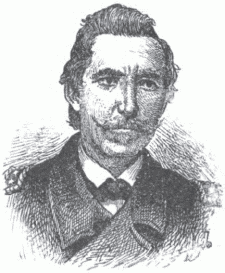 CAPTAIN RAPHAEL SEMMES.
CAPTAIN RAPHAEL SEMMES.
During the whole of the war, England had allowed the Confederates to fit out armed cruisers in her harbors, and to send them out to prey upon the United States commerce. The most famous of these cruisers was the Alabama, commanded by Captain Raphael Semmes. For two years this vessel had roamed the sea, burning and destroying nearly forty United States merchantmen, but always eluding the war vessels.
At last, in June, 1864, the United States war [Pg 186] vessel Kearsarge discovered this enemy in the harbor of Cherbourg, France. As it would have been against the laws of nations to fight a battle in the harbor, the Kearsarge remained outside to prevent the Alabama from getting away.
Finally on Sunday, June 19th, the Alabama suddenly put to sea and attacked the Kearsarge. The vessels were evenly matched.
The battle following was terrific. But the crew of the Kearsarge proved to be the better marksmen, and after an hour's furious fighting the Alabama suddenly gave a great lurch and plunged to the bottom of the ocean: The crew were picked up by the Kearsarge and some English vessels which happened to be near.
After the surrender of the forts, Farragut remained in Mobile Bay until the following November. His health was suffering from his labors and the effects of the southern climate.
At this time, the Navy Department requested [Pg 187] him to take command of an expedition against Fort Fisher. This greatly disturbed him, and he wrote to the Secretary of the Navy that his strength was exhausted.
"I am willing," he said, "to do the bidding of the government as long as I am able. I fear, however, that my health is giving way. I have now been down to the Gulf five years out of six, and I want rest if it is to be had."
When the Secretary of the Navy realized the condition of his health, Admiral Farragut was granted the much needed furlough.
Leaving his squadron in charge of an efficient officer, he sailed north in November, 1864. As his flagship entered New York harbor, it was met by a committee of city officials and citizens. Enthusiastic crowds greeted him as he landed, and a reception in his honor was held at the custom-house.
A few days later, a committee of citizens sent him a request to make his home in New York. With this request came a gift of $50,000. In December, Congress created for him the grade [Pg 188] of vice-admiral. All these honors were gratefully and modestly acknowledged by him.
In the spring of 1865 peace was declared, and Admiral Farragut went for a visit to Norfolk. He found that many of his old acquaintances still felt very unfriendly towards him for having taken up arms against the South. Although this pained him deeply, he said that he had never regretted having done his duty.
In 1866, the government gave him the title of Admiral. This title made him commander of the whole American navy. It was a rank created especially for him. The government could give him no higher honor.
In 1867, he was appointed commander of the European squadron. Without any request from him, the government sent permission for Mrs. Farragut to accompany him on this cruise. On June 28th, they sailed from New York on the steam frigate Franklin.
This foreign cruise was more like the triumphal progress of a king than the official visit of a naval commander. He dined with the emperor of [Pg 189] France and the queen of England. He visited the ports of Russia, Holland, and Belgium. He sailed again through the blue Mediterranean, visiting the places he had seen on his former cruise. A special excavation of the buried Pompeii was made for his benefit. At Malta, a grand reception was held in his honor.
But most of all, he enjoyed a visit to his father's Spanish birthplace. This was in the island of Minorca, just off the eastern coast of Spain.
He was to visit the little city on the day before Christmas. The news of his coming had spread rapidly to all parts of the island, and a general holiday had been proclaimed.
At every village on the way crowds of men and women came to meet him and bid him welcome. All along the route soldiers had been stationed to pay him honor, and give him any assistance that he might need.
Four miles from the city gates he was met by a large committee of citizens, and transferred to a handsome carriage.
The city walls, housetops, and balconies were [Pg 190] crowded with men, women, and children. One old man, with tears streaming down his face, shouted: "He is ours! He is ours!"
The admiral was entertained at the mansion of one of the prominent citizens. A band of music played in the vestibule, while the people came in crowds.
Early the next day, surrounded by an excited throng, he was escorted to all the places of interest. They finally went to the great cathedral, where the organ pealed forth the American national airs.
This was the last place the admiral visited before his return to America. He landed in New York, November 10th, 1868.
The following summer, he made a trip to the Pacific coast, to visit the navy yard at Mares Island. You will remember that, years before, he had laid the foundations of this navy yard.
Returning from San Francisco to the East, he was taken very ill in Chicago. By careful nursing he was able to resume the journey. But he never regained his lost strength, and his health continued steadily to fail. [Pg 191]
The following summer the Navy Department placed a steamer at his disposal, and with his family he visited Portsmouth, New Hampshire.
This was his last sea voyage. As the ship came into harbor, he arose from his sick bed at the sound of the salute being fired in his honor.
Dressed in full uniform, he went on deck. Looking up with a sad smile at his flag flying from the masthead, he said: "It would be well if I died now in harness."
Shortly after his arrival he wandered on board a dismantled sloop, lying at the wharf. He looked about the ship, and, as he left her to go ashore, he said: "This is the last time I shall ever tread the deck of a man of war."
This proved to be true. On August 14th, 1870, surrounded by his family and loving friends, he died. He was sixty-nine years old.
The government sent a steam frigate to take his body to New York. On the day of his funeral, the whole city was in mourning. The buildings were draped in black. Bells were tolled and guns fired. [Pg 192]
His body was laid in Woodlawn Cemetery. Heading the procession was General Grant, then the President of the United States. Following were many military and naval officers, and thousands of soldiers.
The government erected a bronze statue in his honor. This is in the national capital, in Farragut Square.
Thus ends the story of the life of America's first admiral, the story of a man who won fame and glory by constant effort for self-improvement and strict adherence to duty.
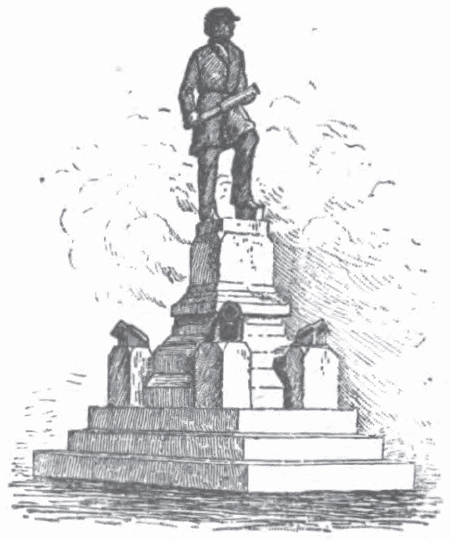 MONUMENT TO FARRAGUT AT WASHINGTON.
MONUMENT TO FARRAGUT AT WASHINGTON.
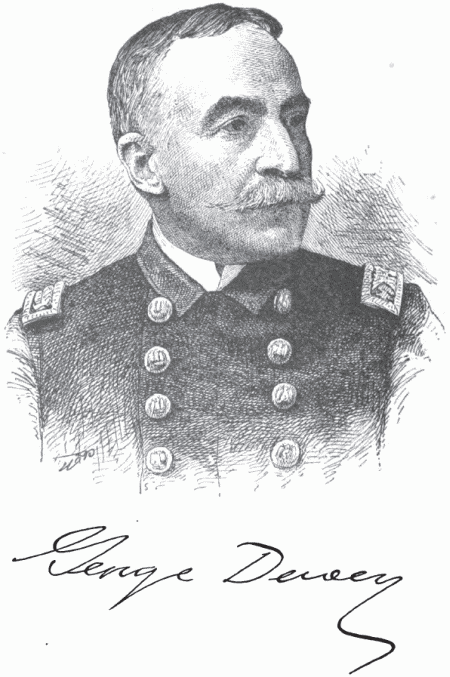 George Dewey
George Dewey
On the 23d of April, 1898, war was declared between the United States and Spain. To understand how this came about, we must go back a great many years.
Ever since the island of Cuba was discovered by Columbus in 1492, the one thought of the Spaniards has been to gain wealth from the island without giving anything in return.
For many years, most of the Cubans have been little better off than slaves. They have always been very poor and have had to do the hard work on the plantations and in the cities. At best, they have never been able to make much more than enough to pay the taxes imposed upon them by the Spanish government.
The island has been ruled by governors sent out from Spain. Many of these have been very bad men whose only desire has been to get rich and return home. For a long time the Cubans have wished to choose their own governors, and they have frequently tried, by force, to secure the right to do this. [Pg 196]
From 1868 to 1878, there was a rebellion known as the "Ten Years' War." But, one by one, the insurgent bands were scattered and their leaders killed. This war left Cuba with a heavy debt, and the people poorer than ever.
The conduct of the Spaniards, after this war, was more cruel and oppressive than before. Fifty thousand soldiers were sent to the island to preserve peace. The people were forced to pay for the support of this army, and the taxes were almost unendurable.
At last, in 1895, some of the Cubans resolved to stand it no longer. They formed an army whose watchword was "Cuba Libre," meaning "Free Cuba," and began another war with Spain.
The Spanish governor, General Campos, tried in vain to conquer these insurgents, and was finally recalled to Spain. General Weyler, who was sent in his place, proved to be a very cruel man.
He surrounded the larger towns with trenches and barbed wire fences, and built wooden forts or blockhouses for his soldiers. Into these fortified towns, thousands upon thousands of poor country people were driven, their homes having been burned and their fields destroyed.
The sufferings of these poor people were terrible. They were huddled together in sheds and huts without the means even of obtaining food. Sometimes several families were packed into one little palm-leaf hut where they had foul [Pg 197] air, foul water, and almost nothing to eat. Thousands of men, women, and children died from starvation and disease.
General Weyler hoped by these cruel means to starve the insurgents into submission, but the war went on just as before. Throughout the island a terrible work of destruction was carried on by both the insurgents and the Spaniards. Railroads were destroyed, and buildings and plantations were burned.
The people of the United States had heard of all these things, but for a long time did not do anything to stop them. But when the American consul at Havana, General Fitzhugh Lee, reported that many Americans were among the starving, they could endure it no longer. Food and supplies were sent through the Red Cross Society, and a little of the suffering was thus relieved.
Matters grew steadily worse in the island until President McKinley felt obliged to warn the Spanish government that they must soon end the war. He declared that if this was not done, the United States would recognize Cuba as an independent country.
Spain became alarmed at this, and, in October, 1897, the cruel Weyler was recalled, and General Blanco was sent in his place. This new governor tried to stop the war by granting to the Cubans some of the rights they demanded. He allowed them to hold some of the offices. [Pg 198] He released the American political prisoners, and set free the starving country people.
But it was too late. The crops had been destroyed and the people could not get a living. The Cuban army would not be satisfied with anything less than independence, and so the fighting continued.
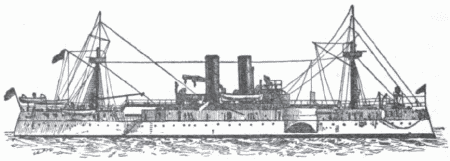 THE MAINE.
THE MAINE.
At last an event took place which aroused the people of the United States to a deeper interest in Cuba than before. The United States battleship Maine, commanded by Captain C.D. Sigsbee, had been sent on a friendly visit to Havana. On the 15th of February, 1898, while lying in the harbor, she was destroyed by a fearful explosion. Two hundred and sixty-six officers and men were killed.
President McKinley immediately appointed a committee to find out, if possible, the cause of the disaster. These men reported that the Maine was destroyed by a submarine mine; but they could not find out who had placed it in the harbor or who had exploded it. [Pg 199]
There was intense excitement all over the United States during this investigation. Senator Proctor and others went to Cuba to see for themselves if the reports of the suffering there were true. When they came back, they told the people what they had seen. Senator John M. Thurston made a speech in Congress in which he said:
"I never saw so pitiful a sight as the people at Matanzas. I can never forget the hopeless anguish in their eyes. They did not ask for alms as we went among them. Men, women, and children stood silent, starving. Their only appeal came from their sad eyes.
"The government of Spain has not and will not give a dollar to save these people. They are being helped by the charity of the United States. Think of it! We are feeding these citizens of Spain; we are nursing their sick; and yet there are people who say that it is right to send food, but that we must keep hands off. I say that the time has come when muskets should go with the food."
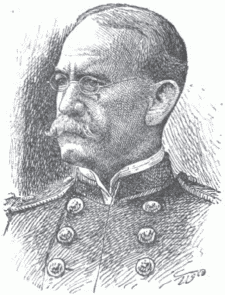 CAPTAIN SIGSBEE OF THE MAINE.
CAPTAIN SIGSBEE OF THE MAINE.
Most of the members of Congress agreed with Senator Thurston. On the 19th of April, 1898, they passed a resolution [Pg 200] authorizing President McKinley to use the army and navy of the United States to force Spain to abandon all claim to the island of Cuba.
Spain was not willing to give up her control of the Cubans, and therefore war was formally declared. It was only a few days until actual hostilities began.
It is the purpose of the following chapters to relate the story of the short but decisive struggle which followed. In that struggle the navy of the United States bore by far the largest share, and it is therefore of the navy and of the brave officers who commanded it that we shall have the most to say. [Pg 201]
On the morning of May 1, 1898, in the harbor of Manila, one of the most remarkable naval victories in the history of the world was won by the United States. The Spanish fleet, though superior in both men and guns, was entirely destroyed, and hundreds of officers and men were made prisoners. All this was accomplished by an American squadron under Commodore George Dewey, without the loss of a ship or a man. The way in which it all came about was as follows:
When war was declared between the United States and Spain, Commodore George Dewey was at Hong Kong, China, with that part of our navy which was known as the Asiatic squadron. He was at once ordered to sail to the Philippines, and capture or destroy the Spanish fleet there. [Pg 202] These Philippine Islands are about six hundred miles southeast of Hong Kong. Their capital and largest city is Manila, on the island of Luzon.
As Commodore Dewey sailed out of the bay at Hong Kong, he signaled to his fleet: "Keep cool and obey orders."
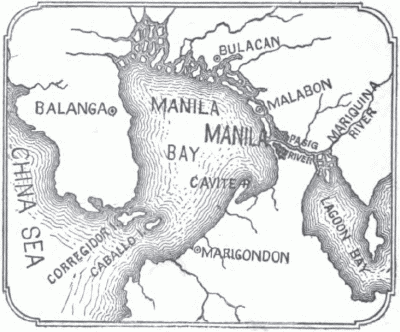 MAP OF MANILA BAY.
MAP OF MANILA BAY.
At a little before midnight, on the 30th of April, the American vessels in single file, led by the flagship Olympia, steamed between the forts which guarded the entrance to the bay of Manila.
In order not to be seen from these forts, all the lights on the vessels were hidden. Silently and [Pg 203] steadily the vessels moved on, unseen by the Spaniards.
All of the fleet except the Boston and McCulloch had passed in safety, when the soot in the smokestack of the McCulloch caught fire. Instantly the guns of one of the Spanish batteries were turned upon the fleet. The Boston and McCulloch returned the fire, but kept on their way and were soon out of range, having received no injury.
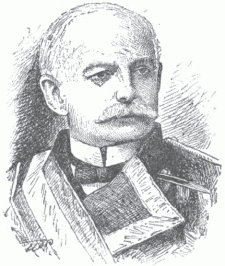 ADMIRAL MONTOJO.
ADMIRAL MONTOJO.
When day broke, Commodore Dewey found the entire Spanish fleet drawn up under the protection of the batteries of the Cavité naval station about nine miles from the city of Manila. It was commanded by Admiral Patricio Montojo, one of the ablest officers in the Spanish service.
At about five o'clock, with the flagship leading, the Americans bore down upon the Spanish. Suddenly there was a muffled roar, and a submarine [Pg 204] mine exploded. But, in the excitement, the Spaniards had fired it too soon, and no damage was done.
This was soon followed by the explosion of another mine, but again the Spaniards had been in too great haste, and the Olympia escaped uninjured.
Although Commodore Dewey did not know but that many other torpedoes might be in his path, he never hesitated. He had been in the battle of Mobile Bay with Farragut, when that brave commander had sailed boldly over a line of torpedoes.
Soon the guns of the batteries and Spanish fleet began to pour a storm of shot and shell at the American squadron. But, as yet, Commodore Dewey had not fired a gun.
The American sailors were wild with excitement. They had been by the guns all night, and were eager to begin the fray. Finally Commodore Dewey said quietly to the captain of the Olympia: "You may fire when ready, Gridley."
The flagship was now within range, and suddenly one of the great guns sent an answering [Pg 205] shot. As its echoes went rolling across the waters, every man in the American fleet joined in the shout, "Remember the Maine!" These words were the battle cry at Manila Bay.
Slowly the American vessels steamed by the Spanish squadron in single file, pouring in deadly broadsides as they passed. Then turning, they retraced their course, drawing a little nearer to the shore. This maneuver was repeated five times. The marksmanship of the Americans was wonderful, and at the end of two hours nearly every ship in the Spanish fleet had either been sunk or was on fire.
At seven o'clock Commodore Dewey decided to withdraw out of range of the batteries, to give his men a rest and breakfast, and find what damage had been done to his own fleet. Imagine his surprise and joy at finding that not a single man had been killed, and that his vessels were scarcely injured.
At eleven o'clock the Americans returned to the attack, soon silenced the forts, and burned or captured all that remained of the Spanish fleet. [Pg 206]
As soon as the battle was over, Commodore Dewey and his men set to work to care for the wounded Spanish sailors. They treated them like brothers, doing everything possible for their comfort.
After taking possession of the arsenal at Cavité, Commodore Dewey blockaded the port of Manila, and awaited further orders from the department of war. He knew that if the city of Manila could be captured, it would result in the loss, by the Spaniards, of the entire Philippine group.
These islands form one of the largest groups in the world, and are so rich and beautiful that they are called the "Pearls of the Ocean." They were the most important of the colonial possessions of Spain.
When the news of the victory reached the United States, there was great rejoicing all over the land, and Commodore Dewey was the hero of the hour. Congress at once gave him a vote of thanks, and promoted him to the rank of rear admiral. It also presented him with a beautiful sword, and gave a medal to each one of his men. [Pg 207]
Who was this George Dewey who won that famous victory in the Bay of Manila? He was a native of Vermont, and had spent the greater part of his life on the sea with the American navy.
He was born in Montpelier on the day after Christmas, 1837. Montpelier was a pleasant place in which to live. There were hills to climb, and a pretty little river ran through the fields and gardens behind the Dewey home. Here George could wade, sail boats, and fish.
Although he was not fond of books, he never tired of Robinson Crusoe. With his sister Mary as Friday, he tramped many times over the hills playing that they were shipwrecked on an island.
Sometimes George's love of adventure got him into trouble. One day he read how the famous Hannibal marched, with an immense army, over the Alps in winter. The winters in Vermont are very cold, and to the ten-year-old boy the snow-covered hills around Montpelier were as good as [Pg 208] the Alps. So, with his sister Mary for an army, the youthful Hannibal started on his march. The campaign proved to be too severe for faithful Mary, and she was sick in bed for a week.
When about eleven years of age, George was sent, one day, on an errand. As it was a long distance, he was allowed to take his father's horse and buggy, and one of his boy friends for company.
On the way they came to a ford which, though usually shallow, was swollen with recent rains. When his companion wished to turn back George said, "What man has done, man can do," and drove, full speed, into the river. The buggy, horse, and boys were soon floundering in the rapid current.
When the top and box of the buggy began to float down stream, George never lost his presence of mind. Commanding his frightened comrade to follow him, he climbed upon the horse, and the boys reached the shore in safety.
When he returned home, George did not try to escape punishment, but administered it to himself [Pg 209] by going to bed without any supper. But when his father came to his room and began to scold him, he thought it was a little too much. In his lisping voice he replied: "You ought to be thankful that my life wath thpared."
But George Dewey did not play all the time. His father was a good and wise man, and believed that a thorough education was one of the most important things of life. He obliged George to go to school regularly and conduct himself becomingly.
George had an experience in his first school which he never forgot. The scholars were an unruly set, and they had proved too much for several teachers. When, one day, a new master, Mr. Pangborn, arrived, the boys began as usual to make trouble. George was directed to perform some task and he flatly refused. In a moment Mr. Pangborn seized him and gave him the worst whipping that he had ever had.
Nor was this all. When he had finished, Mr. Pangborn marched the unruly George home to his father, the whole school following in the rear. [Pg 210] When Dr. Dewey heard the story, he told George that if Mr. Pangborn's punishment was not sufficient, he would administer more.
This settled the matter of disobedience for George. He was too manly a boy not to admire his fearless teacher. They grew to be great friends, and when Mr. Pangborn started a school of his own in Johnson, Vermont, George asked to be allowed to attend. This request was granted willingly.
When George was fifteen years old, he was sent to a military school at Norwich, Vermont. He liked the training so well that he decided to try to get an appointment in the Naval Academy at Annapolis.
One day he told one of his school fellows, George Spalding, what he intended to do. "Why, Dewey," said Spalding, "that is what I am going to do myself." Spalding received the coveted appointment, but as he was not able to go, George went in his place. [Pg 211]
George Spalding became a minister, and when the news of Admiral Dewey's victory at Manila reached the United States, he preached a sermon about it in his church at Syracuse, New York.
The boy who goes to the Naval School at Annapolis must be ready to work hard with both his hands and his brain. The discipline is rigid and no favors are shown or allowances made.
George Dewey was seventeen years old when he entered the Academy. He was a strong, active boy, and fond of outdoor sports. He was also a lad with whom no one could trifle.
One day one of the cadets called him insulting names. George promptly knocked him down. Soon afterward another cadet tried to test the courage of the "new boy," but received a worse thrashing than the first one had.
The cadets, however, were a manly set, and they admired George for his courage in defending his rights. Long before the four years' training had expired, George was one of the most popular members of his class. It is greatly to his credit, that, although study was not naturally easy for [Pg 212] him, yet he graduated as the fifth in his class. This, at Annapolis, means good honest work.
George was graduated in 1858, and in order to finish his training, went on a two years' cruise to the Mediterranean in the Wabash. On his return, he visited his old home in Montpelier, and while there the war between the Union and the Southern Confederacy began. He hurried to Washington, where he received his commission as lieutenant.
Lieutenant Dewey was ordered to the steam sloop Mississippi, one of the Gulf Squadron, of which Admiral Farragut was the commander. Though but twenty-three years of age, the young lieutenant won the admiration of both officers and men.
When the fleet passed the forts below New Orleans, the Mississippi was the third in the line. All through that terrible fight, Lieutenant Dewey stood on the bridge, amid the storm of shot and shell. Whenever the guns flashed out in the darkness, the sailors could see him holding firmly to the rail, [Pg 213] giving orders as calmly as though a battle were an everyday affair.
When the Confederate iron-clad, Pensacola, tried to ram the Mississippi, Lieutenant Dewey never lost his presence of mind. By a quick move, the Mississippi avoided the Pensacola, and passing by, poured such a broadside into the ram that her crew ran her ashore in a sinking condition. Admiral Farragut praised the young lieutenant warmly for his brave conduct in this battle.
About a year later the Mississippi, while trying to pass the forts at Port Hudson, ran aground. The vessel was directly in range of the enemy's batteries, and there was no hope of saving her. Shot after shot came crashing through her sides.
The officers who had the task of saving the crew did not return to the Mississippi after their trip to a place of safety. The rest of the crew were saved by Lieutenant Dewey. He was obliged to make several trips to the nearest vessel before he had placed all of the crew out of danger.
When no one was left on board but Captain Smith and himself, they set fire to the Mississippi [Pg 214] in five places, so that she should not fall into the hands of the enemy.
As Dewey and the captain were about to get into their boat, Captain Smith said: "Are you sure she will burn, Dewey?"
"I will take one look more to be sure," replied the brave lieutenant; and, at the risk of his life, he made his way back and saw that the fires they had started were making good headway. He then rejoined the captain, and they pulled away from the burning ship.
After the loss of the Mississippi, Lieutenant Dewey was ordered to one of Admiral Farragut's dispatch boats. The admiral often came on board and was very friendly to the young lieutenant.
In 1864, Dewey was assigned to the Colorado as first lieutenant. This vessel was part of the fleet besieging Fort Fisher.
During the second attack on the fort, the Colorado was ordered to go up close to a certain battery and silence it. Some of the officers objected, as the Colorado was a wooden vessel and had already been badly damaged. Lieutenant Dewey [Pg 215] said, "We shall be safer in there, and the battery can be taken in fifteen minutes." The attack was a success and proved that Dewey was wise as well as brave.
After the battle, Admiral Porter came to thank the commander of the Colorado for the work that his vessel had done. The commodore replied, "You must thank Lieutenant Dewey. It was his move."
Three months later he was promoted to the rank of lieutenant commander on account of the courage and ability he had shown.
After the close of the war, Dewey's father went to see Farragut in New York. The famous admiral shook Dr. Dewey's hand warmly and said, "Sir! Your son George is a worthy and brave officer and some day will make his mark."
In 1884 he was made captain. He did not receive the rank of commodore until 1896.
During all these years, he worked hard and did his duty faithfully. When not on the sea, he was at work on shore, teaching in the Naval Academy, making marine maps, or looking after supplies for the vessels. [Pg 216]
Admiral Dewey's sailors are very fond of him, for although he is strict he is always just. The two things which he especially dislikes are disobedience and untruth.
On one occasion, when captain of the Dolphin, his lieutenant reported that one of the men had refused to perform some task on the plea that it was not his work. Captain Dewey came on deck, and, looking sternly at the man, said:
"What! you refuse to do as you are told! Don't you know that this is mutiny?" Calling for the guard, he ordered them to load their guns. "Now, my man," he said, "you have just five minutes in which to obey that order." The captain began counting the minutes, and by the time he had reached four, the order was obeyed.
At another time, while at Gibraltar, one of his sailors who had been ashore, came aboard late at night, very drunk. Next morning, he tried to excuse himself to the captain by saying that he had only had two glasses of grog, but had afterwards been sun-struck.
"You are lying, my man," said Dewey. "You [Pg 217] were very drunk. I expect my men to tell me the truth. Had you told me that you were drunk, I would have made the punishment as light as possible. Now you get ten days in irons for lying."
In January, 1898, Commodore Dewey was ordered to take command of the Asiatic Squadron at Hong Kong, China.
While Admiral Dewey had been winning fame at Manila, the Navy Department had organized two other fleets which were to be used nearer home.
One of these was called the Flying Squadron because it was composed of fast cruisers. It was stationed at Hampton Roads. From this point, it could move quickly either north or south to protect the cities on the Atlantic coast in case they should be attacked by a Spanish fleet.
The commander of the Flying Squadron was Commodore Winfield Scott Schley, later a rear [Pg 218] admiral. He was an experienced officer. He had graduated from Annapolis in time to serve all through the Civil War.
In 1884, he commanded the relief expedition which rescued Lieutenant Greely and his exploring party at Cape Sabine. To do this, he had to sail through fourteen hundred miles of ice-covered ocean.
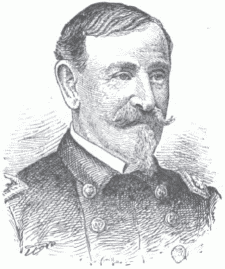 ADMIRAL SCHLEY.
ADMIRAL SCHLEY.
In 1891, he commanded the Baltimore, stationed at Valparaiso. One day, a party of his sailors who had gone on shore for pleasure, were attacked by a mob. Two of them were killed and the rest were made prisoners.
Captain Schley boldly went on shore and demanded the release of his men, and a sum of money for those who had been killed. As he intimated that a refusal would be followed by a bombardment from the guns of his vessel, the demand was granted. [Pg 219]
Such was the man that the government had selected to command the Flying Squadron.
The other fleet was much larger, and was called the North Atlantic Squadron. It was composed of great battleships, monitors, cruisers, and torpedo-boats. This squadron was to blockade the ports of Cuba in order to prevent any foreign vessel from bringing aid to the Spanish soldiers.
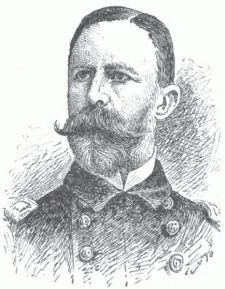 ADMIRAL SAMPSON.
ADMIRAL SAMPSON.
This fleet was under the command of Captain William T. Sampson, who was also made a rear admiral a little later in the war. The government could well trust this important duty to Admiral Sampson. Graduating from Annapolis in 1861, he had served through the Civil War, and afterward, step by step, had won promotion.
During these years he had seen service in both the Pacific and Atlantic Oceans, and had occupied many responsible positions in the Navy Department [Pg 220] on shore. He had also been one of the committee that had investigated the loss of the battleship Maine.
All this had prepared him for the great task of commanding the North Atlantic Squadron. The prudence and judgment with which he performed this duty proved that the government had made a wise selection.
The people of America were still rejoicing over the victory at Manila, when the news came that the Spanish admiral, Cervera, with four of the finest cruisers in the world, and three of the latest kind of torpedo boat destroyers, had sailed from the Canary Islands for the United States. This caused some alarm, and wild reports were spread as to what these vessels might do. Admiral Sampson, with his fleet, was guarding the West Indian waters, and Commodore Schley, with his Flying Squadron, was waiting at Hampton Roads in case Admiral Cervera should sail north. If the Spanish admiral could evade these fleets, he might bombard the cities on the Atlantic coast. [Pg 221]
In the meanwhile, the greatest anxiety was felt for the United States battleship Oregon. When the Maine was destroyed, this vessel was at the Mare Island Navy Yard near San Francisco. Before war was declared she had been ordered to join the squadron of Admiral Sampson as soon as possible.
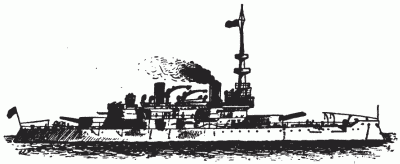 THE OREGON.
THE OREGON.
To do this she must travel through fourteen thousand miles of stormy sea, through the dangerous passage around Cape Horn and then up the eastern shore of South America.
On the 14th of March, commanded by Captain Clark, she sailed from San Francisco, entering the straits of Magellan on the 17th of April. On [Pg 222] the same day that Admiral Dewey reached the Philippines, the Oregon arrived at Rio de Janeiro, Brazil.
Every American was full of anxiety for the great battleship. Surely Admiral Cervera would arrive in the West Indian waters before the Oregon could pass through them. But swiftly and steadily the great ship came on.
Finally, on the 24th of May, the Oregon sighted the harbor lights of Key West, and soon reached a safe port. The very next day, Captain Clark reported her ready for duty. She had steamed the length of two oceans and not a valve was broken nor a repair needed.
Much praise is due to Captain Clark for bringing his vessel such a distance in desperate haste in order to help fight the nation's battles. But we must not forget that it was the chief engineer, Robert W. Milligen, and his seventy men, who made this possible. In spite of the terrible heat in the engine rooms, these brave fellows worked untiringly to keep the great ship moving steadily day and night around the continent. [Pg 223]
 MAP OF HARBOR OF SANTIAGO DE CUBA.
MAP OF HARBOR OF SANTIAGO DE CUBA.
Meanwhile, on the 11th of May, an unfortunate affair had occurred in the harbor of Cardenas, on the northern coast of Cuba. Three of the American vessels blockading this harbor had been ordered to explore the bay. Suddenly the Spanish batteries on the shore opened fire. The torpedo boat Winslow, being nearest the shore, received most of the enemy's shells. Although bravely returning the fire, the little boat was soon disabled. Five men were wounded, and Ensign Worth Bagley and four other men were killed. These were [Pg 224] the first Americans to lose their lives in this war.
On the following day, the Americans heard that the Spanish fleet had arrived at Martinique, a small French Island near the coast of Venezuela. This being known, Commodore Schley sailed from Hampton Roads for the West Indies.
On the 19th of May, Admiral Cervera sailed into the harbor of Santiago de Cuba, on the southern coast of Cuba, and was there several days before the Americans found it out. Commodore Schley hastened at once to the mouth of the harbor so as to cut off all hope of escape for the Spanish admiral. Admiral Sampson soon arrived with the main squadron, and the entire fleet kept watch, frequently bombarding the forts at the harbor's mouth.
The Americans did not attempt to pass into the harbor, as the entrance was strongly protected by torpedoes; so they waited for a land force to arrive, and attack the enemy from the rear. [Pg 225]
Soon after Admiral Sampson arrived off Santiago, there came to him a young lieutenant, Richmond Pearson Hobson. He had a plan which he wished to propose. He said:
"There is the collier Merrimac. Let a volunteer crew just large enough to navigate her be selected. Then, after stripping the old ship of everything valuable, let this crew run her, after dark, into the narrowest part of the channel leading to the harbor; and there let them sink her by exploding torpedoes under her. In this way we can block the harbor so that Admiral Cervera cannot in any way bring out his fleet."
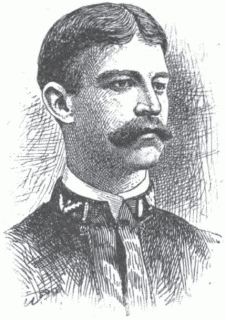 LIEUTENANT HOBSON.
LIEUTENANT HOBSON.
He explained that the crew of the Merrimac would jump overboard as she sank, and, if possible, be picked up by a torpedo-boat or a steam launch, which should be stationed near-by for that [Pg 226] purpose. Lieutenant Hobson himself, bravely offered to lead this expedition.
Admiral Sampson determined to carry out this plan, and called for a single volunteer from each ship. In spite of the danger of the undertaking, almost the entire crew of each vessel, not only offered to go, but begged to be accepted. Finally, eight men were chosen, with Lieutenant Hobson as their leader. At half-past two o'clock in the morning of June 3d, the Merrimac was headed straight for the channel. Lieutenant Hobson stood on the bridge dressed in full uniform. The other men were at their posts dressed in tights, ready to swim a long distance, if necessary.
The crew of the steam launch, which was following closely behind, saw the Merrimac swing across the channel and then heard the explosions. At the same time, the air was filled with the flash and roar of the guns of the Spanish forts and ships.
In the face of all this fire, and without even a cry of distress to guide them, the crew of the [Pg 227] launch began their search for the heroes of the Merrimac, never giving it up until daylight. Then, seeing nothing but the tops of the masts of the collier, they returned to the admiral's flagship.
Of what had happened to his men in the meantime, Lieutenant Hobson himself told afterward:
"When the boat began to sink, and the Spanish shot to fall about us, I told the men to lie flat on the deck. It was due to their splendid discipline, that we were not killed. The minutes seemed hours, but I said that we must lie there until daylight. Now and then one of the men would say, 'Hadn't we better drop off now, sir?' But I said, 'Wait until daylight.' I hoped that by that time we might be recognized and saved.
"The old Merrimac kept sinking. It was splendid the way the men behaved. The fire from the batteries and ships was dreadful. As the water came up on the decks, we caught hold of the edges of the raft which was tied to the boom, and hung on, our heads only being above water.
"A Spanish launch then came toward the Merrimac. As she drew near, the men saw us, and a [Pg 228] half-dozen marines pointed their rifles at our heads. 'Is there any officer in that boat to receive a surrender of prisoners of war?' I shouted. An old man leaned out of the launch and waved his hand. It was Admiral Cervera. The marines lowered their rifles and we were helped into the launch."
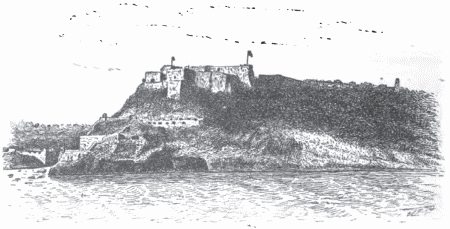 THE MORRO CASTLE, COMMANDING THE ENTRANCE OF THE HARBOR OF SANTIAGO DE CUBA.
THE MORRO CASTLE, COMMANDING THE ENTRANCE OF THE HARBOR OF SANTIAGO DE CUBA.
A few hours later, a boat bearing a flag of truce came out to the American fleet. It was from Admiral Cervera, and brought the message that Lieutenant Hobson and his men were held as [Pg 229] prisoners, and that they were well, only two of them being slightly wounded.
Much honor is due to Lieutenant Hobson for this brave deed. But we must not forget that the lives of the crew were saved through the kindness and nobility of Admiral Cervera. Not every commander would so honor his brave prisoners, and his action has been much appreciated in America.
The sinking of the Merrimac did not obstruct the channel completely. The steering gear was broken by some of the Spanish shot, and Lieutenant Hobson was not able to place the vessel exactly where he had intended. However, it would be a dangerous undertaking for the Spanish admiral to pass out of the harbor at night.
Admiral Sampson sent word to the War Department, that, if an army were sent to assist him on land, they could take the city of Santiago, together with the fleet of Admiral Cervera in the harbor. Accordingly General Shafter, with a large army, landed near Santiago and began to drive the Spaniards back into the city.
Desperate battles were fought at Siboney, El [Pg 230] Caney, and San Juan, but the Americans steadily drove the enemy inside the fortifications of Santiago. During these attacks, the fleets helped the army by throwing shells into the city.
On Sunday morning, July 3d, the American ships were lying quietly outside the harbor of Santiago. They were stretched in a line from Commodore Schley's flagship, the Brooklyn, seven miles eastward, where Admiral Sampson had gone with his flagship New York, in order to confer with General Shafter.
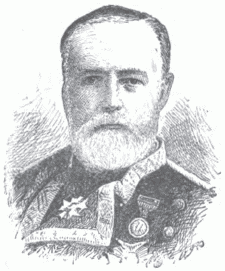 ADMIRAL CERVERA.
ADMIRAL CERVERA.
From the forts on the shore, the great ships looked like mere specks upon the horizon; and it was hard to realize that they were grim sentinels watching every movement of the Spaniards.
The "bright work" had all been cleaned and [Pg 231] the men were at Sunday services, when suddenly a thin film of smoke was observed to rise behind the hills. The scene on the battleships was changed at once into one of greatest activity.
"The enemy is coming out!" was signaled in red, white, and blue from vessel to vessel, and on each deck rang out the command, "All hands clear ship for action!"
There was no confusion or noise, and every man was at his post. Powder magazines were opened, and shot and shell were being hoisted to the decks. The engineers stood waiting for the first command with every rod and wheel of the great machinery ready to move.
Meanwhile the film of smoke had become a thick cloud, and the Americans knew that soon the Spanish vessels would appear. Suddenly the flagship of the Spanish admiral was seen speeding out of the narrow channel. She passed the wreck of the Merrimac, and with the spray dashing high over her bows, started westward along the coast.
Close behind her came another vessel, and then another, until the six Spanish ships were all rushing [Pg 232] wildly for the open sea. At full speed, the Brooklyn, Texas, Iowa, and Oregon bore down upon the Spanish ships. The Oregon gained headway so rapidly that she passed the Texas and the Iowa, and came in behind the Brooklyn.
Away to the right between the battleships and the shore, sped the little yacht Gloucester. Her captain, Lieutenant Richard Wainwright, had been an officer on the Maine when that vessel was blown up in Havana harbor, and so was, perhaps, most anxious of all for a chance at the Spanish.
He sent the Gloucester straight towards the Spanish torpedo boats, Pluton and Furor. He did not seem to mind the fact that his little yacht was no match for them, and that his decks were covered with Spanish shell. Although aided to some extent by the large vessels, the destruction of the two torpedo boats was due to Lieutenant Wainwright. He never paused in his deadly fire until both of them had surrendered. It was not long, however, until the Spanish shots began to fall about the other American ships, throwing up great columns of water. [Pg 233]
The Brooklyn was the first to reach the Spanish ships and open fire. The Oregon hastened to assist Commodore Schley. When the Americans saw that not only the Oregon, but the Texas and Iowa were gaining on the Spanish, they were wild with excitement. The stokers in the engine rooms poured in the coal, and the steam rose higher and higher.
At half-past ten the battle was at its height. Great clouds of smoke settled over the water, and the roar of the guns echoed back from the Santiago hills. Now and then anxious inquiry passed from one American crew to another; but the answer, "All right!" always came back through the din of battle.
One by one the Spanish guns became silent, and by eleven o'clock all save one of the enemy's ships had been driven ashore, and destroyed. The Cristobal Colon made a desperate dash for freedom, and was not overtaken until she had gone fifty miles west of Santiago. Then she surrendered, having been forced ashore.
After the battle was over the Americans bravely [Pg 234] went to the rescue of the Spanish sailors. They climbed the ladders and went into the burning ships, where magazines were likely to explode at any moment. They lifted the wounded men from the hot decks and took them out of the stifling smoke to their own vessels. Their boats picked up the Spaniards who were struggling in the water or trying to climb up on the shore.
The Spanish loss on that Sunday was about three hundred killed and one hundred and fifty wounded, while nearly a thousand men were taken prisoners by the Americans. The Spanish vessels were all complete wrecks. There was but one American killed and one wounded.
Admiral Cervera was a brave man. He took his fleet out of the Santiago harbor against his own judgment, because he had been ordered to do so by the Spanish government at Madrid.
Everything was against him. Many of his officers had been given their commissions because their families were rich and powerful in Spain. The sailors had not entered the navy from choice, but had been forced to do so by the government. [Pg 235] Many of them had been kidnapped from their homes, or from the wharves of seaport towns, and forced on board. They were ill treated and poorly paid. On the morning of the battle at Santiago they were threatened with pistols before they would go out to meet the Americans.
On the other hand, every man in the American fleet had been thoroughly trained for the work that he had to do, and was fighting for a country which he loved better than life itself. He felt that it was an honor to serve in the navy, and knew that many of his countrymen would be glad to be in his place.
Now let us see what has become of Lieutenant Hobson and his men. During all this time they had been held as prisoners in Santiago. Three days after the destruction of the Spanish fleet, arrangements were made to exchange them for some Spanish prisoners. This exchange was made between the Spanish and American lines near Santiago.
When the formalities were over and Hobson and his men approached the first American line, all [Pg 236] the men cheered wildly and crowded one upon another for a chance to shake hands with the heroes. Lieutenant Hobson was the hero of the hour. He alone was calm, and he modestly said that any other man would have done the same thing in his place.
After the loss of Admiral Cervera's fleet, every one knew that it would be only a question of time until the city of Santiago must surrender. The American army under General Miles and General Shafter surrounded the city on the land, while the navy guarded the harbor. The Spaniards could not escape, nor could any help reach them.
The next two weeks were spent in trying to fix upon terms of surrender that would be acceptable to both sides. The only fighting was a short bombardment of the city by the warships on the 10th of July.
At last on July 17th the city surrendered. The Spaniards agreed to give up not only Santiago but [Pg 237] also all the cities and forts east of that place, with all the soldiers and military supplies. The Americans agreed to send all these soldiers, numbering about 22,000 men, back to Spain, and pay for their transportation.
After this surrender, General Miles with an army on transport ships sailed for the island of Porto Rico, which is about four hundred miles from Cuba. As usual, the navy went along to protect the unarmed vessels and to help the army make a landing.
The first fighting was on the southern coast, near the city of Ponce, in the harbor of Guanica. Lieutenant Wainwright, with his little ship the Gloucester, sailed boldly into the harbor and drove the Spaniards from the shore. The Americans were then landed without the loss of a single man.
The army was divided into three divisions, and all set out for the city of San Juan upon the northern coast. They drove the Spaniards before them, taking possession of the towns and cities as they advanced. [Pg 238]
General Miles and his soldiers were everywhere welcomed gladly, for the people of this island did not like the Spanish soldiers any better than did the Cubans.
By the 26th of July, the people of Spain had begun to realize that it was useless to carry on the war any longer. Accordingly, word was sent to President McKinley, by the French ambassador at Washington, M. Jules Cambon, that the Spanish government was ready to consider terms of peace.
President McKinley and his cabinet at once drew up a paper called a protocol, which stated what the Spanish must do before the war could be ended.
Spain was to give up all claim to Cuba, recall her officials and soldiers, and permit the people of the island to choose their own government. Porto Rico and all the Spanish islands in the West Indies were to be given to the United States. Spain was also to allow the Americans to hold the city of Manila until it should be decided, by a regular treaty, what should be done with the Philippine Islands. Five men from each [Pg 239] country should be appointed to draw up the treaty, and in the meantime, as soon as Spain and the United States should sign the protocol, all fighting should cease.
Spain was glad to get peace, even on these terms, and the protocol was duly signed by both governments on the 12th of August. Word was at once sent to the armies and navies to cease fighting.
It was very easy to reach the American forces in Cuba and Porto Rico, but before the message could reach Admiral Dewey at Manila, it must be telegraphed to Hong Kong, China, and then sent by a dispatch boat to Manila. During the summer vessel after vessel had sailed from San Francisco, carrying the army of General Merritt to assist Admiral Dewey. War vessels and ammunition had also been sent.
On the 13th of August, not having heard that peace had been declared, General Merritt ordered a combined attack of the army and navy to be made upon Manila. The vessels opened fire upon the Spanish fortifications which protected the [Pg 240] town, while the troops of General Merritt drove the Spaniards back into the city. After two hours of sharp fighting the city surrendered.
The Americans did not lose a single sailor, and only twelve soldiers were killed and forty wounded. The Spanish loss was much greater. In the afternoon the stars and stripes were hoisted over the government building and the Spanish soldiers marched out of the city and laid down their arms.
Thus with a brilliant victory, Admiral Dewey closed the war as he had opened it.
After the signing of the protocol Admiral Sampson and Commodore Schley sailed to New York with most of their squadrons to repair what little damage had been done. When they arrived on the 20th of August the city gave them a royal welcome. It was arranged that the warships should steam through the harbor and up the Hudson River as far as General Grant's tomb. Thus every one could see and greet the naval heroes. The people turned out by the tens of thousands and lined the shores cheering and waving flags. The harbor and river were filled with pleasure [Pg 241] boats adorned with flags and streamers, while cannon on the shore thundered salutes.
In all history there is not an instance of such great victories with so small a loss of men and ships as in this war with Spain. In less than three months the United States had driven the Spanish power from the western hemisphere. It had added new possessions in both hemispheres and had shown that it was entitled to rank with the most powerful nations of the earth.
As soon as the people of the United States felt that peace was assured they held great jubilees in Chicago and Philadelphia. Triumphal arches were erected under which marched the heroes of the war, cheered to the echo by their fellow citizens.
Several new battleships more powerful than any that had taken part in the recent splendid victories were launched, with imposing ceremonies, at Newport News, Virginia.
From all this it would seem that the people of the United States at last realized that at all times, whether in peace or war, the country should have [Pg 242] a powerful navy. This navy should be in keeping with the position that the United States has won among the nations of the world, and worthy of the brave officers and sailors who spend their lives in its service.
When a battleship is hurling shot and shell at an enemy, the brave deeds of the officers and men on board are told from one end of the land to the other; but how many people know how these men live from day to day, when the great ship is lying in the harbor, or cruising peacefully about the seas?
Who makes the lieutenant's bed and buys his food? Most people think that the government provides all that he needs; but this is not so. He must carry his own bed linen to sea with him and arrange for his own food.
The officers choose one of their number to buy the provisions, and he must give good meals at one dollar a day for each man. At the end of [Pg 243] the month, every officer pays this amount out of his salary.
The first meal of the day is always eggs, and is served at any time from 7:30 until 8:30 in the morning. If ever a naval officer invites you to breakfast, he does not expect you to come to this meal. He calls a twelve o'clock luncheon breakfast, and will give you a substantial meal at that time. Dinner is served at 6 or 6:30, and, on the flagship, is accompanied by the band.
The ward-room boys who wait upon the officers are almost all Japanese. Because their names are so hard to pronounce, every one is called "William." When the big ship is hurling shot and shell in time of battle, where is William? In the pantry washing dishes? No, indeed.
Somebody must be down in the magazine putting the powder on the hoists which carry it up to the guns. This is William's work. In time of fire, it is he who holds the nozzle of the hose, or who brings hammocks to smother the flames.
Now "Jacky," as the sailor man is called, does not provide his food or his bed-linen. His bed is [Pg 244] a hammock, and it is a very different one from those we swing on our porches in summer. It is made of canvas, with ropes in the ends. He has a mattress and a blanket in his bed, and he always keeps them there.
At five o'clock in the morning the bugle calls, and Jacky has six minutes in which to scramble out of his bed and get into his clothes. Then he must roll up his hammock and stow it away. Jacky then has some hard tack and coffee before he goes to work.
From half-past five until six he does his laundry work. He wears white suits and must wash them himself; untidiness is never excused. The clothes are then hung so as to be dry for the inspection drill which will come at half-past nine.
Then for one hour, the ship is scrubbed. Water pours over the decks in streams. Every nook and cranny is numbered, and each man has his own number to keep clean.
By half-past seven there is nothing cleaner on land or sea. The ship shines from prow to stern, and the decks are clean enough to eat from. [Pg 245] Every piece of metal is polished until it glitters in the sunlight.
When this is finished, Jacky has his breakfast. The government allows thirty cents a day for the rations of each sailor. The paymaster serves out food enough to last several days or sometimes a week, and if the cook does not make this last the crew must go hungry.
The sailors are divided into "messes," each mess having its own cook who is under the direction of the general ship's cook. Jacky has no table-cloth or napkins. He washes his own tin plate, cup, knife, fork, and spoon, when he has finished his hasty meal.
At eight o'clock, he is dressed for the day, and the colors go up. From then until six o'clock in the evening he is busy with different drills and duties about the ship. In the evening, from six until eight o'clock, Jacky has an easy time. It is then that he takes his ease, smoking his pipe and singing his songs.
At nine o'clock "taps" are sounded, and once more he rolls up in his hammock for the night. [Pg 246]
Saturday is mending day, and every man must do his own work. Some of the men make their own clothes, although there is a tailor on board. In the ship's crew there are also barbers, shoemakers, and printers.
On Sunday morning, the captain goes about the ship and gravely inspects the men, and it is then that each one tries to look his best. Then they must all attend religious services, after which they rest most of the day.
The marines on a ship-of-war are men about whom most people know nothing. A marine is not a sailor. He is a soldier who does duty on a warship. He is a kind of policeman, and sees that Jacky behaves himself. He wears a soldier's uniform and has soldier's drills.
The marines have their own mess and their own sleeping space, forming a community of their own.
Perhaps some boys and girls may think that the captain and his officers have a much easier time than Jacky or the marines. This is not so. In the first place, they had many studies to [Pg 247] master before they could be officers. They had to earn a great deal about mathematics, mechanical and electrical engineering, navigation, gunnery, and international law. And then these studies are never ended; the progress that is made in them, each year all over the world, must be known by each officer.
The officers are responsible for the lives of the crew and the safety of the ship. They must be ready to think and act quickly in emergencies. In hours of peril they never leave their posts.
The Constitution of the United States provides that the President shall be commander-in-chief not only of the army but also of the navy. His chief assistant in the management of naval affairs is the Secretary of the Navy, who is also a member of his cabinet.
In 1898 the Navy Department of the United [Pg 248] States was just one hundred years old, having been organized in 1798 with Benjamin Stoddert as Secretary.
The work of the department is divided among eight bureaus, as follows:
1. The Bureau of Yards and Docks, which is intrusted with the construction and maintenance of docks and wharves, and with all civil engineering work in the navy yards.
2. The Bureau of Navigation, which superintends the education of officers and men, controls the enlistment of men and apprentices, and directs the movements of ships and fleets.
3. The Bureau of Equipment, which attends to the manufacture of ropes, anchors, cables, and other articles required for the equipment of naval vessels, purchases coal for their use, and controls the Naval Observatory.
4. The Bureau of Ordnance, which has charge of the manufacture of guns and ammunition, also of torpedo stations and magazines.
5. The Bureau of Construction and Repair, which is charged with the building and repair of [Pg 249] small boats and of the hulls of ships, and attends to the purchase of turrets and armor.
6. The Bureau of Steam Engineering, which directs the building and repairing of machinery in any way connected with the ships.
7. The Bureau of Medicine and Surgery, which designs, erects, and maintains naval hospitals and superintends their management.
8. The Bureau of Supplies and Accounts, which is responsible for the purchase and supply of all provisions and stores, and of the accounts relating to the same.
Each of these bureaus is presided over by an officer of skill and experience, who, while he holds the office, has the rank of commodore.
The United States has navy yards at Portsmouth, New Hampshire; Boston, Massachusetts; Brooklyn, New York; League Island, Pennsylvania; Norfolk, Virginia; Washington, District of Columbia; and Mare Island, California. At these navy yards ships are overhauled and repaired, machinery is adjusted and renewed, and stores of all kinds are provided. Here, too, on the [Pg 250] receiving ships, the recruits are received and instructed.
There are naval stations at Newport, Rhode Island; New London, Connecticut; Port Royal, South Carolina; Key West and Pensacola, Florida; and Puget Sound, Washington.
At Indian Head, Maryland, is the naval proving-ground for the test of armor and guns.
The Naval Observatory is at Washington, and was at first merely a depot for naval charts and instruments.
In 1898, the highest officer in the American navy was the rear admiral. The other officers in their order, ranking downward, were commodores, captains, commanders, lieutenant commanders, lieutenants, lieutenants junior grade, and ensigns. All these are known as officers of the line.
At the close of the year there were seven rear admirals, ten commodores, forty-one captains, and eighty-five commanders.
The rank of rear admiral is equal to that of major general in the army. A commodore is equal to a brigadier general; a captain in the navy ranks [Pg 251] with a colonel in the army; a commander ranks with a lieutenant colonel; and a lieutenant in the navy is equal to a captain in the army.
The law provides that when an officer reaches the age of sixty-two years he must be retired from active service. One who has been disabled in the service, or who has served honorably for forty years and requests release, may also be retired. Officers on the retired list receive three-fourths as much pay as when on active duty at sea.
Rear Admiral Dewey will be retired on the 26th of December, 1899. In 1898 there were thirty-three rear admirals on the retired lists.
The officers while at sea receive more pay than when on shore duty. The salary of an ensign at sea is $1200 a year; that of a rear admiral is $6,000. The salaries of the other officers range between these two extremes.
Previous to 1898 the number of enlisted men in the navy was limited to ten thousand. These men are received for a period of three years; and any one after serving continuously for twenty years may be assigned to duty in the navy yards, or on board [Pg 252] receiving ships, or to other duties not requiring them to go far from home. All who have served thirty years are entitled to admittance in the Naval Home. The wages of enlisted men vary from $16 to $70 a month, according to the kind of work they perform.
The law provides that seven hundred and fifty boys may be enlisted as apprentices in the navy. These are received only with the consent of their parents or guardians, and are required to serve until they are twenty-one years old.
Besides the regular navy of the United States there is a naval militia organized in eighteen states. This militia is under the general direction of the Assistant Secretary of the Navy; and its duty in time of war is to man the vessels designed for coast and harbor defense.
At the beginning of the year 1898 there were more than four thousand men and officers in the naval militia. During the war with Spain, most of these were mustered into the naval service and did duty on the war vessels or in the signal service along the coast. [Pg 253]
At the close of the year there were belonging to our government nine battleships, all of which had been built since 1890. Four others were in process of construction. The average cost of vessels of this class is about $3,500,000.
Of other vessels in the navy of 1898, there were two armored cruisers which cost $2,986,000 each; one ram, the Katahdin; six double turreted monitors; thirteen single turreted monitors; seventeen protected cruisers; four unarmored cruisers; fifteen gunboats; and ten torpedo boats. Many other vessels of different classes were being built.
All these were in active service, or soon to be so. But there were also several other vessels of the old-fashioned style which, although of little use in battle, were valuable in the various peaceful enterprises in which the navy is always engaged. Of such there were six old iron vessels and ten wooden frigates, all propelled by steam, and seventeen old wooden sailing vessels, some of which were used as receiving ships.
During the war with Spain, many temporary additions were made to the navy. Eleven merchant [Pg 254] vessels were bought or leased and converted into auxiliary cruisers. Among these were the four fast steamers of the American line, the St. Louis, the St. Paul, the Yale, and the Harvard.
Twenty-eight yachts also were purchased and turned into auxiliary gunboats or torpedo boats. Among these was the Gloucester, which did such fine work during the destruction of Cervera's fleet. It had formerly been a pleasure yacht belonging to Mr. J. Pierpont Morgan of New York.
In addition to the vessels just named, the government also bought twenty-seven tugs to be changed into gunboats or cruisers; and it obtained seventeen steam vessels of various sizes to be used as transports and for many other purposes.
Altogether the navy of 1898 comprised an imposing collection of vessels of many kinds and of various degrees of efficiency. Of the work which it accomplished we have already learned. [Pg 255]
THE
FOUR GREAT AMERICANS SERIES
Biographical Stories of Great Americans
for Young Americans
EDITED BY
James Baldwin, Ph.D.
In these biographical stories the lives of great Americans are presented in such a manner as to hold the attention of the youngest reader. In these lives the child finds the most inspiring examples of good citizenship and true patriotism.

VOLUMES NOW READY:
I. FOUR GREAT AMERICANS
George Washington, Benjamin Franklin, Daniel Webster, Abraham Lincoln.
By JAMES BALDWIN, Ph.D.
| Cloth, 246 pages. | Price, 50 cents |
II. FOUR AMERICAN PATRIOTS
Patrick Henry, Alexander Hamilton, Andrew Jackson, U.S. Grant.
By ALMA HOLMAN BURTON
Author of The Story of Our Country, etc.
| Cloth, 256 pages. | Price, 50 cents |
III. FOUR AMERICAN NAVAL HEROES
Paul Jones, Oliver H. Perry, Admiral Farragut, Admiral Dewey.
By MABEL BORTON BEEBE
| Cloth, 254 pages. | Price, 50 cents |
OTHER VOLUMES IN PREPARATION
Copyright, 1899, by WERNER SCHOOL BOOK COMPANY
The Lakeside Press
R.R. DONNELLEY & SONS COMPANY
CHICAGO
THE BOOK OF THE HOUR for THE YOUTH OF AMERICA....Just Published.
Lafayette,
The
Friend of American Liberty
The proposal to erect a monument in Paris to the early friend of American liberty, GENERAL LAFAYETTE, by contributions from the patriotic school children of the United States, has aroused national enthusiasm for the memory of this noble man....
In view of the great interest which this fitting and significant movement has awakened in the life, character and services of the heroic soldier and patriot, the Werner School Book Company has just issued, edited by Dr. James Baldwin,
"LAFAYETTE, THE FRIEND OF AMERICAN LIBERTY,"
By Mrs. ALMA HOLMAN BURTON,
| The author of | "Four American Patriots," |
| "The Story of Our Country," Etc. |
A TIMELY CONTRIBUTION OF GREAT VALUE
TO PATRIOTIC EDUCATIONAL LITERATURE.
Werner School Book
... Company ...
CHICAGO: 378-388 Wabash Ave.
NEW YORK: 78 Fifth Ave.
BOSTON: 73 Tremont St.
Educational Publishers.
[Pg 256]
EPOCH-MAKING BOOKS
TITLES OF SOME EPOCH-MAKING BOOKS, WITH PRICES AT WHICH THEY WILL BE MAILED, POSTPAID:
| The Werner Arithmetic, Book I. (Hall) | $ 40 |
| The Werner Arithmetic, Book II. (Hall) | 40 |
| The Werner Arithmetic, Book III. (Hall) | 50 |
| Teacher's Hand-Book to the Werner Arithmetics | 25 |
| Hall's Elementary Arithmetic | 35 |
| Hall's Complete Arithmetic | 60 |
| DeGarmo's Language Lessons, Book I | 30 |
| DeGarmo's Language Lessons, Book II | 40 |
| DeGarmo's Complete Language Lessons (One-Book Course) | 50 |
| Brown and DeGarmo's Elements of English Grammar | 60 |
| The Werner Introductory Geography (Tarbell) | 55 |
| The Werner Grammar School Geography, Parts I. and II. (Tarbell) | 1 40 |
| Baldwin's Primary Lessons in Physiology and Hygiene | 35 |
| Baldwin's Essential Lessons in Physiology and Hygiene | 50 |
| Baldwin's Advanced Lessons in Physiology and Hygiene | 80 |
| The Werner Primer (Taylor) | 30 |
| First Year Nature Reader (Beebe and Kingsley) | 35 |
| Old Time Stories Retold (Smythe) | 30 |
| Legends of the Red Children (Pratt) | 30 |
| Baldwin's Biographical Booklets (each) | 10 |
| Baldwin's Four Great Americans | 50 |
| Burton's Four American Patriots | 50 |
| Beebe's Four American Naval Heroes | 50 |
| Cody's Four American Poets | 50 |
| Winship's Great American Educators | 50 |
| Burton's Lafayette, the Friend of American Liberty | 35 |
| Burton's Story of Our Country | 60 |
| The Werner Mental Arithmetic | 30 |
| Giffin's Grammar School Algebra | 50 |
| Adams's Physical Laboratory Manual | 75 |
| Hinsdale's Studies in Education | 1 00 |
| Hinsdale's Training for Citizenship | 10 |
| Hinsdale's American Government | 1 25 |
| Hinsdale's History and Civil Government of Ohio | 1 00 |
| Barnard's History and Civil Government of Missouri | 1 00 |
| Lewis's History and Civil Government of West Virginia | 1 00 |
| Niles's History and Civil Government of Minnesota | 1 00 |
| Seerley and Parish's History and Civil Gov't of Iowa | 1 00 |
| Smith and Young's History and Civil Government of South Dakota | 1 00 |
| Stetson's History and Civil Government of Maine | 1 00 |
| Beebe's First School Year | 75 |
| Jackman's Nature Study Record | 60 |
OTHER EPOCH-MAKING BOOKS IN PREPARATION
WERNER SCHOOL BOOK COMPANY
Educational Publishers
NEW YORK CHICAGO BOSTON
Transcriber's notes:
End of Project Gutenberg's Four American Naval Heroes, by Mabel Beebe
*** END OF THIS PROJECT GUTENBERG EBOOK FOUR AMERICAN NAVAL HEROES ***
***** This file should be named 36581-h.htm or 36581-h.zip *****
This and all associated files of various formats will be found in:
http://www.gutenberg.org/3/6/5/8/36581/
Produced by Heather Clark, paksenarrion and the Online
Distributed Proofreading Team at http://www.pgdp.net (This
book was produced from scanned images of public domain
material from the Google Print project.)
Updated editions will replace the previous one--the old editions
will be renamed.
Creating the works from public domain print editions means that no
one owns a United States copyright in these works, so the Foundation
(and you!) can copy and distribute it in the United States without
permission and without paying copyright royalties. Special rules,
set forth in the General Terms of Use part of this license, apply to
copying and distributing Project Gutenberg-tm electronic works to
protect the PROJECT GUTENBERG-tm concept and trademark. Project
Gutenberg is a registered trademark, and may not be used if you
charge for the eBooks, unless you receive specific permission. If you
do not charge anything for copies of this eBook, complying with the
rules is very easy. You may use this eBook for nearly any purpose
such as creation of derivative works, reports, performances and
research. They may be modified and printed and given away--you may do
practically ANYTHING with public domain eBooks. Redistribution is
subject to the trademark license, especially commercial
redistribution.
*** START: FULL LICENSE ***
THE FULL PROJECT GUTENBERG LICENSE
PLEASE READ THIS BEFORE YOU DISTRIBUTE OR USE THIS WORK
To protect the Project Gutenberg-tm mission of promoting the free
distribution of electronic works, by using or distributing this work
(or any other work associated in any way with the phrase "Project
Gutenberg"), you agree to comply with all the terms of the Full Project
Gutenberg-tm License (available with this file or online at
http://gutenberg.org/license).
Section 1. General Terms of Use and Redistributing Project Gutenberg-tm
electronic works
1.A. By reading or using any part of this Project Gutenberg-tm
electronic work, you indicate that you have read, understand, agree to
and accept all the terms of this license and intellectual property
(trademark/copyright) agreement. If you do not agree to abide by all
the terms of this agreement, you must cease using and return or destroy
all copies of Project Gutenberg-tm electronic works in your possession.
If you paid a fee for obtaining a copy of or access to a Project
Gutenberg-tm electronic work and you do not agree to be bound by the
terms of this agreement, you may obtain a refund from the person or
entity to whom you paid the fee as set forth in paragraph 1.E.8.
1.B. "Project Gutenberg" is a registered trademark. It may only be
used on or associated in any way with an electronic work by people who
agree to be bound by the terms of this agreement. There are a few
things that you can do with most Project Gutenberg-tm electronic works
even without complying with the full terms of this agreement. See
paragraph 1.C below. There are a lot of things you can do with Project
Gutenberg-tm electronic works if you follow the terms of this agreement
and help preserve free future access to Project Gutenberg-tm electronic
works. See paragraph 1.E below.
1.C. The Project Gutenberg Literary Archive Foundation ("the Foundation"
or PGLAF), owns a compilation copyright in the collection of Project
Gutenberg-tm electronic works. Nearly all the individual works in the
collection are in the public domain in the United States. If an
individual work is in the public domain in the United States and you are
located in the United States, we do not claim a right to prevent you from
copying, distributing, performing, displaying or creating derivative
works based on the work as long as all references to Project Gutenberg
are removed. Of course, we hope that you will support the Project
Gutenberg-tm mission of promoting free access to electronic works by
freely sharing Project Gutenberg-tm works in compliance with the terms of
this agreement for keeping the Project Gutenberg-tm name associated with
the work. You can easily comply with the terms of this agreement by
keeping this work in the same format with its attached full Project
Gutenberg-tm License when you share it without charge with others.
1.D. The copyright laws of the place where you are located also govern
what you can do with this work. Copyright laws in most countries are in
a constant state of change. If you are outside the United States, check
the laws of your country in addition to the terms of this agreement
before downloading, copying, displaying, performing, distributing or
creating derivative works based on this work or any other Project
Gutenberg-tm work. The Foundation makes no representations concerning
the copyright status of any work in any country outside the United
States.
1.E. Unless you have removed all references to Project Gutenberg:
1.E.1. The following sentence, with active links to, or other immediate
access to, the full Project Gutenberg-tm License must appear prominently
whenever any copy of a Project Gutenberg-tm work (any work on which the
phrase "Project Gutenberg" appears, or with which the phrase "Project
Gutenberg" is associated) is accessed, displayed, performed, viewed,
copied or distributed:
This eBook is for the use of anyone anywhere at no cost and with
almost no restrictions whatsoever. You may copy it, give it away or
re-use it under the terms of the Project Gutenberg License included
with this eBook or online at www.gutenberg.org
1.E.2. If an individual Project Gutenberg-tm electronic work is derived
from the public domain (does not contain a notice indicating that it is
posted with permission of the copyright holder), the work can be copied
and distributed to anyone in the United States without paying any fees
or charges. If you are redistributing or providing access to a work
with the phrase "Project Gutenberg" associated with or appearing on the
work, you must comply either with the requirements of paragraphs 1.E.1
through 1.E.7 or obtain permission for the use of the work and the
Project Gutenberg-tm trademark as set forth in paragraphs 1.E.8 or
1.E.9.
1.E.3. If an individual Project Gutenberg-tm electronic work is posted
with the permission of the copyright holder, your use and distribution
must comply with both paragraphs 1.E.1 through 1.E.7 and any additional
terms imposed by the copyright holder. Additional terms will be linked
to the Project Gutenberg-tm License for all works posted with the
permission of the copyright holder found at the beginning of this work.
1.E.4. Do not unlink or detach or remove the full Project Gutenberg-tm
License terms from this work, or any files containing a part of this
work or any other work associated with Project Gutenberg-tm.
1.E.5. Do not copy, display, perform, distribute or redistribute this
electronic work, or any part of this electronic work, without
prominently displaying the sentence set forth in paragraph 1.E.1 with
active links or immediate access to the full terms of the Project
Gutenberg-tm License.
1.E.6. You may convert to and distribute this work in any binary,
compressed, marked up, nonproprietary or proprietary form, including any
word processing or hypertext form. However, if you provide access to or
distribute copies of a Project Gutenberg-tm work in a format other than
"Plain Vanilla ASCII" or other format used in the official version
posted on the official Project Gutenberg-tm web site (www.gutenberg.org),
you must, at no additional cost, fee or expense to the user, provide a
copy, a means of exporting a copy, or a means of obtaining a copy upon
request, of the work in its original "Plain Vanilla ASCII" or other
form. Any alternate format must include the full Project Gutenberg-tm
License as specified in paragraph 1.E.1.
1.E.7. Do not charge a fee for access to, viewing, displaying,
performing, copying or distributing any Project Gutenberg-tm works
unless you comply with paragraph 1.E.8 or 1.E.9.
1.E.8. You may charge a reasonable fee for copies of or providing
access to or distributing Project Gutenberg-tm electronic works provided
that
- You pay a royalty fee of 20% of the gross profits you derive from
the use of Project Gutenberg-tm works calculated using the method
you already use to calculate your applicable taxes. The fee is
owed to the owner of the Project Gutenberg-tm trademark, but he
has agreed to donate royalties under this paragraph to the
Project Gutenberg Literary Archive Foundation. Royalty payments
must be paid within 60 days following each date on which you
prepare (or are legally required to prepare) your periodic tax
returns. Royalty payments should be clearly marked as such and
sent to the Project Gutenberg Literary Archive Foundation at the
address specified in Section 4, "Information about donations to
the Project Gutenberg Literary Archive Foundation."
- You provide a full refund of any money paid by a user who notifies
you in writing (or by e-mail) within 30 days of receipt that s/he
does not agree to the terms of the full Project Gutenberg-tm
License. You must require such a user to return or
destroy all copies of the works possessed in a physical medium
and discontinue all use of and all access to other copies of
Project Gutenberg-tm works.
- You provide, in accordance with paragraph 1.F.3, a full refund of any
money paid for a work or a replacement copy, if a defect in the
electronic work is discovered and reported to you within 90 days
of receipt of the work.
- You comply with all other terms of this agreement for free
distribution of Project Gutenberg-tm works.
1.E.9. If you wish to charge a fee or distribute a Project Gutenberg-tm
electronic work or group of works on different terms than are set
forth in this agreement, you must obtain permission in writing from
both the Project Gutenberg Literary Archive Foundation and Michael
Hart, the owner of the Project Gutenberg-tm trademark. Contact the
Foundation as set forth in Section 3 below.
1.F.
1.F.1. Project Gutenberg volunteers and employees expend considerable
effort to identify, do copyright research on, transcribe and proofread
public domain works in creating the Project Gutenberg-tm
collection. Despite these efforts, Project Gutenberg-tm electronic
works, and the medium on which they may be stored, may contain
"Defects," such as, but not limited to, incomplete, inaccurate or
corrupt data, transcription errors, a copyright or other intellectual
property infringement, a defective or damaged disk or other medium, a
computer virus, or computer codes that damage or cannot be read by
your equipment.
1.F.2. LIMITED WARRANTY, DISCLAIMER OF DAMAGES - Except for the "Right
of Replacement or Refund" described in paragraph 1.F.3, the Project
Gutenberg Literary Archive Foundation, the owner of the Project
Gutenberg-tm trademark, and any other party distributing a Project
Gutenberg-tm electronic work under this agreement, disclaim all
liability to you for damages, costs and expenses, including legal
fees. YOU AGREE THAT YOU HAVE NO REMEDIES FOR NEGLIGENCE, STRICT
LIABILITY, BREACH OF WARRANTY OR BREACH OF CONTRACT EXCEPT THOSE
PROVIDED IN PARAGRAPH 1.F.3. YOU AGREE THAT THE FOUNDATION, THE
TRADEMARK OWNER, AND ANY DISTRIBUTOR UNDER THIS AGREEMENT WILL NOT BE
LIABLE TO YOU FOR ACTUAL, DIRECT, INDIRECT, CONSEQUENTIAL, PUNITIVE OR
INCIDENTAL DAMAGES EVEN IF YOU GIVE NOTICE OF THE POSSIBILITY OF SUCH
DAMAGE.
1.F.3. LIMITED RIGHT OF REPLACEMENT OR REFUND - If you discover a
defect in this electronic work within 90 days of receiving it, you can
receive a refund of the money (if any) you paid for it by sending a
written explanation to the person you received the work from. If you
received the work on a physical medium, you must return the medium with
your written explanation. The person or entity that provided you with
the defective work may elect to provide a replacement copy in lieu of a
refund. If you received the work electronically, the person or entity
providing it to you may choose to give you a second opportunity to
receive the work electronically in lieu of a refund. If the second copy
is also defective, you may demand a refund in writing without further
opportunities to fix the problem.
1.F.4. Except for the limited right of replacement or refund set forth
in paragraph 1.F.3, this work is provided to you 'AS-IS' WITH NO OTHER
WARRANTIES OF ANY KIND, EXPRESS OR IMPLIED, INCLUDING BUT NOT LIMITED TO
WARRANTIES OF MERCHANTIBILITY OR FITNESS FOR ANY PURPOSE.
1.F.5. Some states do not allow disclaimers of certain implied
warranties or the exclusion or limitation of certain types of damages.
If any disclaimer or limitation set forth in this agreement violates the
law of the state applicable to this agreement, the agreement shall be
interpreted to make the maximum disclaimer or limitation permitted by
the applicable state law. The invalidity or unenforceability of any
provision of this agreement shall not void the remaining provisions.
1.F.6. INDEMNITY - You agree to indemnify and hold the Foundation, the
trademark owner, any agent or employee of the Foundation, anyone
providing copies of Project Gutenberg-tm electronic works in accordance
with this agreement, and any volunteers associated with the production,
promotion and distribution of Project Gutenberg-tm electronic works,
harmless from all liability, costs and expenses, including legal fees,
that arise directly or indirectly from any of the following which you do
or cause to occur: (a) distribution of this or any Project Gutenberg-tm
work, (b) alteration, modification, or additions or deletions to any
Project Gutenberg-tm work, and (c) any Defect you cause.
Section 2. Information about the Mission of Project Gutenberg-tm
Project Gutenberg-tm is synonymous with the free distribution of
electronic works in formats readable by the widest variety of computers
including obsolete, old, middle-aged and new computers. It exists
because of the efforts of hundreds of volunteers and donations from
people in all walks of life.
Volunteers and financial support to provide volunteers with the
assistance they need, are critical to reaching Project Gutenberg-tm's
goals and ensuring that the Project Gutenberg-tm collection will
remain freely available for generations to come. In 2001, the Project
Gutenberg Literary Archive Foundation was created to provide a secure
and permanent future for Project Gutenberg-tm and future generations.
To learn more about the Project Gutenberg Literary Archive Foundation
and how your efforts and donations can help, see Sections 3 and 4
and the Foundation web page at http://www.pglaf.org.
Section 3. Information about the Project Gutenberg Literary Archive
Foundation
The Project Gutenberg Literary Archive Foundation is a non profit
501(c)(3) educational corporation organized under the laws of the
state of Mississippi and granted tax exempt status by the Internal
Revenue Service. The Foundation's EIN or federal tax identification
number is 64-6221541. Its 501(c)(3) letter is posted at
http://pglaf.org/fundraising. Contributions to the Project Gutenberg
Literary Archive Foundation are tax deductible to the full extent
permitted by U.S. federal laws and your state's laws.
The Foundation's principal office is located at 4557 Melan Dr. S.
Fairbanks, AK, 99712., but its volunteers and employees are scattered
throughout numerous locations. Its business office is located at
809 North 1500 West, Salt Lake City, UT 84116, (801) 596-1887, email
business@pglaf.org. Email contact links and up to date contact
information can be found at the Foundation's web site and official
page at http://pglaf.org
For additional contact information:
Dr. Gregory B. Newby
Chief Executive and Director
gbnewby@pglaf.org
Section 4. Information about Donations to the Project Gutenberg
Literary Archive Foundation
Project Gutenberg-tm depends upon and cannot survive without wide
spread public support and donations to carry out its mission of
increasing the number of public domain and licensed works that can be
freely distributed in machine readable form accessible by the widest
array of equipment including outdated equipment. Many small donations
($1 to $5,000) are particularly important to maintaining tax exempt
status with the IRS.
The Foundation is committed to complying with the laws regulating
charities and charitable donations in all 50 states of the United
States. Compliance requirements are not uniform and it takes a
considerable effort, much paperwork and many fees to meet and keep up
with these requirements. We do not solicit donations in locations
where we have not received written confirmation of compliance. To
SEND DONATIONS or determine the status of compliance for any
particular state visit http://pglaf.org
While we cannot and do not solicit contributions from states where we
have not met the solicitation requirements, we know of no prohibition
against accepting unsolicited donations from donors in such states who
approach us with offers to donate.
International donations are gratefully accepted, but we cannot make
any statements concerning tax treatment of donations received from
outside the United States. U.S. laws alone swamp our small staff.
Please check the Project Gutenberg Web pages for current donation
methods and addresses. Donations are accepted in a number of other
ways including checks, online payments and credit card donations.
To donate, please visit: http://pglaf.org/donate
Section 5. General Information About Project Gutenberg-tm electronic
works.
Professor Michael S. Hart is the originator of the Project Gutenberg-tm
concept of a library of electronic works that could be freely shared
with anyone. For thirty years, he produced and distributed Project
Gutenberg-tm eBooks with only a loose network of volunteer support.
Project Gutenberg-tm eBooks are often created from several printed
editions, all of which are confirmed as Public Domain in the U.S.
unless a copyright notice is included. Thus, we do not necessarily
keep eBooks in compliance with any particular paper edition.
Most people start at our Web site which has the main PG search facility:
http://www.gutenberg.org
This Web site includes information about Project Gutenberg-tm,
including how to make donations to the Project Gutenberg Literary
Archive Foundation, how to help produce our new eBooks, and how to
subscribe to our email newsletter to hear about new eBooks.